Lead and Manage Organisational Change - BSBINN601 Learner Workbook
VerifiedAdded on 2023/06/11
|57
|12562
|249
AI Summary
This BSBINN601 Learner Workbook focuses on Lead and Manage Organisational Change. It includes activities, assessments, and instructions for learners to identify strategic change needs, review existing policies and practices, and more. The workbook is designed for learners studying BSBINN601 and includes a table of contents, assessment instructions, and requirements. Learners will gain skills in reading, navigating the world of work, and getting the work done. The activities in the workbook assess aspects of all the elements, performance criteria, skills and knowledge, and performance requirements of the unit of competency.
Contribute Materials
Your contribution can guide someone’s learning journey. Share your
documents today.
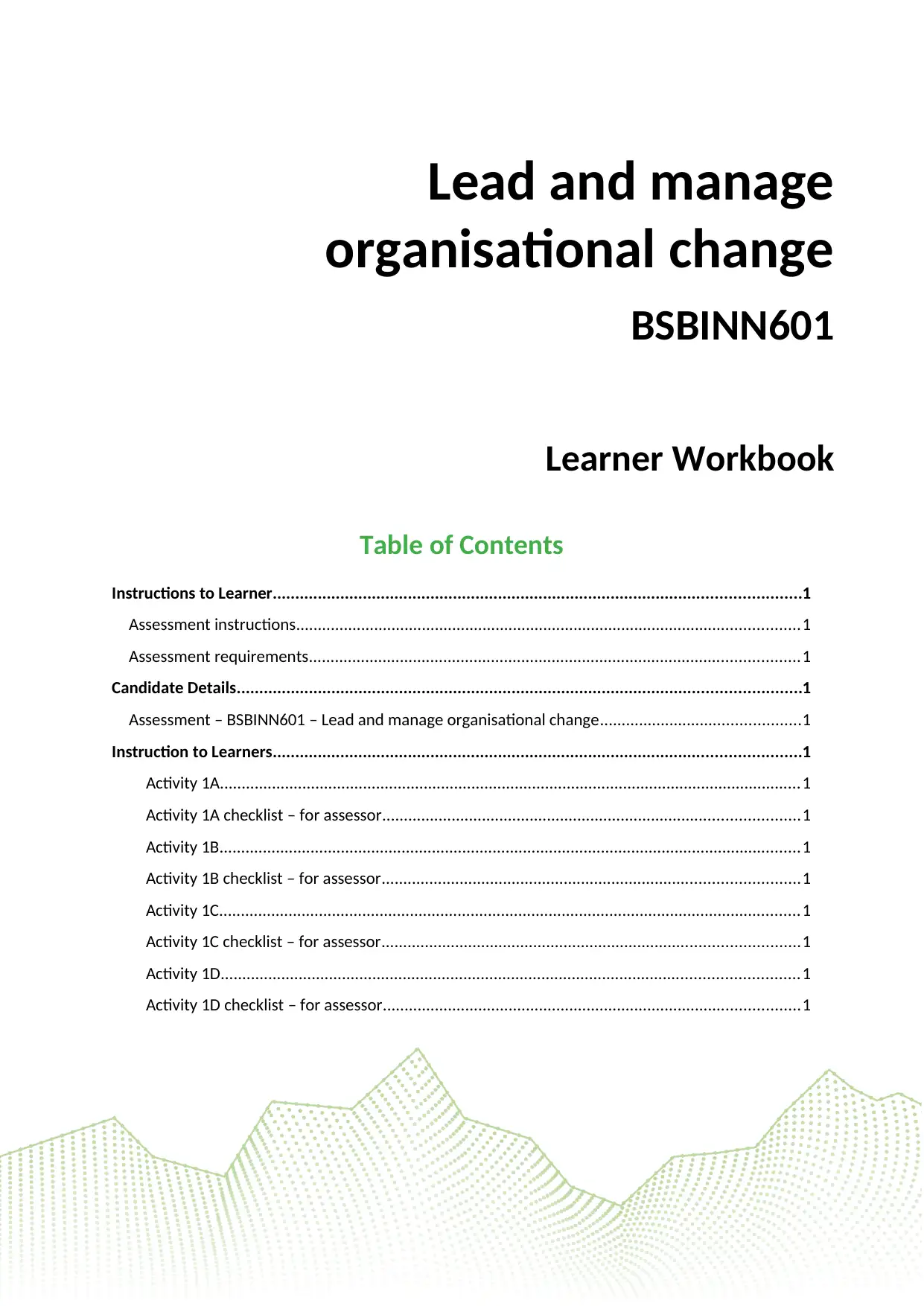
Table of Contents
Instructions to Learner.....................................................................................................................1
Assessment instructions....................................................................................................................1
Assessment requirements.................................................................................................................1
Candidate Details.............................................................................................................................1
Assessment – BSBINN601 – Lead and manage organisational change..............................................1
Instruction to Learners.....................................................................................................................1
Activity 1A......................................................................................................................................1
Activity 1A checklist – for assessor................................................................................................1
Activity 1B......................................................................................................................................1
Activity 1B checklist – for assessor................................................................................................1
Activity 1C......................................................................................................................................1
Activity 1C checklist – for assessor................................................................................................1
Activity 1D.....................................................................................................................................1
Activity 1D checklist – for assessor................................................................................................1
Lead and manage
organisational change
BSBINN601
Learner Workbook
Instructions to Learner.....................................................................................................................1
Assessment instructions....................................................................................................................1
Assessment requirements.................................................................................................................1
Candidate Details.............................................................................................................................1
Assessment – BSBINN601 – Lead and manage organisational change..............................................1
Instruction to Learners.....................................................................................................................1
Activity 1A......................................................................................................................................1
Activity 1A checklist – for assessor................................................................................................1
Activity 1B......................................................................................................................................1
Activity 1B checklist – for assessor................................................................................................1
Activity 1C......................................................................................................................................1
Activity 1C checklist – for assessor................................................................................................1
Activity 1D.....................................................................................................................................1
Activity 1D checklist – for assessor................................................................................................1
Lead and manage
organisational change
BSBINN601
Learner Workbook
Secure Best Marks with AI Grader
Need help grading? Try our AI Grader for instant feedback on your assignments.
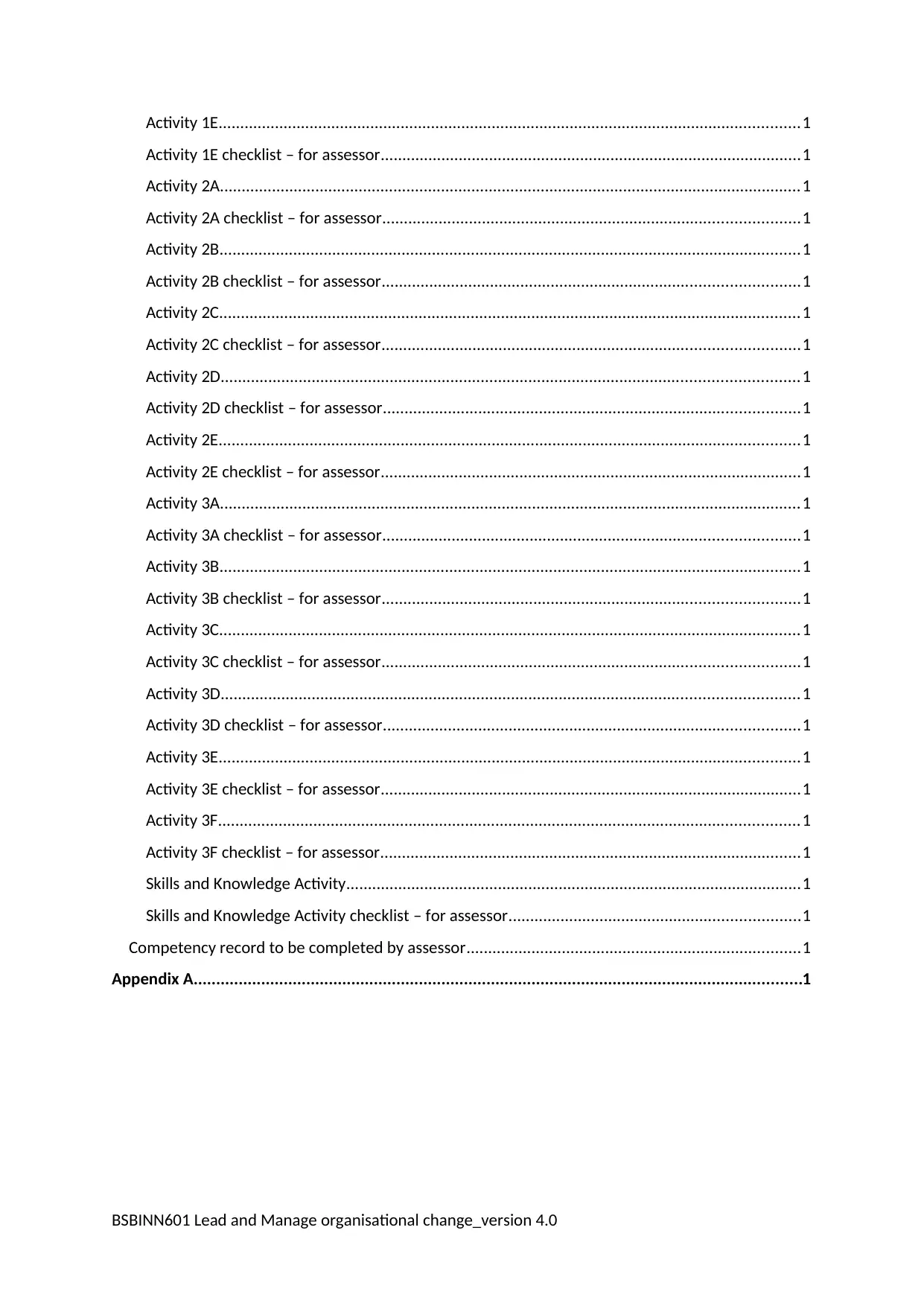
Activity 1E......................................................................................................................................1
Activity 1E checklist – for assessor.................................................................................................1
Activity 2A......................................................................................................................................1
Activity 2A checklist – for assessor................................................................................................1
Activity 2B......................................................................................................................................1
Activity 2B checklist – for assessor................................................................................................1
Activity 2C......................................................................................................................................1
Activity 2C checklist – for assessor................................................................................................1
Activity 2D.....................................................................................................................................1
Activity 2D checklist – for assessor................................................................................................1
Activity 2E......................................................................................................................................1
Activity 2E checklist – for assessor.................................................................................................1
Activity 3A......................................................................................................................................1
Activity 3A checklist – for assessor................................................................................................1
Activity 3B......................................................................................................................................1
Activity 3B checklist – for assessor................................................................................................1
Activity 3C......................................................................................................................................1
Activity 3C checklist – for assessor................................................................................................1
Activity 3D.....................................................................................................................................1
Activity 3D checklist – for assessor................................................................................................1
Activity 3E......................................................................................................................................1
Activity 3E checklist – for assessor.................................................................................................1
Activity 3F......................................................................................................................................1
Activity 3F checklist – for assessor.................................................................................................1
Skills and Knowledge Activity.........................................................................................................1
Skills and Knowledge Activity checklist – for assessor...................................................................1
Competency record to be completed by assessor.............................................................................1
Appendix A.......................................................................................................................................1
BSBINN601 Lead and Manage organisational change_version 4.0
Activity 1E checklist – for assessor.................................................................................................1
Activity 2A......................................................................................................................................1
Activity 2A checklist – for assessor................................................................................................1
Activity 2B......................................................................................................................................1
Activity 2B checklist – for assessor................................................................................................1
Activity 2C......................................................................................................................................1
Activity 2C checklist – for assessor................................................................................................1
Activity 2D.....................................................................................................................................1
Activity 2D checklist – for assessor................................................................................................1
Activity 2E......................................................................................................................................1
Activity 2E checklist – for assessor.................................................................................................1
Activity 3A......................................................................................................................................1
Activity 3A checklist – for assessor................................................................................................1
Activity 3B......................................................................................................................................1
Activity 3B checklist – for assessor................................................................................................1
Activity 3C......................................................................................................................................1
Activity 3C checklist – for assessor................................................................................................1
Activity 3D.....................................................................................................................................1
Activity 3D checklist – for assessor................................................................................................1
Activity 3E......................................................................................................................................1
Activity 3E checklist – for assessor.................................................................................................1
Activity 3F......................................................................................................................................1
Activity 3F checklist – for assessor.................................................................................................1
Skills and Knowledge Activity.........................................................................................................1
Skills and Knowledge Activity checklist – for assessor...................................................................1
Competency record to be completed by assessor.............................................................................1
Appendix A.......................................................................................................................................1
BSBINN601 Lead and Manage organisational change_version 4.0
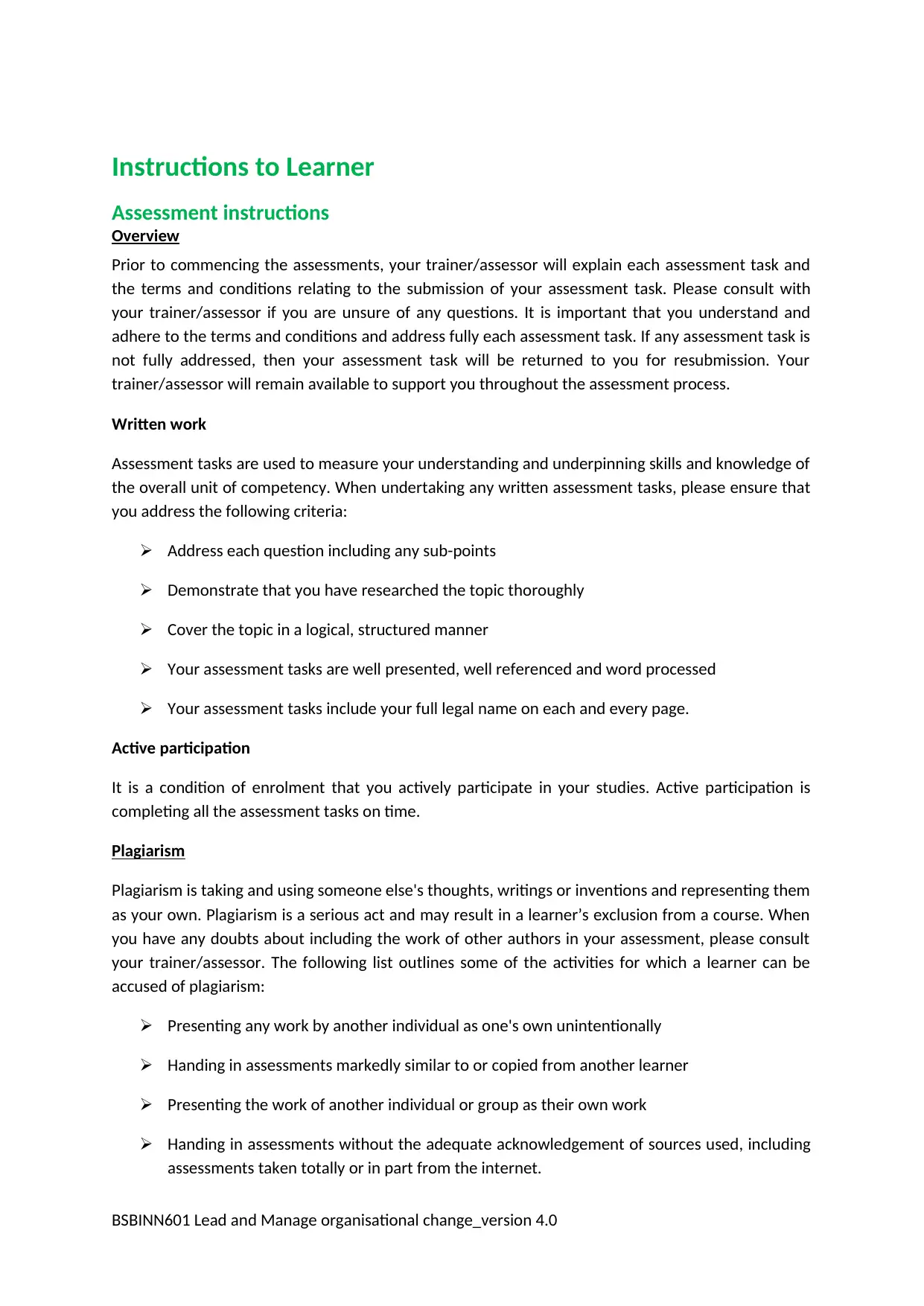
Instructions to Learner
Assessment instructions
Overview
Prior to commencing the assessments, your trainer/assessor will explain each assessment task and
the terms and conditions relating to the submission of your assessment task. Please consult with
your trainer/assessor if you are unsure of any questions. It is important that you understand and
adhere to the terms and conditions and address fully each assessment task. If any assessment task is
not fully addressed, then your assessment task will be returned to you for resubmission. Your
trainer/assessor will remain available to support you throughout the assessment process.
Written work
Assessment tasks are used to measure your understanding and underpinning skills and knowledge of
the overall unit of competency. When undertaking any written assessment tasks, please ensure that
you address the following criteria:
Address each question including any sub-points
Demonstrate that you have researched the topic thoroughly
Cover the topic in a logical, structured manner
Your assessment tasks are well presented, well referenced and word processed
Your assessment tasks include your full legal name on each and every page.
Active participation
It is a condition of enrolment that you actively participate in your studies. Active participation is
completing all the assessment tasks on time.
Plagiarism
Plagiarism is taking and using someone else's thoughts, writings or inventions and representing them
as your own. Plagiarism is a serious act and may result in a learner’s exclusion from a course. When
you have any doubts about including the work of other authors in your assessment, please consult
your trainer/assessor. The following list outlines some of the activities for which a learner can be
accused of plagiarism:
Presenting any work by another individual as one's own unintentionally
Handing in assessments markedly similar to or copied from another learner
Presenting the work of another individual or group as their own work
Handing in assessments without the adequate acknowledgement of sources used, including
assessments taken totally or in part from the internet.
BSBINN601 Lead and Manage organisational change_version 4.0
Assessment instructions
Overview
Prior to commencing the assessments, your trainer/assessor will explain each assessment task and
the terms and conditions relating to the submission of your assessment task. Please consult with
your trainer/assessor if you are unsure of any questions. It is important that you understand and
adhere to the terms and conditions and address fully each assessment task. If any assessment task is
not fully addressed, then your assessment task will be returned to you for resubmission. Your
trainer/assessor will remain available to support you throughout the assessment process.
Written work
Assessment tasks are used to measure your understanding and underpinning skills and knowledge of
the overall unit of competency. When undertaking any written assessment tasks, please ensure that
you address the following criteria:
Address each question including any sub-points
Demonstrate that you have researched the topic thoroughly
Cover the topic in a logical, structured manner
Your assessment tasks are well presented, well referenced and word processed
Your assessment tasks include your full legal name on each and every page.
Active participation
It is a condition of enrolment that you actively participate in your studies. Active participation is
completing all the assessment tasks on time.
Plagiarism
Plagiarism is taking and using someone else's thoughts, writings or inventions and representing them
as your own. Plagiarism is a serious act and may result in a learner’s exclusion from a course. When
you have any doubts about including the work of other authors in your assessment, please consult
your trainer/assessor. The following list outlines some of the activities for which a learner can be
accused of plagiarism:
Presenting any work by another individual as one's own unintentionally
Handing in assessments markedly similar to or copied from another learner
Presenting the work of another individual or group as their own work
Handing in assessments without the adequate acknowledgement of sources used, including
assessments taken totally or in part from the internet.
BSBINN601 Lead and Manage organisational change_version 4.0
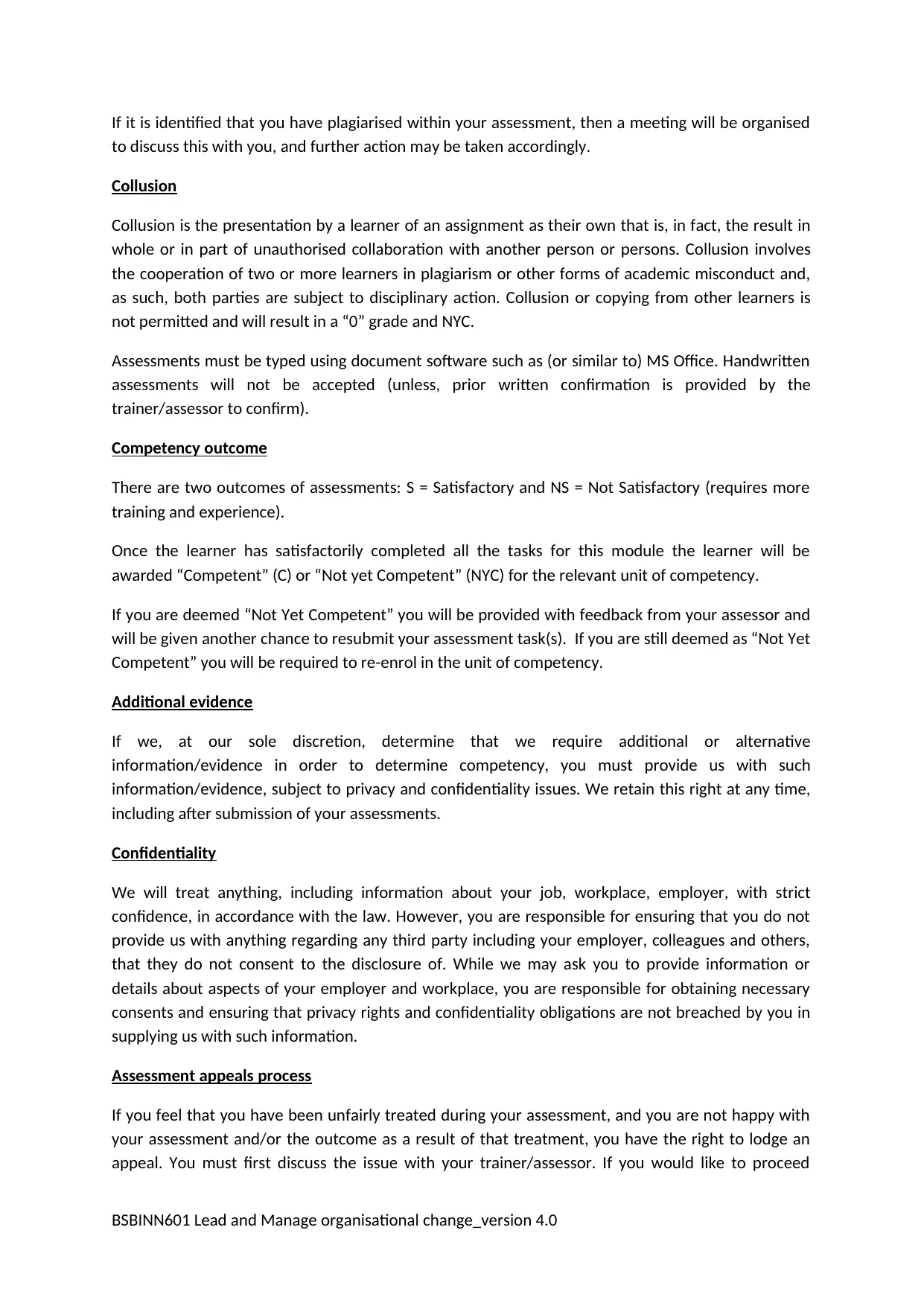
If it is identified that you have plagiarised within your assessment, then a meeting will be organised
to discuss this with you, and further action may be taken accordingly.
Collusion
Collusion is the presentation by a learner of an assignment as their own that is, in fact, the result in
whole or in part of unauthorised collaboration with another person or persons. Collusion involves
the cooperation of two or more learners in plagiarism or other forms of academic misconduct and,
as such, both parties are subject to disciplinary action. Collusion or copying from other learners is
not permitted and will result in a “0” grade and NYC.
Assessments must be typed using document software such as (or similar to) MS Office. Handwritten
assessments will not be accepted (unless, prior written confirmation is provided by the
trainer/assessor to confirm).
Competency outcome
There are two outcomes of assessments: S = Satisfactory and NS = Not Satisfactory (requires more
training and experience).
Once the learner has satisfactorily completed all the tasks for this module the learner will be
awarded “Competent” (C) or “Not yet Competent” (NYC) for the relevant unit of competency.
If you are deemed “Not Yet Competent” you will be provided with feedback from your assessor and
will be given another chance to resubmit your assessment task(s). If you are still deemed as “Not Yet
Competent” you will be required to re-enrol in the unit of competency.
Additional evidence
If we, at our sole discretion, determine that we require additional or alternative
information/evidence in order to determine competency, you must provide us with such
information/evidence, subject to privacy and confidentiality issues. We retain this right at any time,
including after submission of your assessments.
Confidentiality
We will treat anything, including information about your job, workplace, employer, with strict
confidence, in accordance with the law. However, you are responsible for ensuring that you do not
provide us with anything regarding any third party including your employer, colleagues and others,
that they do not consent to the disclosure of. While we may ask you to provide information or
details about aspects of your employer and workplace, you are responsible for obtaining necessary
consents and ensuring that privacy rights and confidentiality obligations are not breached by you in
supplying us with such information.
Assessment appeals process
If you feel that you have been unfairly treated during your assessment, and you are not happy with
your assessment and/or the outcome as a result of that treatment, you have the right to lodge an
appeal. You must first discuss the issue with your trainer/assessor. If you would like to proceed
BSBINN601 Lead and Manage organisational change_version 4.0
to discuss this with you, and further action may be taken accordingly.
Collusion
Collusion is the presentation by a learner of an assignment as their own that is, in fact, the result in
whole or in part of unauthorised collaboration with another person or persons. Collusion involves
the cooperation of two or more learners in plagiarism or other forms of academic misconduct and,
as such, both parties are subject to disciplinary action. Collusion or copying from other learners is
not permitted and will result in a “0” grade and NYC.
Assessments must be typed using document software such as (or similar to) MS Office. Handwritten
assessments will not be accepted (unless, prior written confirmation is provided by the
trainer/assessor to confirm).
Competency outcome
There are two outcomes of assessments: S = Satisfactory and NS = Not Satisfactory (requires more
training and experience).
Once the learner has satisfactorily completed all the tasks for this module the learner will be
awarded “Competent” (C) or “Not yet Competent” (NYC) for the relevant unit of competency.
If you are deemed “Not Yet Competent” you will be provided with feedback from your assessor and
will be given another chance to resubmit your assessment task(s). If you are still deemed as “Not Yet
Competent” you will be required to re-enrol in the unit of competency.
Additional evidence
If we, at our sole discretion, determine that we require additional or alternative
information/evidence in order to determine competency, you must provide us with such
information/evidence, subject to privacy and confidentiality issues. We retain this right at any time,
including after submission of your assessments.
Confidentiality
We will treat anything, including information about your job, workplace, employer, with strict
confidence, in accordance with the law. However, you are responsible for ensuring that you do not
provide us with anything regarding any third party including your employer, colleagues and others,
that they do not consent to the disclosure of. While we may ask you to provide information or
details about aspects of your employer and workplace, you are responsible for obtaining necessary
consents and ensuring that privacy rights and confidentiality obligations are not breached by you in
supplying us with such information.
Assessment appeals process
If you feel that you have been unfairly treated during your assessment, and you are not happy with
your assessment and/or the outcome as a result of that treatment, you have the right to lodge an
appeal. You must first discuss the issue with your trainer/assessor. If you would like to proceed
BSBINN601 Lead and Manage organisational change_version 4.0
Secure Best Marks with AI Grader
Need help grading? Try our AI Grader for instant feedback on your assignments.
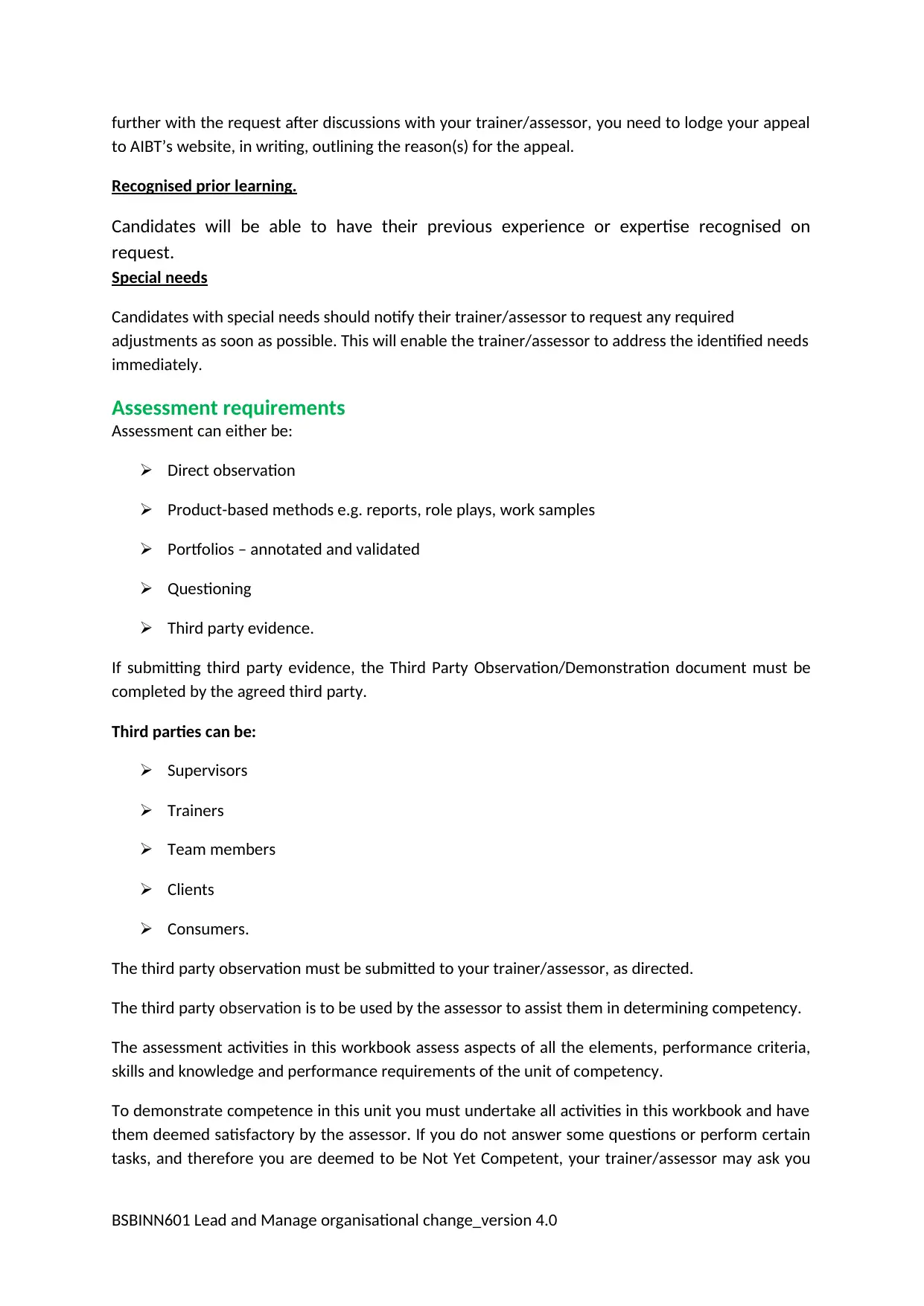
further with the request after discussions with your trainer/assessor, you need to lodge your appeal
to AIBT’s website, in writing, outlining the reason(s) for the appeal.
Recognised prior learning.
Candidates will be able to have their previous experience or expertise recognised on
request.
Special needs
Candidates with special needs should notify their trainer/assessor to request any required
adjustments as soon as possible. This will enable the trainer/assessor to address the identified needs
immediately .
Assessment requirements
Assessment can either be:
Direct observation
Product-based methods e.g. reports, role plays, work samples
Portfolios – annotated and validated
Questioning
Third party evidence.
If submitting third party evidence, the Third Party Observation/Demonstration document must be
completed by the agreed third party.
Third parties can be:
Supervisors
Trainers
Team members
Clients
Consumers.
The third party observation must be submitted to your trainer/assessor, as directed.
The third party observation is to be used by the assessor to assist them in determining competency.
The assessment activities in this workbook assess aspects of all the elements, performance criteria,
skills and knowledge and performance requirements of the unit of competency.
To demonstrate competence in this unit you must undertake all activities in this workbook and have
them deemed satisfactory by the assessor. If you do not answer some questions or perform certain
tasks, and therefore you are deemed to be Not Yet Competent, your trainer/assessor may ask you
BSBINN601 Lead and Manage organisational change_version 4.0
to AIBT’s website, in writing, outlining the reason(s) for the appeal.
Recognised prior learning.
Candidates will be able to have their previous experience or expertise recognised on
request.
Special needs
Candidates with special needs should notify their trainer/assessor to request any required
adjustments as soon as possible. This will enable the trainer/assessor to address the identified needs
immediately .
Assessment requirements
Assessment can either be:
Direct observation
Product-based methods e.g. reports, role plays, work samples
Portfolios – annotated and validated
Questioning
Third party evidence.
If submitting third party evidence, the Third Party Observation/Demonstration document must be
completed by the agreed third party.
Third parties can be:
Supervisors
Trainers
Team members
Clients
Consumers.
The third party observation must be submitted to your trainer/assessor, as directed.
The third party observation is to be used by the assessor to assist them in determining competency.
The assessment activities in this workbook assess aspects of all the elements, performance criteria,
skills and knowledge and performance requirements of the unit of competency.
To demonstrate competence in this unit you must undertake all activities in this workbook and have
them deemed satisfactory by the assessor. If you do not answer some questions or perform certain
tasks, and therefore you are deemed to be Not Yet Competent, your trainer/assessor may ask you
BSBINN601 Lead and Manage organisational change_version 4.0

supplementary questions to determine your competence. Once you have demonstrated the
required level of performance, you will be deemed competent in this unit.
Should you still be deemed Not Yet Competent, you will have the opportunity to resubmit your
assessments or appeal the result.
As part of the assessment process, all learners must abide by any relevant assessment policies as
provided during induction. If you feel you are not yet ready to be assessed or that this assessment is
unfair, please contact your assessor to discuss your options. You have the right to formally appeal
any outcome and, if you wish to do so, discuss this with your trainer/assessor
BSBINN601 Lead and Manage organisational change_version 4.0
required level of performance, you will be deemed competent in this unit.
Should you still be deemed Not Yet Competent, you will have the opportunity to resubmit your
assessments or appeal the result.
As part of the assessment process, all learners must abide by any relevant assessment policies as
provided during induction. If you feel you are not yet ready to be assessed or that this assessment is
unfair, please contact your assessor to discuss your options. You have the right to formally appeal
any outcome and, if you wish to do so, discuss this with your trainer/assessor
BSBINN601 Lead and Manage organisational change_version 4.0

Candidate Details
Assessment – BSBINN601 – Lead and manage organisational change
Please complete the following activities and hand in to your trainer/assessor for marking. This forms
part of your assessment for BSBINN601 – Lead and manage organisational change
Name: _____________________________________________________________
Student ID: _____________________________________________________________
Email: _____________________________________________________________
Declaration:
I declare that no part of this assessment has been copied from another person’s work with the
exception of where I have listed or referenced documents or work and that no part of this
assessment has been written for me by another person. I also understand the assessment
instructions and requirements and consent to being assessed.
Signed: ____________________________________________________________
Date: ____________________________________________________________
If activities have been completed as part of a small group or in pairs, details of the learners
involved should be provided below:
This activity workbook has been completed by the following persons and we acknowledge that it
was a fair team effort where everyone contributed equally to the work completed. We declare that
no part of this assessment has been copied from another person’s work with the exception of where
we have listed or referenced documents or work and that no part of this assessment has been
written for us by another person.
Learner 1: ____________________________________________________________
Signed: ____________________________________________________________
Learner 2: ____________________________________________________________
Signed: ____________________________________________________________
Learner 3: ____________________________________________________________
Signed: ____________________________________________________________
Instruction to Learners
Assessment – BSBINN601 – Lead and manage organisational change
Please complete the following activities and hand in to your trainer/assessor for marking. This forms
part of your assessment for BSBINN601 – Lead and manage organisational change
Name: _____________________________________________________________
Student ID: _____________________________________________________________
Email: _____________________________________________________________
Declaration:
I declare that no part of this assessment has been copied from another person’s work with the
exception of where I have listed or referenced documents or work and that no part of this
assessment has been written for me by another person. I also understand the assessment
instructions and requirements and consent to being assessed.
Signed: ____________________________________________________________
Date: ____________________________________________________________
If activities have been completed as part of a small group or in pairs, details of the learners
involved should be provided below:
This activity workbook has been completed by the following persons and we acknowledge that it
was a fair team effort where everyone contributed equally to the work completed. We declare that
no part of this assessment has been copied from another person’s work with the exception of where
we have listed or referenced documents or work and that no part of this assessment has been
written for us by another person.
Learner 1: ____________________________________________________________
Signed: ____________________________________________________________
Learner 2: ____________________________________________________________
Signed: ____________________________________________________________
Learner 3: ____________________________________________________________
Signed: ____________________________________________________________
Instruction to Learners
Paraphrase This Document
Need a fresh take? Get an instant paraphrase of this document with our AI Paraphraser
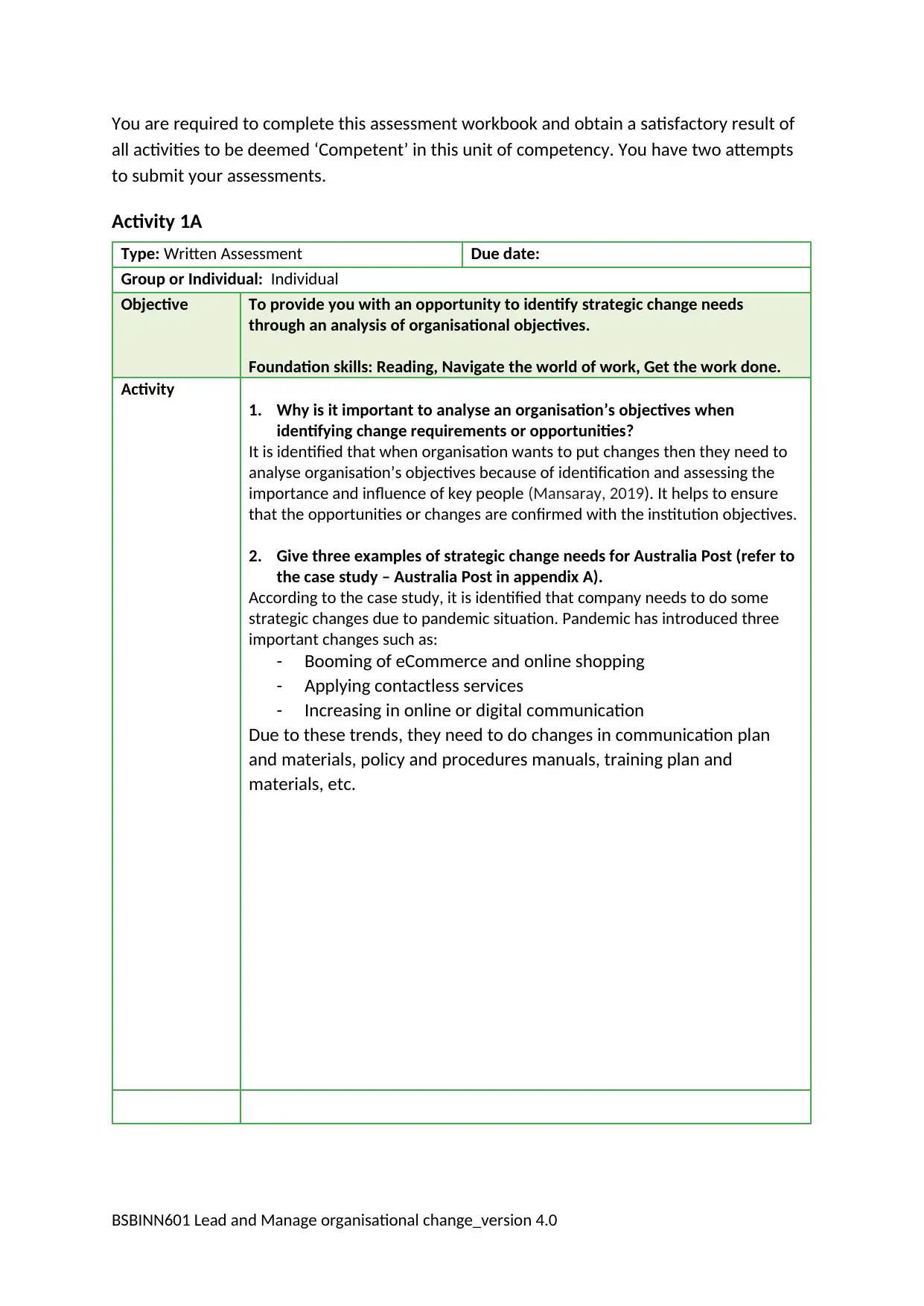
You are required to complete this assessment workbook and obtain a satisfactory result of
all activities to be deemed ‘Competent’ in this unit of competency. You have two attempts
to submit your assessments.
Activity 1A
Type: Written Assessment Due date:
Group or Individual: Individual
Objective To provide you with an opportunity to identify strategic change needs
through an analysis of organisational objectives.
Foundation skills: Reading, Navigate the world of work, Get the work done.
Activity
1. Why is it important to analyse an organisation’s objectives when
identifying change requirements or opportunities?
It is identified that when organisation wants to put changes then they need to
analyse organisation’s objectives because of identification and assessing the
importance and influence of key people (Mansaray, 2019). It helps to ensure
that the opportunities or changes are confirmed with the institution objectives.
2. Give three examples of strategic change needs for Australia Post (refer to
the case study – Australia Post in appendix A).
According to the case study, it is identified that company needs to do some
strategic changes due to pandemic situation. Pandemic has introduced three
important changes such as:
- Booming of eCommerce and online shopping
- Applying contactless services
- Increasing in online or digital communication
Due to these trends, they need to do changes in communication plan
and materials, policy and procedures manuals, training plan and
materials, etc.
BSBINN601 Lead and Manage organisational change_version 4.0
all activities to be deemed ‘Competent’ in this unit of competency. You have two attempts
to submit your assessments.
Activity 1A
Type: Written Assessment Due date:
Group or Individual: Individual
Objective To provide you with an opportunity to identify strategic change needs
through an analysis of organisational objectives.
Foundation skills: Reading, Navigate the world of work, Get the work done.
Activity
1. Why is it important to analyse an organisation’s objectives when
identifying change requirements or opportunities?
It is identified that when organisation wants to put changes then they need to
analyse organisation’s objectives because of identification and assessing the
importance and influence of key people (Mansaray, 2019). It helps to ensure
that the opportunities or changes are confirmed with the institution objectives.
2. Give three examples of strategic change needs for Australia Post (refer to
the case study – Australia Post in appendix A).
According to the case study, it is identified that company needs to do some
strategic changes due to pandemic situation. Pandemic has introduced three
important changes such as:
- Booming of eCommerce and online shopping
- Applying contactless services
- Increasing in online or digital communication
Due to these trends, they need to do changes in communication plan
and materials, policy and procedures manuals, training plan and
materials, etc.
BSBINN601 Lead and Manage organisational change_version 4.0
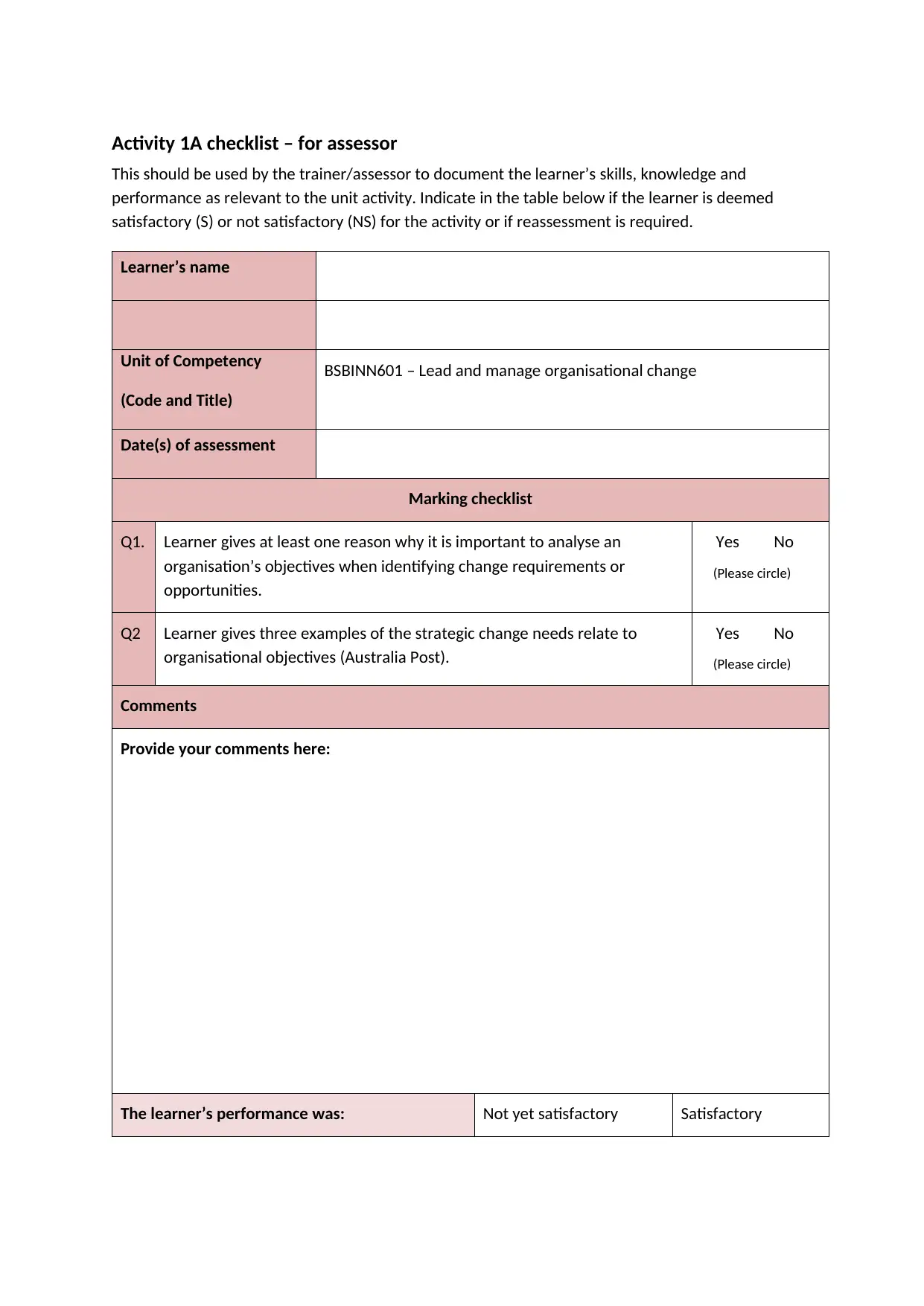
Activity 1A checklist – for assessor
This should be used by the trainer/assessor to document the learner’s skills, knowledge and
performance as relevant to the unit activity. Indicate in the table below if the learner is deemed
satisfactory (S) or not satisfactory (NS) for the activity or if reassessment is required.
Learner’s name
Unit of Competency
(Code and Title)
BSBINN601 – Lead and manage organisational change
Date(s) of assessment
Marking checklist
Q1. Learner gives at least one reason why it is important to analyse an
organisation’s objectives when identifying change requirements or
opportunities.
Yes No
(Please circle)
Q2 Learner gives three examples of the strategic change needs relate to
organisational objectives (Australia Post).
Yes No
(Please circle)
Comments
Provide your comments here:
The learner’s performance was: Not yet satisfactory Satisfactory
This should be used by the trainer/assessor to document the learner’s skills, knowledge and
performance as relevant to the unit activity. Indicate in the table below if the learner is deemed
satisfactory (S) or not satisfactory (NS) for the activity or if reassessment is required.
Learner’s name
Unit of Competency
(Code and Title)
BSBINN601 – Lead and manage organisational change
Date(s) of assessment
Marking checklist
Q1. Learner gives at least one reason why it is important to analyse an
organisation’s objectives when identifying change requirements or
opportunities.
Yes No
(Please circle)
Q2 Learner gives three examples of the strategic change needs relate to
organisational objectives (Australia Post).
Yes No
(Please circle)
Comments
Provide your comments here:
The learner’s performance was: Not yet satisfactory Satisfactory
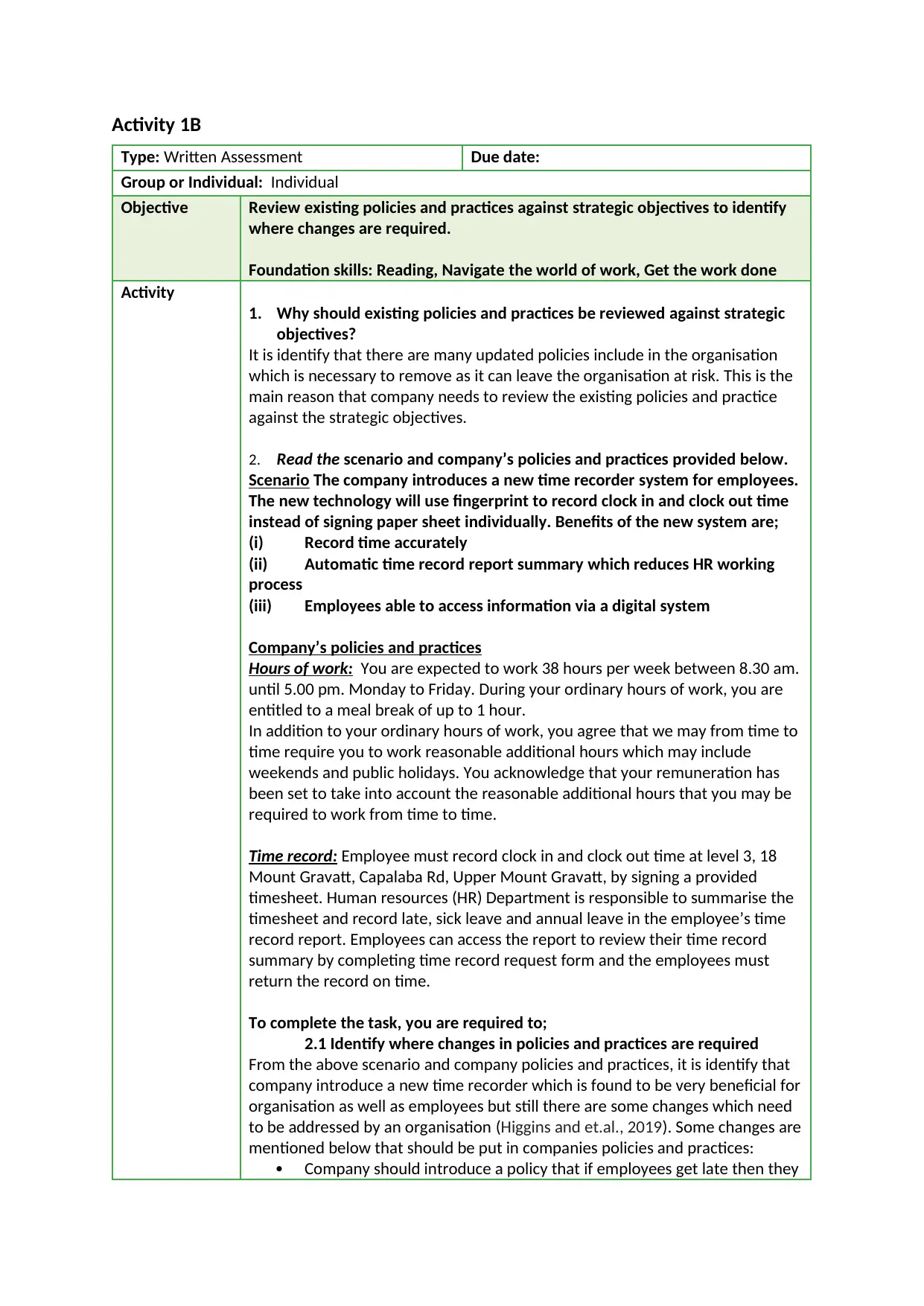
Activity 1B
Type: Written Assessment Due date:
Group or Individual: Individual
Objective Review existing policies and practices against strategic objectives to identify
where changes are required.
Foundation skills: Reading, Navigate the world of work, Get the work done
Activity
1. Why should existing policies and practices be reviewed against strategic
objectives?
It is identify that there are many updated policies include in the organisation
which is necessary to remove as it can leave the organisation at risk. This is the
main reason that company needs to review the existing policies and practice
against the strategic objectives.
2. Read the scenario and company’s policies and practices provided below.
Scenario The company introduces a new time recorder system for employees.
The new technology will use fingerprint to record clock in and clock out time
instead of signing paper sheet individually. Benefits of the new system are;
(i) Record time accurately
(ii) Automatic time record report summary which reduces HR working
process
(iii) Employees able to access information via a digital system
Company’s policies and practices
Hours of work: You are expected to work 38 hours per week between 8.30 am.
until 5.00 pm. Monday to Friday. During your ordinary hours of work, you are
entitled to a meal break of up to 1 hour.
In addition to your ordinary hours of work, you agree that we may from time to
time require you to work reasonable additional hours which may include
weekends and public holidays. You acknowledge that your remuneration has
been set to take into account the reasonable additional hours that you may be
required to work from time to time.
Time record: Employee must record clock in and clock out time at level 3, 18
Mount Gravatt, Capalaba Rd, Upper Mount Gravatt, by signing a provided
timesheet. Human resources (HR) Department is responsible to summarise the
timesheet and record late, sick leave and annual leave in the employee’s time
record report. Employees can access the report to review their time record
summary by completing time record request form and the employees must
return the record on time.
To complete the task, you are required to;
2.1 Identify where changes in policies and practices are required
From the above scenario and company policies and practices, it is identify that
company introduce a new time recorder which is found to be very beneficial for
organisation as well as employees but still there are some changes which need
to be addressed by an organisation (Higgins and et.al., 2019). Some changes are
mentioned below that should be put in companies policies and practices:
Company should introduce a policy that if employees get late then they
Type: Written Assessment Due date:
Group or Individual: Individual
Objective Review existing policies and practices against strategic objectives to identify
where changes are required.
Foundation skills: Reading, Navigate the world of work, Get the work done
Activity
1. Why should existing policies and practices be reviewed against strategic
objectives?
It is identify that there are many updated policies include in the organisation
which is necessary to remove as it can leave the organisation at risk. This is the
main reason that company needs to review the existing policies and practice
against the strategic objectives.
2. Read the scenario and company’s policies and practices provided below.
Scenario The company introduces a new time recorder system for employees.
The new technology will use fingerprint to record clock in and clock out time
instead of signing paper sheet individually. Benefits of the new system are;
(i) Record time accurately
(ii) Automatic time record report summary which reduces HR working
process
(iii) Employees able to access information via a digital system
Company’s policies and practices
Hours of work: You are expected to work 38 hours per week between 8.30 am.
until 5.00 pm. Monday to Friday. During your ordinary hours of work, you are
entitled to a meal break of up to 1 hour.
In addition to your ordinary hours of work, you agree that we may from time to
time require you to work reasonable additional hours which may include
weekends and public holidays. You acknowledge that your remuneration has
been set to take into account the reasonable additional hours that you may be
required to work from time to time.
Time record: Employee must record clock in and clock out time at level 3, 18
Mount Gravatt, Capalaba Rd, Upper Mount Gravatt, by signing a provided
timesheet. Human resources (HR) Department is responsible to summarise the
timesheet and record late, sick leave and annual leave in the employee’s time
record report. Employees can access the report to review their time record
summary by completing time record request form and the employees must
return the record on time.
To complete the task, you are required to;
2.1 Identify where changes in policies and practices are required
From the above scenario and company policies and practices, it is identify that
company introduce a new time recorder which is found to be very beneficial for
organisation as well as employees but still there are some changes which need
to be addressed by an organisation (Higgins and et.al., 2019). Some changes are
mentioned below that should be put in companies policies and practices:
Company should introduce a policy that if employees get late then they
Secure Best Marks with AI Grader
Need help grading? Try our AI Grader for instant feedback on your assignments.
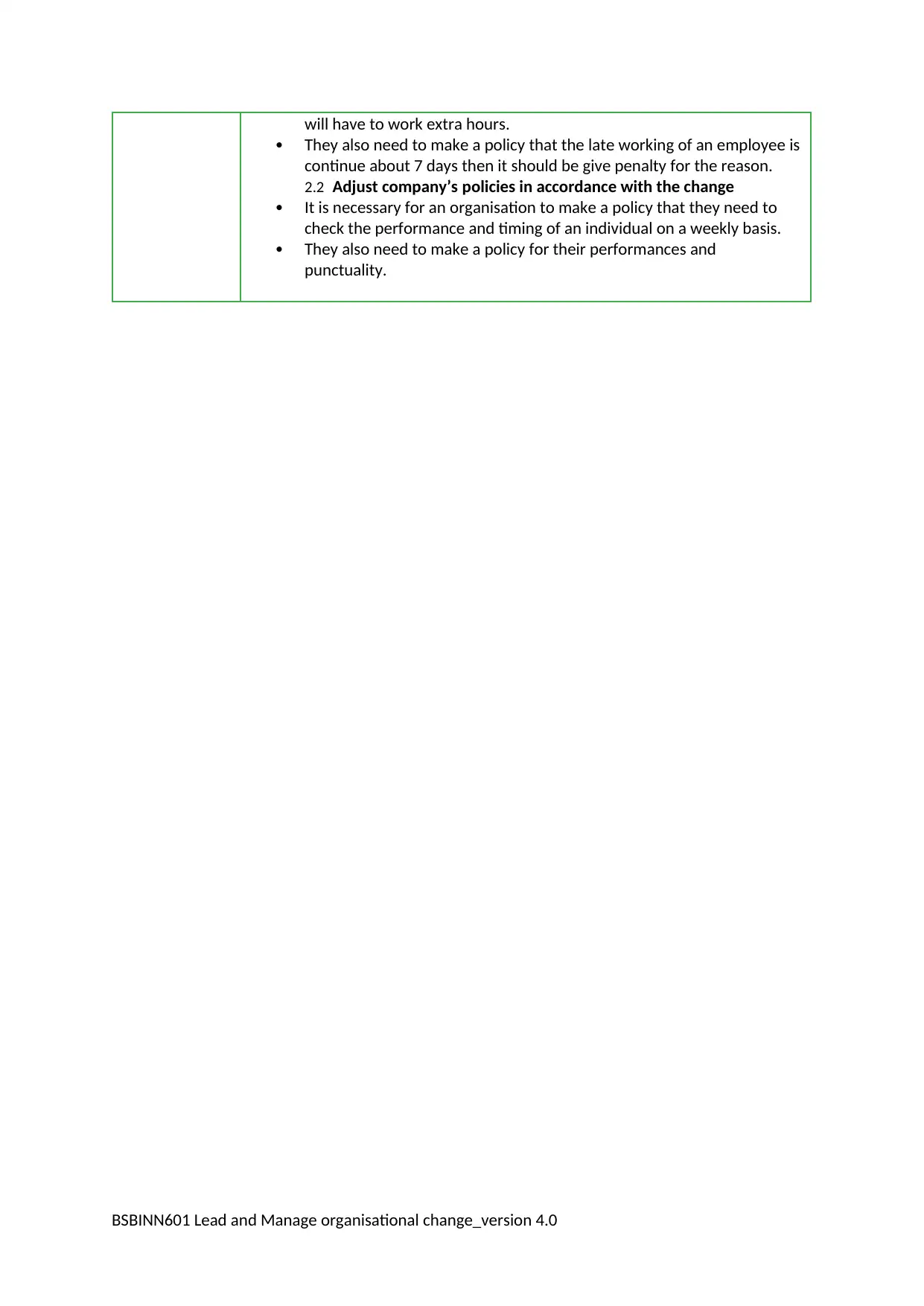
will have to work extra hours.
They also need to make a policy that the late working of an employee is
continue about 7 days then it should be give penalty for the reason.
2.2 Adjust company’s policies in accordance with the change
It is necessary for an organisation to make a policy that they need to
check the performance and timing of an individual on a weekly basis.
They also need to make a policy for their performances and
punctuality.
BSBINN601 Lead and Manage organisational change_version 4.0
They also need to make a policy that the late working of an employee is
continue about 7 days then it should be give penalty for the reason.
2.2 Adjust company’s policies in accordance with the change
It is necessary for an organisation to make a policy that they need to
check the performance and timing of an individual on a weekly basis.
They also need to make a policy for their performances and
punctuality.
BSBINN601 Lead and Manage organisational change_version 4.0
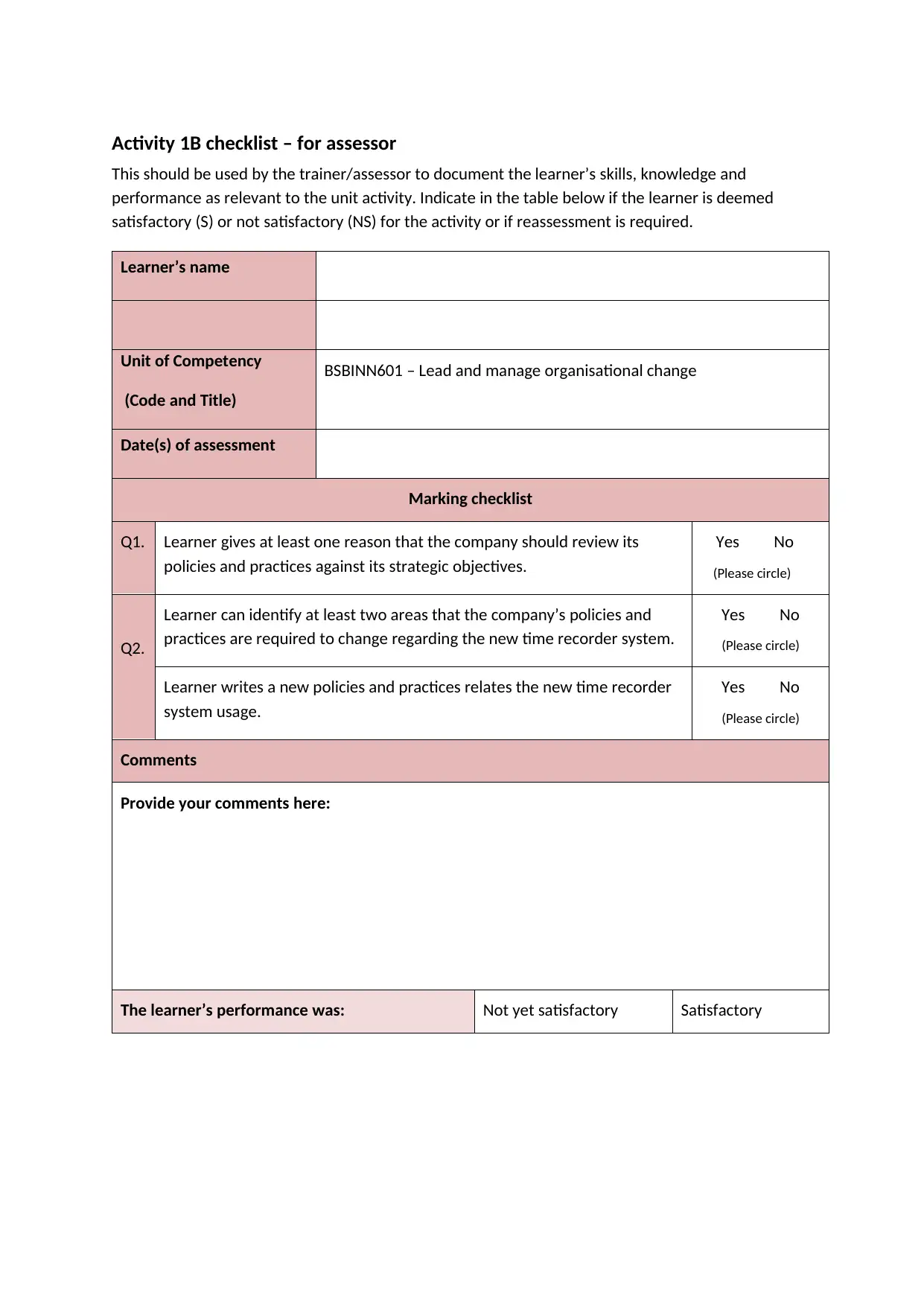
Activity 1B checklist – for assessor
This should be used by the trainer/assessor to document the learner’s skills, knowledge and
performance as relevant to the unit activity. Indicate in the table below if the learner is deemed
satisfactory (S) or not satisfactory (NS) for the activity or if reassessment is required.
Learner’s name
Unit of Competency
(Code and Title)
BSBINN601 – Lead and manage organisational change
Date(s) of assessment
Marking checklist
Q1. Learner gives at least one reason that the company should review its
policies and practices against its strategic objectives.
Yes No
(Please circle)
Q2.
Learner can identify at least two areas that the company’s policies and
practices are required to change regarding the new time recorder system.
Yes No
(Please circle)
Learner writes a new policies and practices relates the new time recorder
system usage.
Yes No
(Please circle)
Comments
Provide your comments here:
The learner’s performance was: Not yet satisfactory Satisfactory
This should be used by the trainer/assessor to document the learner’s skills, knowledge and
performance as relevant to the unit activity. Indicate in the table below if the learner is deemed
satisfactory (S) or not satisfactory (NS) for the activity or if reassessment is required.
Learner’s name
Unit of Competency
(Code and Title)
BSBINN601 – Lead and manage organisational change
Date(s) of assessment
Marking checklist
Q1. Learner gives at least one reason that the company should review its
policies and practices against its strategic objectives.
Yes No
(Please circle)
Q2.
Learner can identify at least two areas that the company’s policies and
practices are required to change regarding the new time recorder system.
Yes No
(Please circle)
Learner writes a new policies and practices relates the new time recorder
system usage.
Yes No
(Please circle)
Comments
Provide your comments here:
The learner’s performance was: Not yet satisfactory Satisfactory
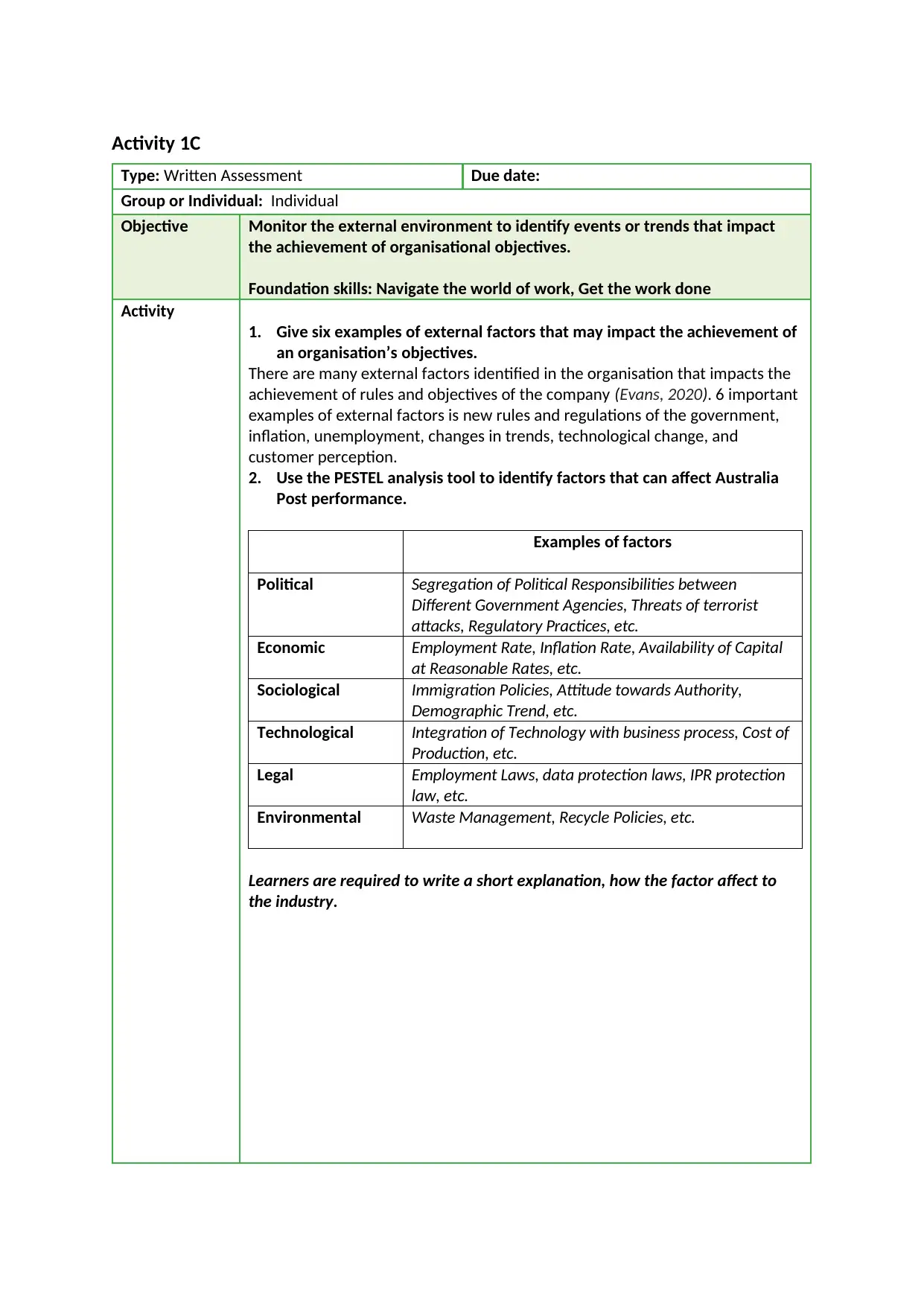
Activity 1C
Type: Written Assessment Due date:
Group or Individual: Individual
Objective Monitor the external environment to identify events or trends that impact
the achievement of organisational objectives.
Foundation skills: Navigate the world of work, Get the work done
Activity
1. Give six examples of external factors that may impact the achievement of
an organisation’s objectives.
There are many external factors identified in the organisation that impacts the
achievement of rules and objectives of the company (Evans, 2020). 6 important
examples of external factors is new rules and regulations of the government,
inflation, unemployment, changes in trends, technological change, and
customer perception.
2. Use the PESTEL analysis tool to identify factors that can affect Australia
Post performance.
Examples of factors
Political Segregation of Political Responsibilities between
Different Government Agencies, Threats of terrorist
attacks, Regulatory Practices, etc.
Economic Employment Rate, Inflation Rate, Availability of Capital
at Reasonable Rates, etc.
Sociological Immigration Policies, Attitude towards Authority,
Demographic Trend, etc.
Technological Integration of Technology with business process, Cost of
Production, etc.
Legal Employment Laws, data protection laws, IPR protection
law, etc.
Environmental Waste Management, Recycle Policies, etc.
Learners are required to write a short explanation, how the factor affect to
the industry.
Type: Written Assessment Due date:
Group or Individual: Individual
Objective Monitor the external environment to identify events or trends that impact
the achievement of organisational objectives.
Foundation skills: Navigate the world of work, Get the work done
Activity
1. Give six examples of external factors that may impact the achievement of
an organisation’s objectives.
There are many external factors identified in the organisation that impacts the
achievement of rules and objectives of the company (Evans, 2020). 6 important
examples of external factors is new rules and regulations of the government,
inflation, unemployment, changes in trends, technological change, and
customer perception.
2. Use the PESTEL analysis tool to identify factors that can affect Australia
Post performance.
Examples of factors
Political Segregation of Political Responsibilities between
Different Government Agencies, Threats of terrorist
attacks, Regulatory Practices, etc.
Economic Employment Rate, Inflation Rate, Availability of Capital
at Reasonable Rates, etc.
Sociological Immigration Policies, Attitude towards Authority,
Demographic Trend, etc.
Technological Integration of Technology with business process, Cost of
Production, etc.
Legal Employment Laws, data protection laws, IPR protection
law, etc.
Environmental Waste Management, Recycle Policies, etc.
Learners are required to write a short explanation, how the factor affect to
the industry.
Paraphrase This Document
Need a fresh take? Get an instant paraphrase of this document with our AI Paraphraser
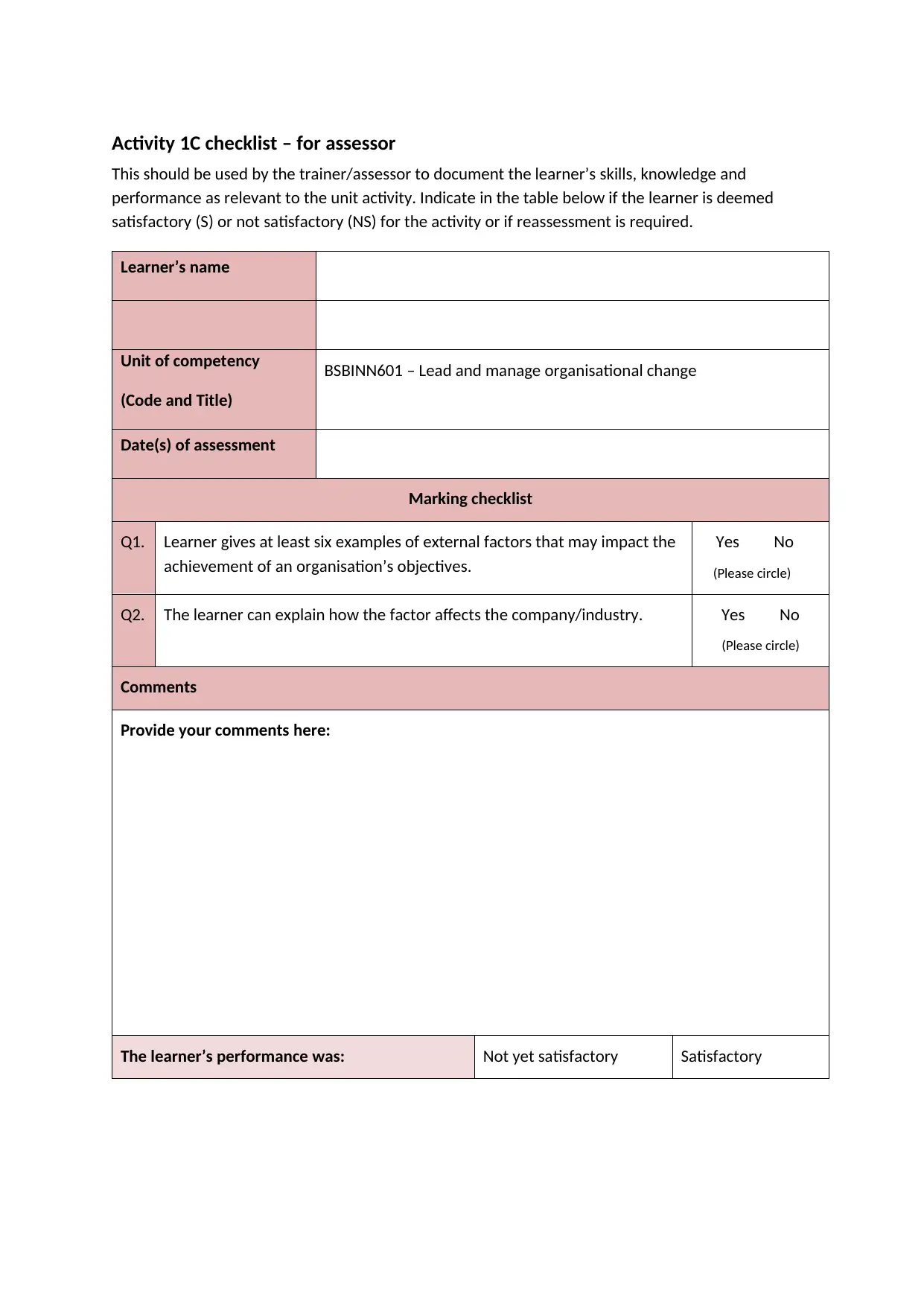
Activity 1C checklist – for assessor
This should be used by the trainer/assessor to document the learner’s skills, knowledge and
performance as relevant to the unit activity. Indicate in the table below if the learner is deemed
satisfactory (S) or not satisfactory (NS) for the activity or if reassessment is required.
Learner’s name
Unit of competency
(Code and Title)
BSBINN601 – Lead and manage organisational change
Date(s) of assessment
Marking checklist
Q1. Learner gives at least six examples of external factors that may impact the
achievement of an organisation’s objectives.
Yes No
(Please circle)
Q2. The learner can explain how the factor affects the company/industry. Yes No
(Please circle)
Comments
Provide your comments here:
The learner’s performance was: Not yet satisfactory Satisfactory
This should be used by the trainer/assessor to document the learner’s skills, knowledge and
performance as relevant to the unit activity. Indicate in the table below if the learner is deemed
satisfactory (S) or not satisfactory (NS) for the activity or if reassessment is required.
Learner’s name
Unit of competency
(Code and Title)
BSBINN601 – Lead and manage organisational change
Date(s) of assessment
Marking checklist
Q1. Learner gives at least six examples of external factors that may impact the
achievement of an organisation’s objectives.
Yes No
(Please circle)
Q2. The learner can explain how the factor affects the company/industry. Yes No
(Please circle)
Comments
Provide your comments here:
The learner’s performance was: Not yet satisfactory Satisfactory
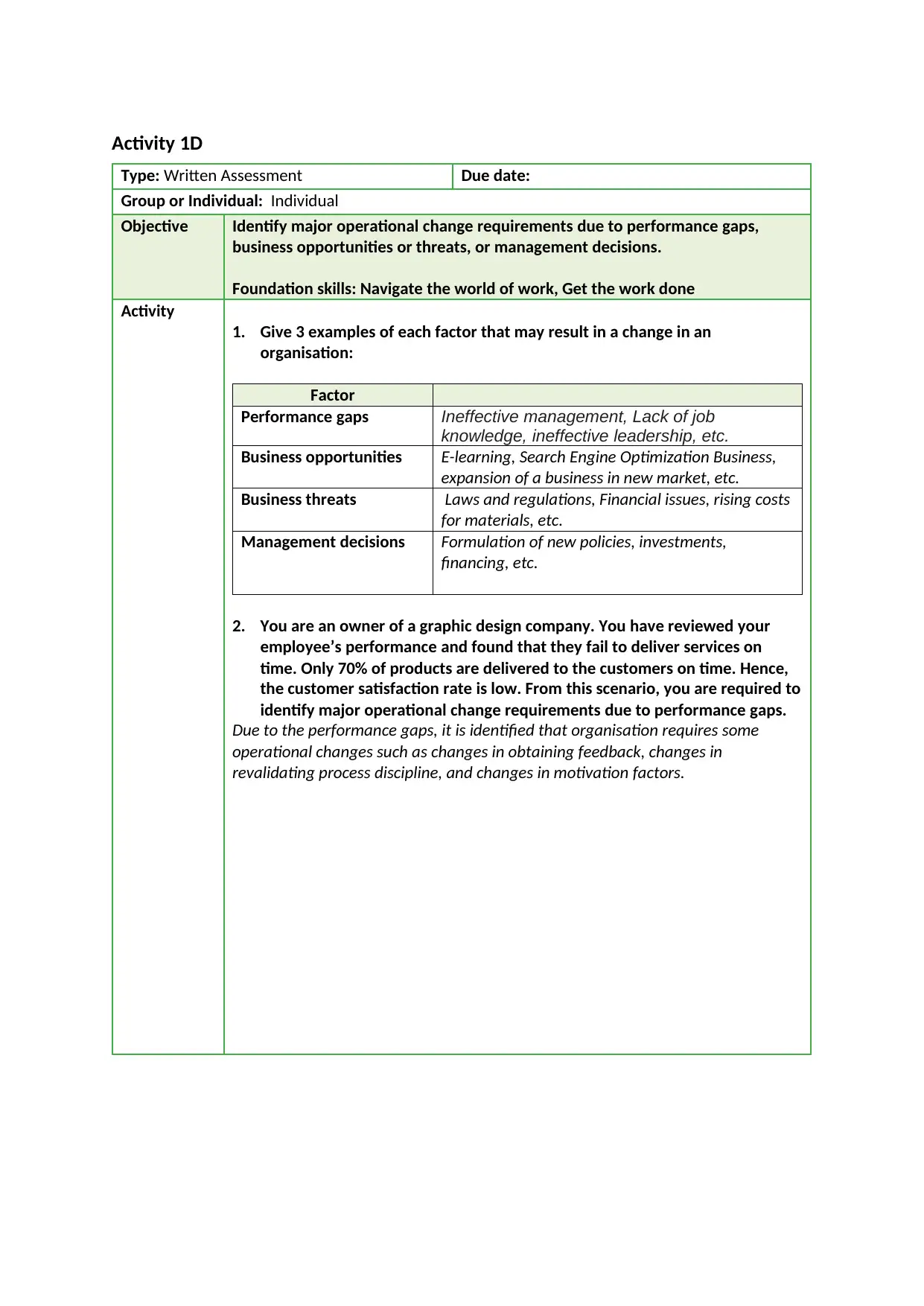
Activity 1D
Type: Written Assessment Due date:
Group or Individual: Individual
Objective Identify major operational change requirements due to performance gaps,
business opportunities or threats, or management decisions.
Foundation skills: Navigate the world of work, Get the work done
Activity
1. Give 3 examples of each factor that may result in a change in an
organisation:
Factor
Performance gaps Ineffective management, Lack of job
knowledge, ineffective leadership, etc.
Business opportunities E-learning, Search Engine Optimization Business,
expansion of a business in new market, etc.
Business threats Laws and regulations, Financial issues, rising costs
for materials, etc.
Management decisions Formulation of new policies, investments,
financing, etc.
2. You are an owner of a graphic design company. You have reviewed your
employee’s performance and found that they fail to deliver services on
time. Only 70% of products are delivered to the customers on time. Hence,
the customer satisfaction rate is low. From this scenario, you are required to
identify major operational change requirements due to performance gaps.
Due to the performance gaps, it is identified that organisation requires some
operational changes such as changes in obtaining feedback, changes in
revalidating process discipline, and changes in motivation factors.
Type: Written Assessment Due date:
Group or Individual: Individual
Objective Identify major operational change requirements due to performance gaps,
business opportunities or threats, or management decisions.
Foundation skills: Navigate the world of work, Get the work done
Activity
1. Give 3 examples of each factor that may result in a change in an
organisation:
Factor
Performance gaps Ineffective management, Lack of job
knowledge, ineffective leadership, etc.
Business opportunities E-learning, Search Engine Optimization Business,
expansion of a business in new market, etc.
Business threats Laws and regulations, Financial issues, rising costs
for materials, etc.
Management decisions Formulation of new policies, investments,
financing, etc.
2. You are an owner of a graphic design company. You have reviewed your
employee’s performance and found that they fail to deliver services on
time. Only 70% of products are delivered to the customers on time. Hence,
the customer satisfaction rate is low. From this scenario, you are required to
identify major operational change requirements due to performance gaps.
Due to the performance gaps, it is identified that organisation requires some
operational changes such as changes in obtaining feedback, changes in
revalidating process discipline, and changes in motivation factors.
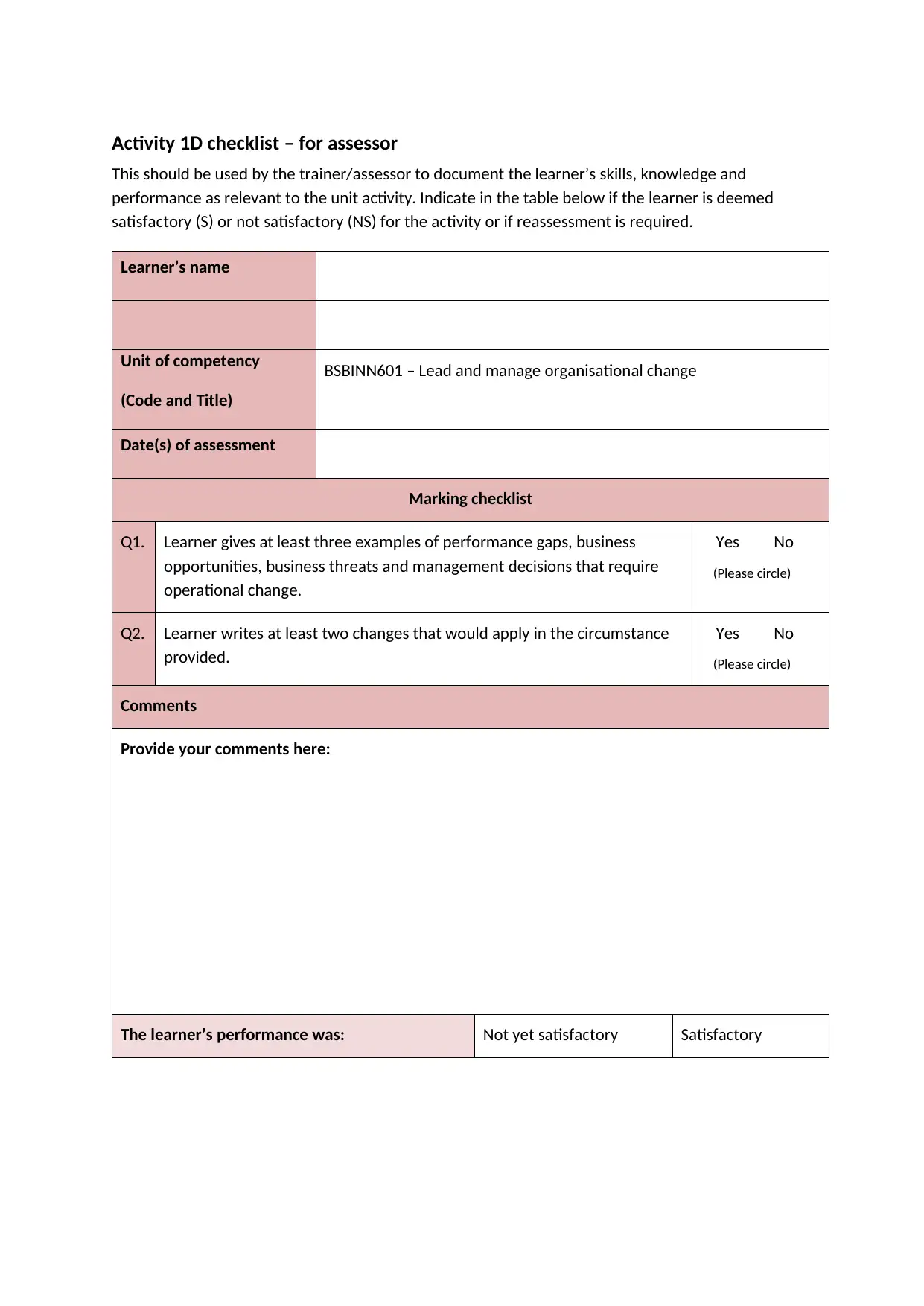
Activity 1D checklist – for assessor
This should be used by the trainer/assessor to document the learner’s skills, knowledge and
performance as relevant to the unit activity. Indicate in the table below if the learner is deemed
satisfactory (S) or not satisfactory (NS) for the activity or if reassessment is required.
Learner’s name
Unit of competency
(Code and Title)
BSBINN601 – Lead and manage organisational change
Date(s) of assessment
Marking checklist
Q1. Learner gives at least three examples of performance gaps, business
opportunities, business threats and management decisions that require
operational change.
Yes No
(Please circle)
Q2. Learner writes at least two changes that would apply in the circumstance
provided.
Yes No
(Please circle)
Comments
Provide your comments here:
The learner’s performance was: Not yet satisfactory Satisfactory
This should be used by the trainer/assessor to document the learner’s skills, knowledge and
performance as relevant to the unit activity. Indicate in the table below if the learner is deemed
satisfactory (S) or not satisfactory (NS) for the activity or if reassessment is required.
Learner’s name
Unit of competency
(Code and Title)
BSBINN601 – Lead and manage organisational change
Date(s) of assessment
Marking checklist
Q1. Learner gives at least three examples of performance gaps, business
opportunities, business threats and management decisions that require
operational change.
Yes No
(Please circle)
Q2. Learner writes at least two changes that would apply in the circumstance
provided.
Yes No
(Please circle)
Comments
Provide your comments here:
The learner’s performance was: Not yet satisfactory Satisfactory
Secure Best Marks with AI Grader
Need help grading? Try our AI Grader for instant feedback on your assignments.
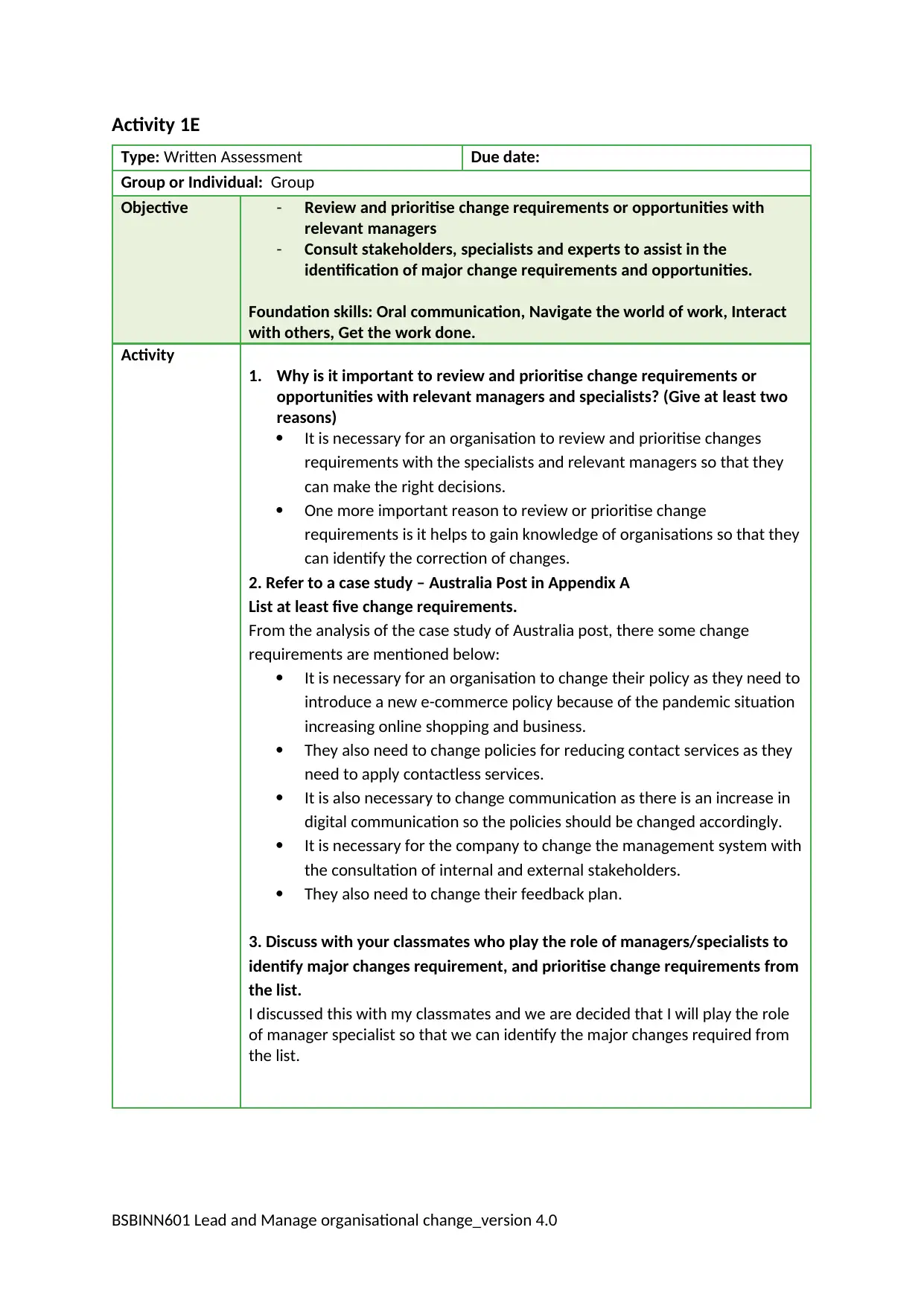
Activity 1E
Type: Written Assessment Due date:
Group or Individual: Group
Objective - Review and prioritise change requirements or opportunities with
relevant managers
- Consult stakeholders, specialists and experts to assist in the
identification of major change requirements and opportunities.
Foundation skills: Oral communication, Navigate the world of work, Interact
with others, Get the work done.
Activity
1. Why is it important to review and prioritise change requirements or
opportunities with relevant managers and specialists? (Give at least two
reasons)
It is necessary for an organisation to review and prioritise changes
requirements with the specialists and relevant managers so that they
can make the right decisions.
One more important reason to review or prioritise change
requirements is it helps to gain knowledge of organisations so that they
can identify the correction of changes.
2. Refer to a case study – Australia Post in Appendix A
List at least five change requirements.
From the analysis of the case study of Australia post, there some change
requirements are mentioned below:
It is necessary for an organisation to change their policy as they need to
introduce a new e-commerce policy because of the pandemic situation
increasing online shopping and business.
They also need to change policies for reducing contact services as they
need to apply contactless services.
It is also necessary to change communication as there is an increase in
digital communication so the policies should be changed accordingly.
It is necessary for the company to change the management system with
the consultation of internal and external stakeholders.
They also need to change their feedback plan.
3. Discuss with your classmates who play the role of managers/specialists to
identify major changes requirement, and prioritise change requirements from
the list.
I discussed this with my classmates and we are decided that I will play the role
of manager specialist so that we can identify the major changes required from
the list.
BSBINN601 Lead and Manage organisational change_version 4.0
Type: Written Assessment Due date:
Group or Individual: Group
Objective - Review and prioritise change requirements or opportunities with
relevant managers
- Consult stakeholders, specialists and experts to assist in the
identification of major change requirements and opportunities.
Foundation skills: Oral communication, Navigate the world of work, Interact
with others, Get the work done.
Activity
1. Why is it important to review and prioritise change requirements or
opportunities with relevant managers and specialists? (Give at least two
reasons)
It is necessary for an organisation to review and prioritise changes
requirements with the specialists and relevant managers so that they
can make the right decisions.
One more important reason to review or prioritise change
requirements is it helps to gain knowledge of organisations so that they
can identify the correction of changes.
2. Refer to a case study – Australia Post in Appendix A
List at least five change requirements.
From the analysis of the case study of Australia post, there some change
requirements are mentioned below:
It is necessary for an organisation to change their policy as they need to
introduce a new e-commerce policy because of the pandemic situation
increasing online shopping and business.
They also need to change policies for reducing contact services as they
need to apply contactless services.
It is also necessary to change communication as there is an increase in
digital communication so the policies should be changed accordingly.
It is necessary for the company to change the management system with
the consultation of internal and external stakeholders.
They also need to change their feedback plan.
3. Discuss with your classmates who play the role of managers/specialists to
identify major changes requirement, and prioritise change requirements from
the list.
I discussed this with my classmates and we are decided that I will play the role
of manager specialist so that we can identify the major changes required from
the list.
BSBINN601 Lead and Manage organisational change_version 4.0
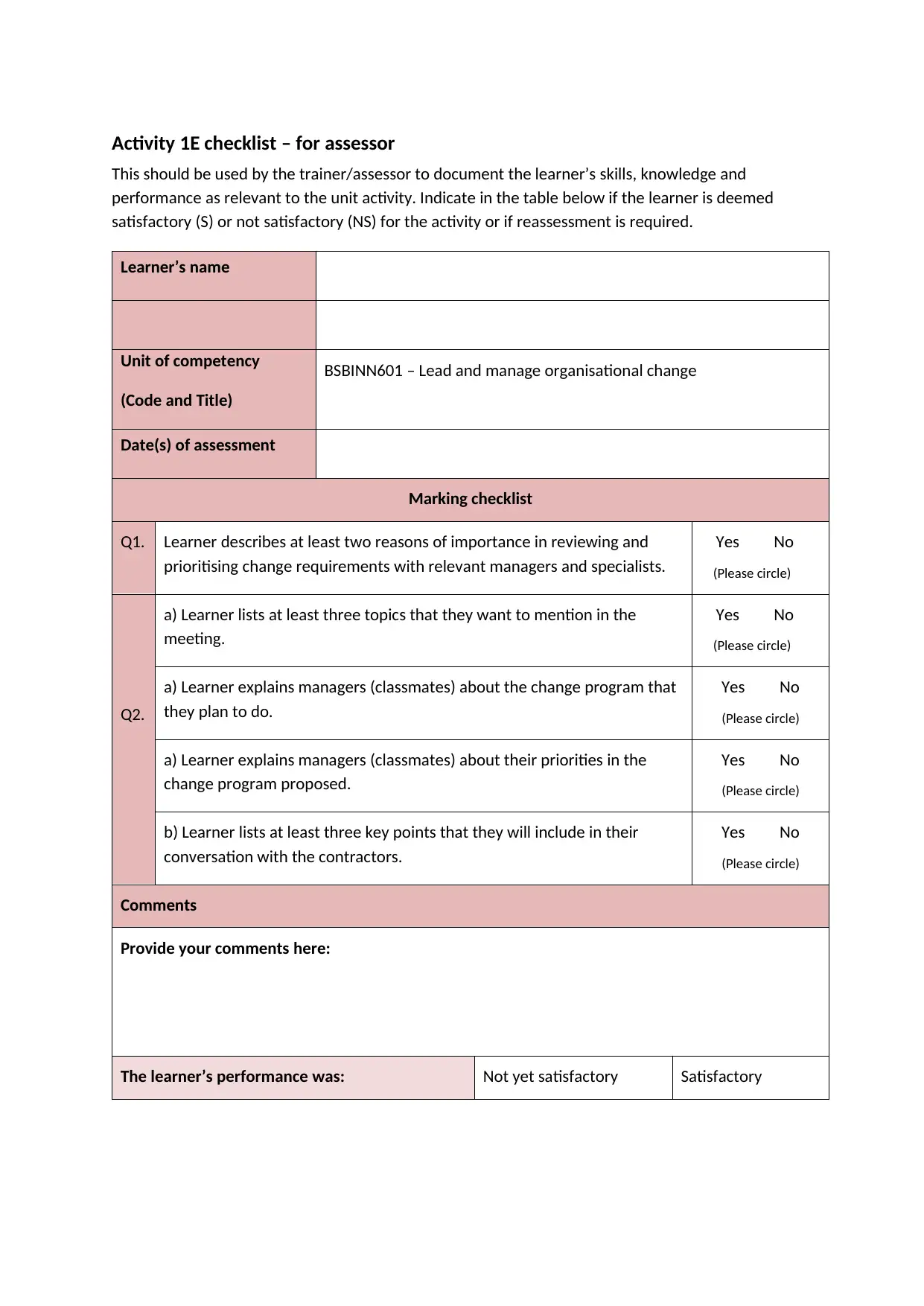
Activity 1E checklist – for assessor
This should be used by the trainer/assessor to document the learner’s skills, knowledge and
performance as relevant to the unit activity. Indicate in the table below if the learner is deemed
satisfactory (S) or not satisfactory (NS) for the activity or if reassessment is required.
Learner’s name
Unit of competency
(Code and Title)
BSBINN601 – Lead and manage organisational change
Date(s) of assessment
Marking checklist
Q1. Learner describes at least two reasons of importance in reviewing and
prioritising change requirements with relevant managers and specialists.
Yes No
(Please circle)
Q2.
a) Learner lists at least three topics that they want to mention in the
meeting.
Yes No
(Please circle)
a) Learner explains managers (classmates) about the change program that
they plan to do.
Yes No
(Please circle)
a) Learner explains managers (classmates) about their priorities in the
change program proposed.
Yes No
(Please circle)
b) Learner lists at least three key points that they will include in their
conversation with the contractors.
Yes No
(Please circle)
Comments
Provide your comments here:
The learner’s performance was: Not yet satisfactory Satisfactory
This should be used by the trainer/assessor to document the learner’s skills, knowledge and
performance as relevant to the unit activity. Indicate in the table below if the learner is deemed
satisfactory (S) or not satisfactory (NS) for the activity or if reassessment is required.
Learner’s name
Unit of competency
(Code and Title)
BSBINN601 – Lead and manage organisational change
Date(s) of assessment
Marking checklist
Q1. Learner describes at least two reasons of importance in reviewing and
prioritising change requirements with relevant managers and specialists.
Yes No
(Please circle)
Q2.
a) Learner lists at least three topics that they want to mention in the
meeting.
Yes No
(Please circle)
a) Learner explains managers (classmates) about the change program that
they plan to do.
Yes No
(Please circle)
a) Learner explains managers (classmates) about their priorities in the
change program proposed.
Yes No
(Please circle)
b) Learner lists at least three key points that they will include in their
conversation with the contractors.
Yes No
(Please circle)
Comments
Provide your comments here:
The learner’s performance was: Not yet satisfactory Satisfactory
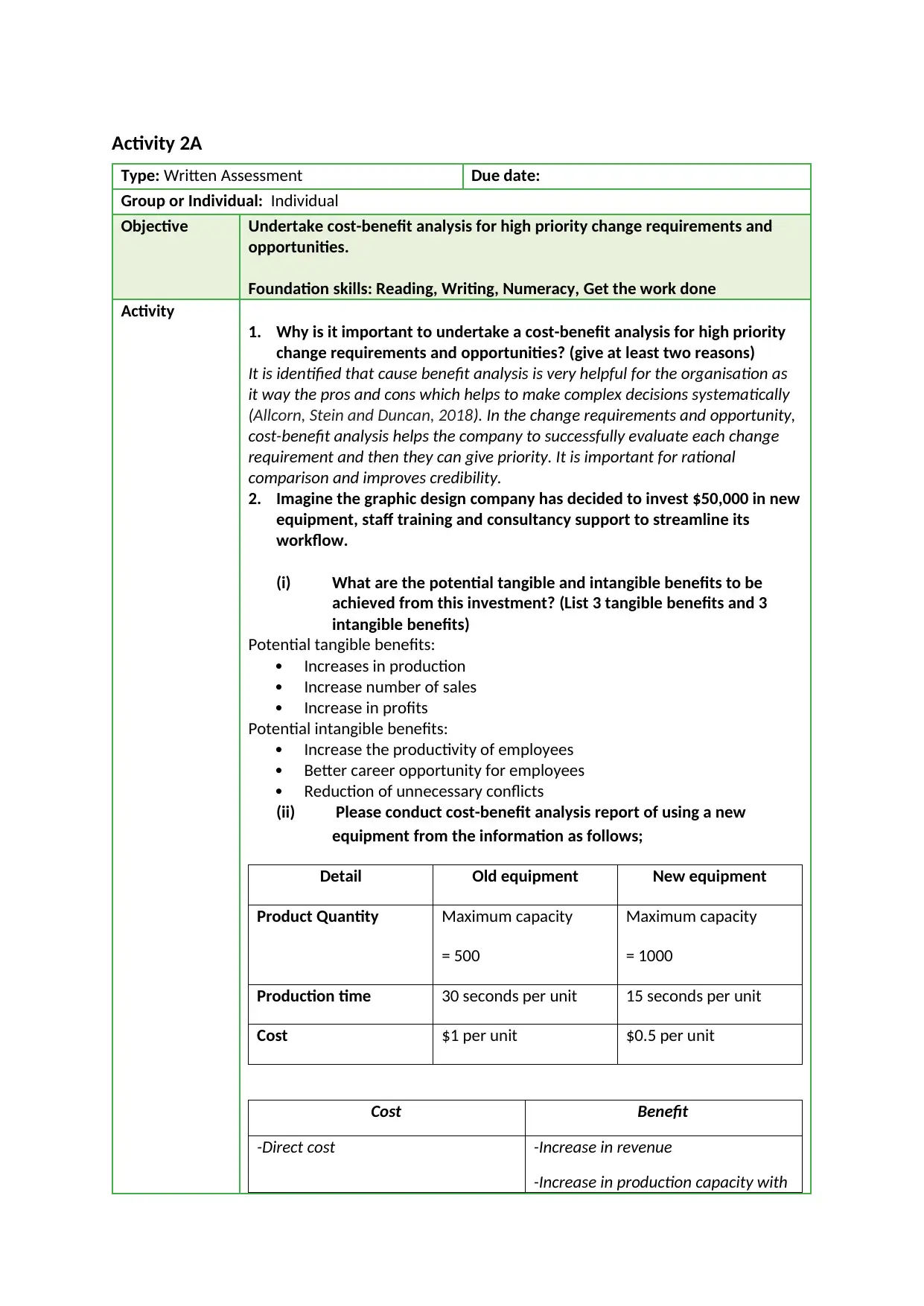
Activity 2A
Type: Written Assessment Due date:
Group or Individual: Individual
Objective Undertake cost-benefit analysis for high priority change requirements and
opportunities.
Foundation skills: Reading, Writing, Numeracy, Get the work done
Activity
1. Why is it important to undertake a cost-benefit analysis for high priority
change requirements and opportunities? (give at least two reasons)
It is identified that cause benefit analysis is very helpful for the organisation as
it way the pros and cons which helps to make complex decisions systematically
(Allcorn, Stein and Duncan, 2018). In the change requirements and opportunity,
cost-benefit analysis helps the company to successfully evaluate each change
requirement and then they can give priority. It is important for rational
comparison and improves credibility.
2. Imagine the graphic design company has decided to invest $50,000 in new
equipment, staff training and consultancy support to streamline its
workflow.
(i) What are the potential tangible and intangible benefits to be
achieved from this investment? (List 3 tangible benefits and 3
intangible benefits)
Potential tangible benefits:
Increases in production
Increase number of sales
Increase in profits
Potential intangible benefits:
Increase the productivity of employees
Better career opportunity for employees
Reduction of unnecessary conflicts
(ii) Please conduct cost-benefit analysis report of using a new
equipment from the information as follows;
Detail Old equipment New equipment
Product Quantity Maximum capacity
= 500
Maximum capacity
= 1000
Production time 30 seconds per unit 15 seconds per unit
Cost $1 per unit $0.5 per unit
Cost Benefit
-Direct cost -Increase in revenue
-Increase in production capacity with
Type: Written Assessment Due date:
Group or Individual: Individual
Objective Undertake cost-benefit analysis for high priority change requirements and
opportunities.
Foundation skills: Reading, Writing, Numeracy, Get the work done
Activity
1. Why is it important to undertake a cost-benefit analysis for high priority
change requirements and opportunities? (give at least two reasons)
It is identified that cause benefit analysis is very helpful for the organisation as
it way the pros and cons which helps to make complex decisions systematically
(Allcorn, Stein and Duncan, 2018). In the change requirements and opportunity,
cost-benefit analysis helps the company to successfully evaluate each change
requirement and then they can give priority. It is important for rational
comparison and improves credibility.
2. Imagine the graphic design company has decided to invest $50,000 in new
equipment, staff training and consultancy support to streamline its
workflow.
(i) What are the potential tangible and intangible benefits to be
achieved from this investment? (List 3 tangible benefits and 3
intangible benefits)
Potential tangible benefits:
Increases in production
Increase number of sales
Increase in profits
Potential intangible benefits:
Increase the productivity of employees
Better career opportunity for employees
Reduction of unnecessary conflicts
(ii) Please conduct cost-benefit analysis report of using a new
equipment from the information as follows;
Detail Old equipment New equipment
Product Quantity Maximum capacity
= 500
Maximum capacity
= 1000
Production time 30 seconds per unit 15 seconds per unit
Cost $1 per unit $0.5 per unit
Cost Benefit
-Direct cost -Increase in revenue
-Increase in production capacity with
Paraphrase This Document
Need a fresh take? Get an instant paraphrase of this document with our AI Paraphraser

-Indirect cost
-Intangible cost
same resources
-Reduction of costs
BSBINN601 Lead and Manage organisational change_version 4.0
-Intangible cost
same resources
-Reduction of costs
BSBINN601 Lead and Manage organisational change_version 4.0

Activity 2A checklist – for assessor
This should be used by the trainer/assessor to document the learner’s skills, knowledge and
performance as relevant to the unit activity. Indicate in the table below if the learner is deemed
satisfactory (S) or not satisfactory (NS) for the activity or if reassessment is required.
Learner’s name
Unit of competency
(Code and Title)
BSBINN601 – Lead and manage organisational change
Date(s) of assessment
Marking checklist
Q1. Learner describes at least two reasons about importance of undertaking
cost-benefit analysis for high priority change requirements and
opportunities.
Yes No
(Please circle)
Q2.
i) Learner lists at least two potential tangible benefits relates to the
scenario provided.
Yes No
(Please circle)
i) Learner lists at least two potential intangible benefits relates to the
scenario provided.
Yes No
(Please circle)
ii) Learner identifies at least three benefits of using the new technology Yes No
(Please circle)
ii) Learner identifies at least three costs of using the new technology Yes No
(Please circle)
ii) Learner includes calculation or figures in the answers (at least 1). Yes No
(Please circle)
Comments
Provide your comments here:
The learner’s performance was: Not yet satisfactory Satisfactory
This should be used by the trainer/assessor to document the learner’s skills, knowledge and
performance as relevant to the unit activity. Indicate in the table below if the learner is deemed
satisfactory (S) or not satisfactory (NS) for the activity or if reassessment is required.
Learner’s name
Unit of competency
(Code and Title)
BSBINN601 – Lead and manage organisational change
Date(s) of assessment
Marking checklist
Q1. Learner describes at least two reasons about importance of undertaking
cost-benefit analysis for high priority change requirements and
opportunities.
Yes No
(Please circle)
Q2.
i) Learner lists at least two potential tangible benefits relates to the
scenario provided.
Yes No
(Please circle)
i) Learner lists at least two potential intangible benefits relates to the
scenario provided.
Yes No
(Please circle)
ii) Learner identifies at least three benefits of using the new technology Yes No
(Please circle)
ii) Learner identifies at least three costs of using the new technology Yes No
(Please circle)
ii) Learner includes calculation or figures in the answers (at least 1). Yes No
(Please circle)
Comments
Provide your comments here:
The learner’s performance was: Not yet satisfactory Satisfactory
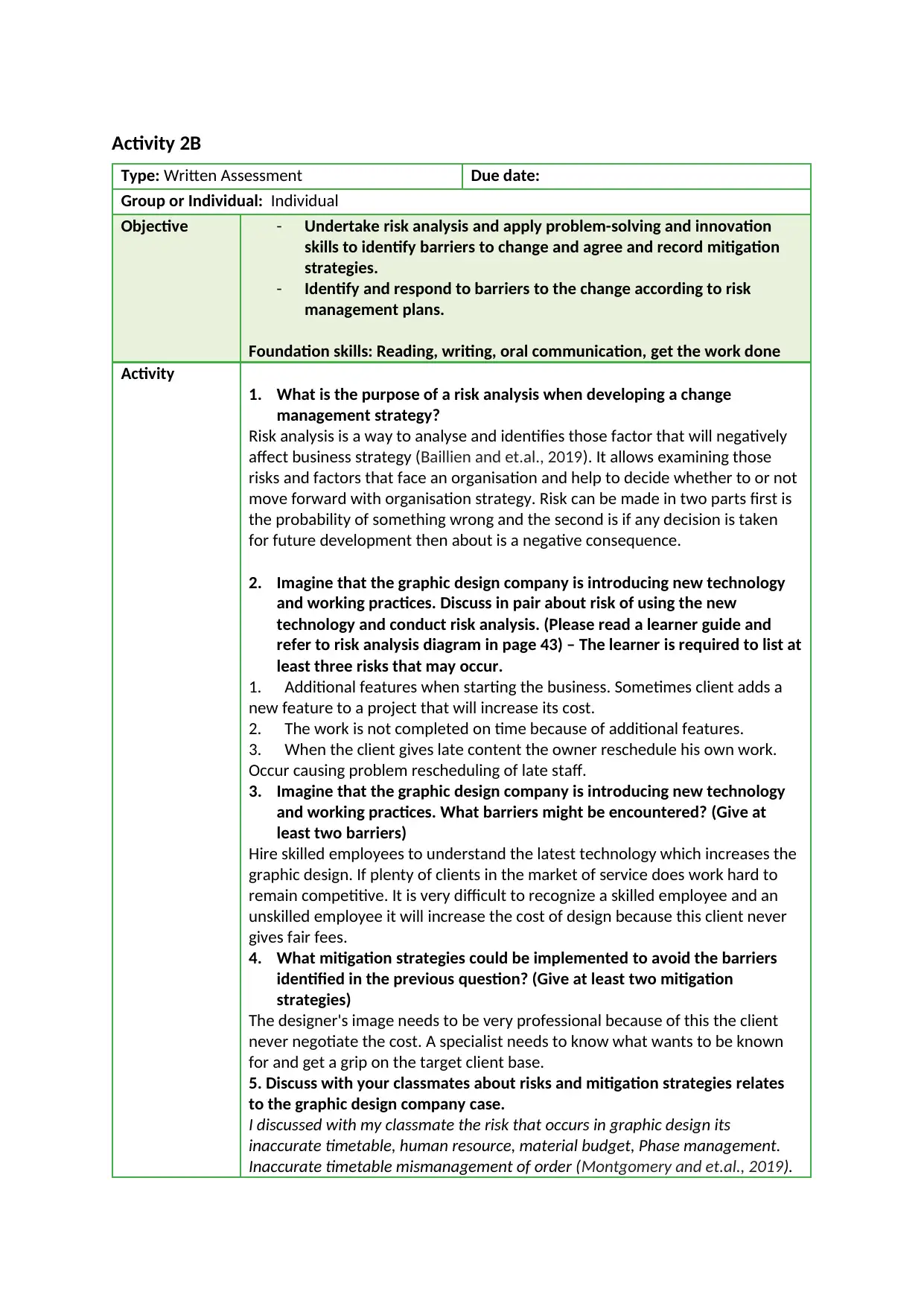
Activity 2B
Type: Written Assessment Due date:
Group or Individual: Individual
Objective - Undertake risk analysis and apply problem-solving and innovation
skills to identify barriers to change and agree and record mitigation
strategies.
- Identify and respond to barriers to the change according to risk
management plans.
Foundation skills: Reading, writing, oral communication, get the work done
Activity
1. What is the purpose of a risk analysis when developing a change
management strategy?
Risk analysis is a way to analyse and identifies those factor that will negatively
affect business strategy (Baillien and et.al., 2019). It allows examining those
risks and factors that face an organisation and help to decide whether to or not
move forward with organisation strategy. Risk can be made in two parts first is
the probability of something wrong and the second is if any decision is taken
for future development then about is a negative consequence.
2. Imagine that the graphic design company is introducing new technology
and working practices. Discuss in pair about risk of using the new
technology and conduct risk analysis. (Please read a learner guide and
refer to risk analysis diagram in page 43) – The learner is required to list at
least three risks that may occur.
1. Additional features when starting the business. Sometimes client adds a
new feature to a project that will increase its cost.
2. The work is not completed on time because of additional features.
3. When the client gives late content the owner reschedule his own work.
Occur causing problem rescheduling of late staff.
3. Imagine that the graphic design company is introducing new technology
and working practices. What barriers might be encountered? (Give at
least two barriers)
Hire skilled employees to understand the latest technology which increases the
graphic design. If plenty of clients in the market of service does work hard to
remain competitive. It is very difficult to recognize a skilled employee and an
unskilled employee it will increase the cost of design because this client never
gives fair fees.
4. What mitigation strategies could be implemented to avoid the barriers
identified in the previous question? (Give at least two mitigation
strategies)
The designer's image needs to be very professional because of this the client
never negotiate the cost. A specialist needs to know what wants to be known
for and get a grip on the target client base.
5. Discuss with your classmates about risks and mitigation strategies relates
to the graphic design company case.
I discussed with my classmate the risk that occurs in graphic design its
inaccurate timetable, human resource, material budget, Phase management.
Inaccurate timetable mismanagement of order (Montgomery and et.al., 2019).
Type: Written Assessment Due date:
Group or Individual: Individual
Objective - Undertake risk analysis and apply problem-solving and innovation
skills to identify barriers to change and agree and record mitigation
strategies.
- Identify and respond to barriers to the change according to risk
management plans.
Foundation skills: Reading, writing, oral communication, get the work done
Activity
1. What is the purpose of a risk analysis when developing a change
management strategy?
Risk analysis is a way to analyse and identifies those factor that will negatively
affect business strategy (Baillien and et.al., 2019). It allows examining those
risks and factors that face an organisation and help to decide whether to or not
move forward with organisation strategy. Risk can be made in two parts first is
the probability of something wrong and the second is if any decision is taken
for future development then about is a negative consequence.
2. Imagine that the graphic design company is introducing new technology
and working practices. Discuss in pair about risk of using the new
technology and conduct risk analysis. (Please read a learner guide and
refer to risk analysis diagram in page 43) – The learner is required to list at
least three risks that may occur.
1. Additional features when starting the business. Sometimes client adds a
new feature to a project that will increase its cost.
2. The work is not completed on time because of additional features.
3. When the client gives late content the owner reschedule his own work.
Occur causing problem rescheduling of late staff.
3. Imagine that the graphic design company is introducing new technology
and working practices. What barriers might be encountered? (Give at
least two barriers)
Hire skilled employees to understand the latest technology which increases the
graphic design. If plenty of clients in the market of service does work hard to
remain competitive. It is very difficult to recognize a skilled employee and an
unskilled employee it will increase the cost of design because this client never
gives fair fees.
4. What mitigation strategies could be implemented to avoid the barriers
identified in the previous question? (Give at least two mitigation
strategies)
The designer's image needs to be very professional because of this the client
never negotiate the cost. A specialist needs to know what wants to be known
for and get a grip on the target client base.
5. Discuss with your classmates about risks and mitigation strategies relates
to the graphic design company case.
I discussed with my classmate the risk that occurs in graphic design its
inaccurate timetable, human resource, material budget, Phase management.
Inaccurate timetable mismanagement of order (Montgomery and et.al., 2019).
Secure Best Marks with AI Grader
Need help grading? Try our AI Grader for instant feedback on your assignments.

By inaccurate timetable, the company outsourced the human resource and will
increase the cost budget.
Note: the trainer/assessor must observe the discussion and make sure that it
matches the marking criteria.
BSBINN601 Lead and Manage organisational change_version 4.0
increase the cost budget.
Note: the trainer/assessor must observe the discussion and make sure that it
matches the marking criteria.
BSBINN601 Lead and Manage organisational change_version 4.0
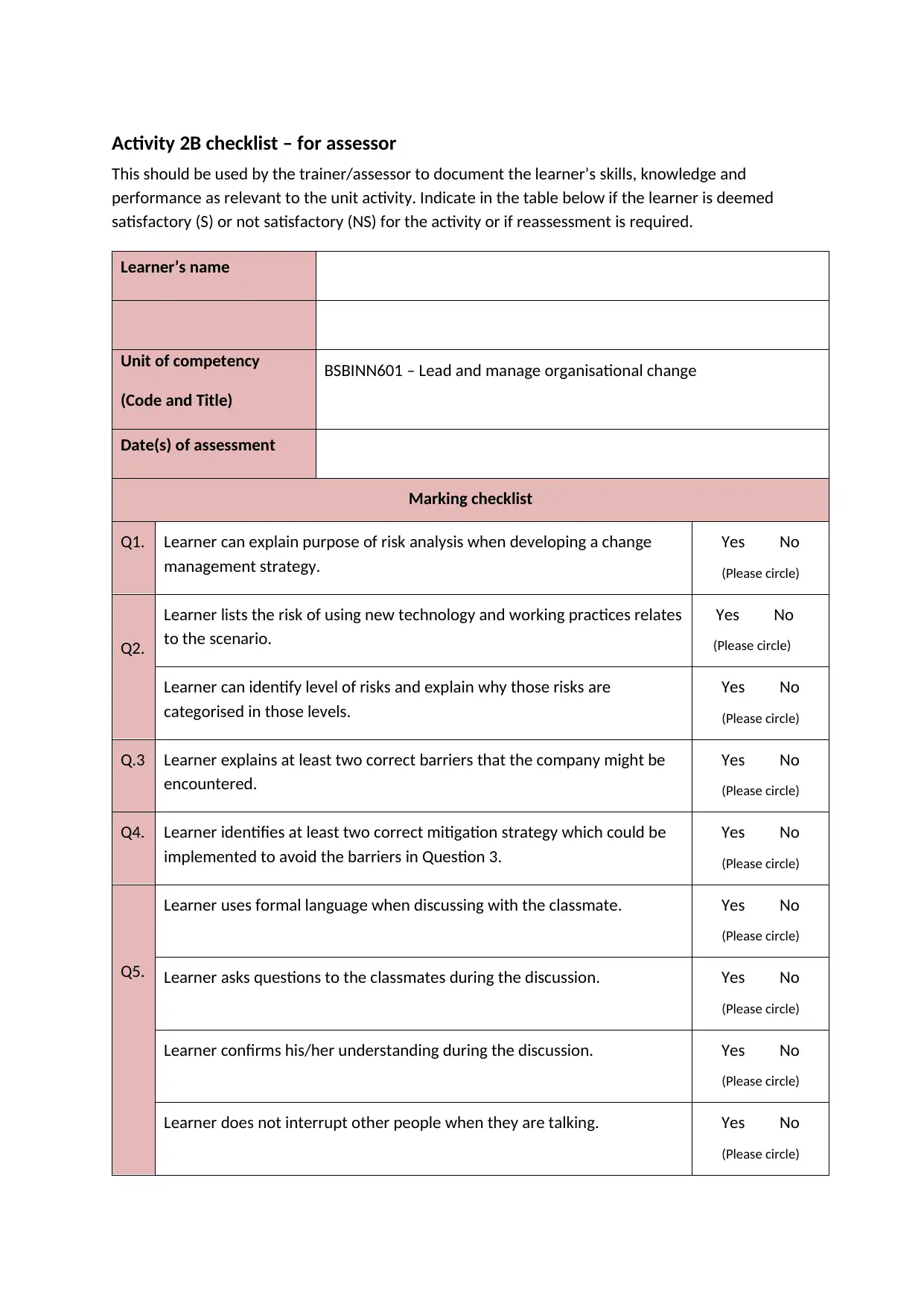
Activity 2B checklist – for assessor
This should be used by the trainer/assessor to document the learner’s skills, knowledge and
performance as relevant to the unit activity. Indicate in the table below if the learner is deemed
satisfactory (S) or not satisfactory (NS) for the activity or if reassessment is required.
Learner’s name
Unit of competency
(Code and Title)
BSBINN601 – Lead and manage organisational change
Date(s) of assessment
Marking checklist
Q1. Learner can explain purpose of risk analysis when developing a change
management strategy.
Yes No
(Please circle)
Q2.
Learner lists the risk of using new technology and working practices relates
to the scenario.
Yes No
(Please circle)
Learner can identify level of risks and explain why those risks are
categorised in those levels.
Yes No
(Please circle)
Q.3 Learner explains at least two correct barriers that the company might be
encountered.
Yes No
(Please circle)
Q4. Learner identifies at least two correct mitigation strategy which could be
implemented to avoid the barriers in Question 3.
Yes No
(Please circle)
Q5.
Learner uses formal language when discussing with the classmate. Yes No
(Please circle)
Learner asks questions to the classmates during the discussion. Yes No
(Please circle)
Learner confirms his/her understanding during the discussion. Yes No
(Please circle)
Learner does not interrupt other people when they are talking. Yes No
(Please circle)
This should be used by the trainer/assessor to document the learner’s skills, knowledge and
performance as relevant to the unit activity. Indicate in the table below if the learner is deemed
satisfactory (S) or not satisfactory (NS) for the activity or if reassessment is required.
Learner’s name
Unit of competency
(Code and Title)
BSBINN601 – Lead and manage organisational change
Date(s) of assessment
Marking checklist
Q1. Learner can explain purpose of risk analysis when developing a change
management strategy.
Yes No
(Please circle)
Q2.
Learner lists the risk of using new technology and working practices relates
to the scenario.
Yes No
(Please circle)
Learner can identify level of risks and explain why those risks are
categorised in those levels.
Yes No
(Please circle)
Q.3 Learner explains at least two correct barriers that the company might be
encountered.
Yes No
(Please circle)
Q4. Learner identifies at least two correct mitigation strategy which could be
implemented to avoid the barriers in Question 3.
Yes No
(Please circle)
Q5.
Learner uses formal language when discussing with the classmate. Yes No
(Please circle)
Learner asks questions to the classmates during the discussion. Yes No
(Please circle)
Learner confirms his/her understanding during the discussion. Yes No
(Please circle)
Learner does not interrupt other people when they are talking. Yes No
(Please circle)
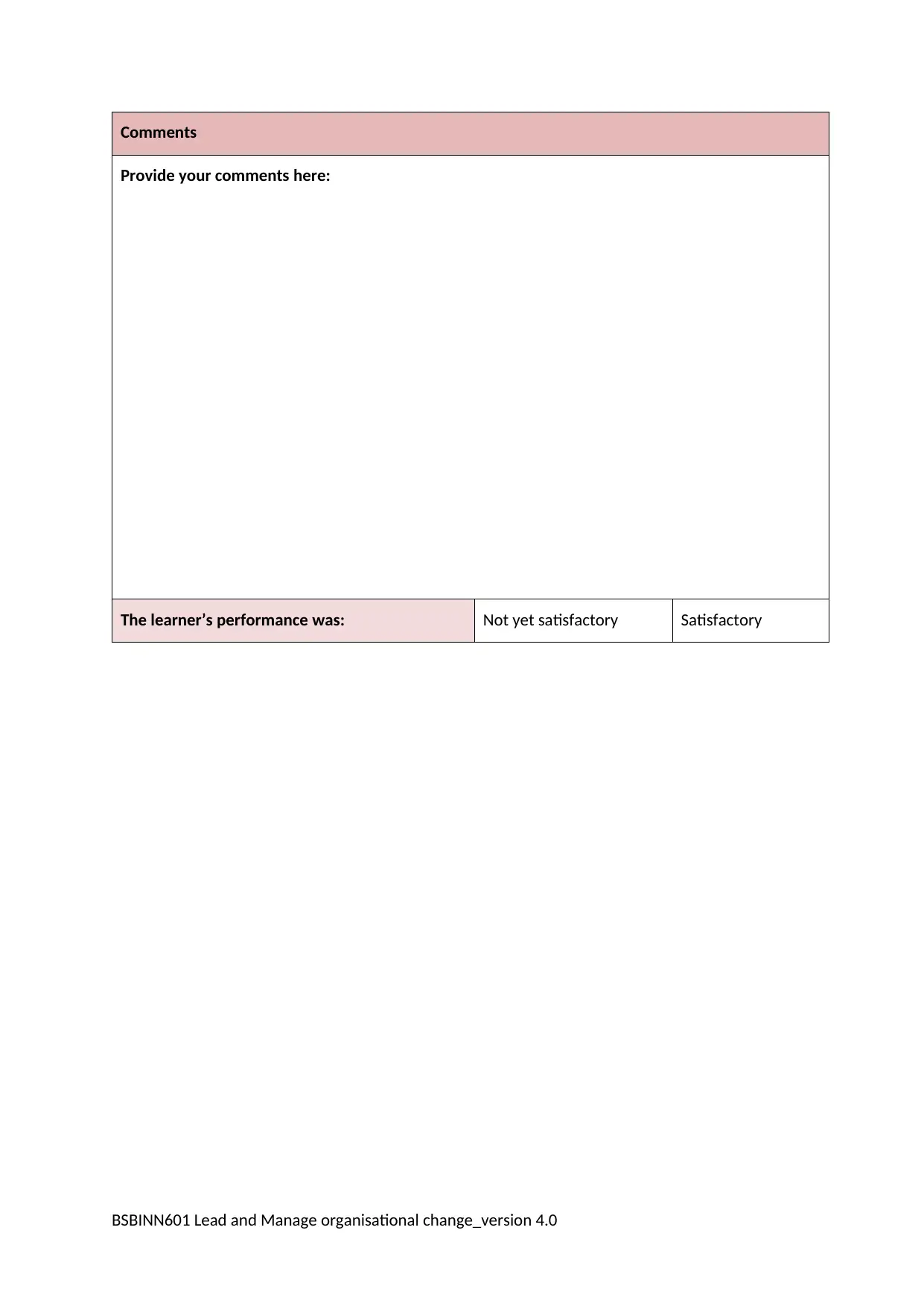
Comments
Provide your comments here:
The learner’s performance was: Not yet satisfactory Satisfactory
BSBINN601 Lead and Manage organisational change_version 4.0
Provide your comments here:
The learner’s performance was: Not yet satisfactory Satisfactory
BSBINN601 Lead and Manage organisational change_version 4.0
Paraphrase This Document
Need a fresh take? Get an instant paraphrase of this document with our AI Paraphraser
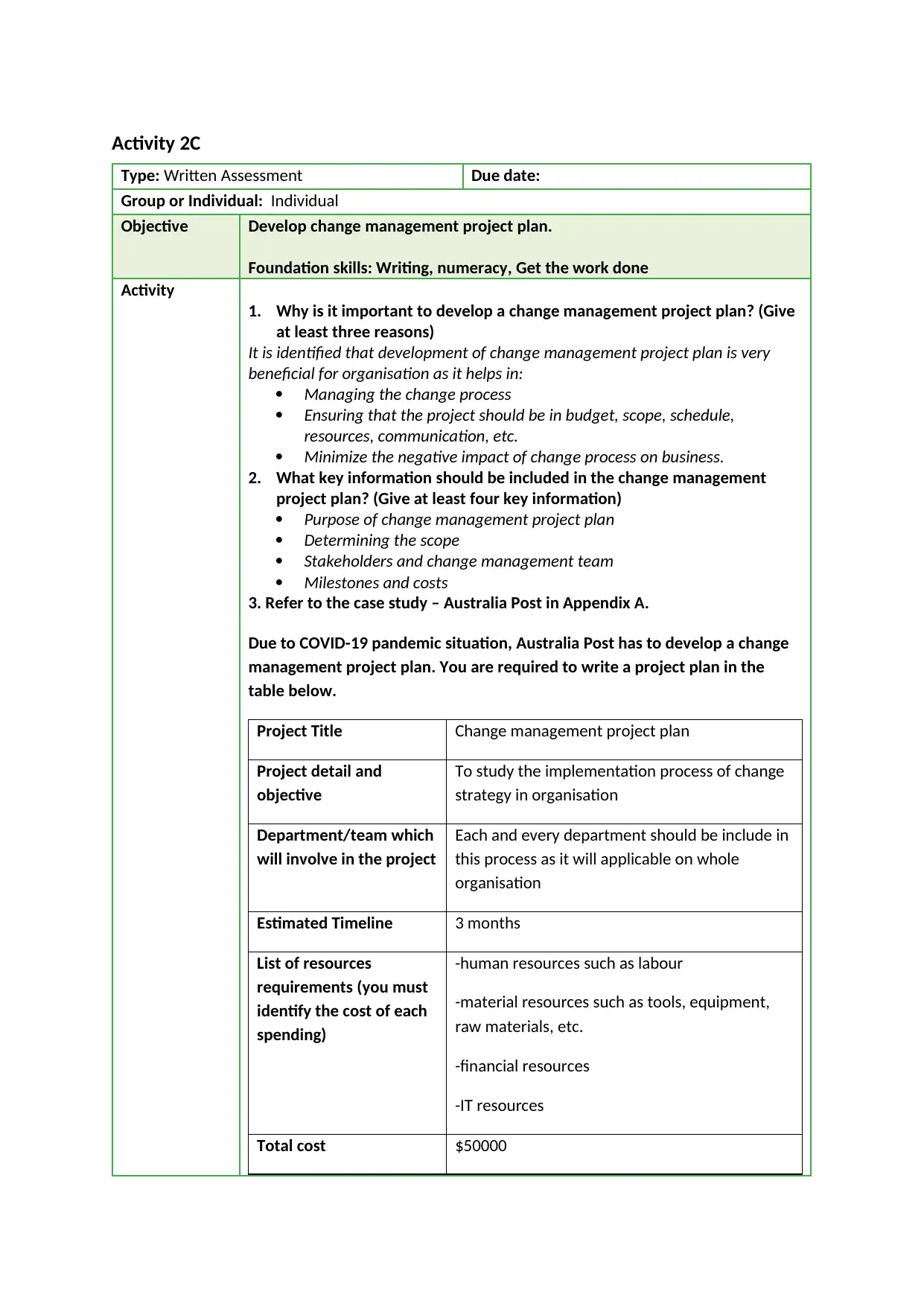
Activity 2C
Type: Written Assessment Due date:
Group or Individual: Individual
Objective Develop change management project plan.
Foundation skills: Writing, numeracy, Get the work done
Activity
1. Why is it important to develop a change management project plan? (Give
at least three reasons)
It is identified that development of change management project plan is very
beneficial for organisation as it helps in:
Managing the change process
Ensuring that the project should be in budget, scope, schedule,
resources, communication, etc.
Minimize the negative impact of change process on business.
2. What key information should be included in the change management
project plan? (Give at least four key information)
Purpose of change management project plan
Determining the scope
Stakeholders and change management team
Milestones and costs
3. Refer to the case study – Australia Post in Appendix A.
Due to COVID-19 pandemic situation, Australia Post has to develop a change
management project plan. You are required to write a project plan in the
table below.
Project Title Change management project plan
Project detail and
objective
To study the implementation process of change
strategy in organisation
Department/team which
will involve in the project
Each and every department should be include in
this process as it will applicable on whole
organisation
Estimated Timeline 3 months
List of resources
requirements (you must
identify the cost of each
spending)
-human resources such as labour
-material resources such as tools, equipment,
raw materials, etc.
-financial resources
-IT resources
Total cost $50000
Type: Written Assessment Due date:
Group or Individual: Individual
Objective Develop change management project plan.
Foundation skills: Writing, numeracy, Get the work done
Activity
1. Why is it important to develop a change management project plan? (Give
at least three reasons)
It is identified that development of change management project plan is very
beneficial for organisation as it helps in:
Managing the change process
Ensuring that the project should be in budget, scope, schedule,
resources, communication, etc.
Minimize the negative impact of change process on business.
2. What key information should be included in the change management
project plan? (Give at least four key information)
Purpose of change management project plan
Determining the scope
Stakeholders and change management team
Milestones and costs
3. Refer to the case study – Australia Post in Appendix A.
Due to COVID-19 pandemic situation, Australia Post has to develop a change
management project plan. You are required to write a project plan in the
table below.
Project Title Change management project plan
Project detail and
objective
To study the implementation process of change
strategy in organisation
Department/team which
will involve in the project
Each and every department should be include in
this process as it will applicable on whole
organisation
Estimated Timeline 3 months
List of resources
requirements (you must
identify the cost of each
spending)
-human resources such as labour
-material resources such as tools, equipment,
raw materials, etc.
-financial resources
-IT resources
Total cost $50000

Risk -High level of resistance
-Lack of commitment of stakeholders
-Budgeting risk
Risk management
strategies
- Avoid it.
- Reduce it.
- Transfer it.
- Accept it.
BSBINN601 Lead and Manage organisational change_version 4.0
-Lack of commitment of stakeholders
-Budgeting risk
Risk management
strategies
- Avoid it.
- Reduce it.
- Transfer it.
- Accept it.
BSBINN601 Lead and Manage organisational change_version 4.0
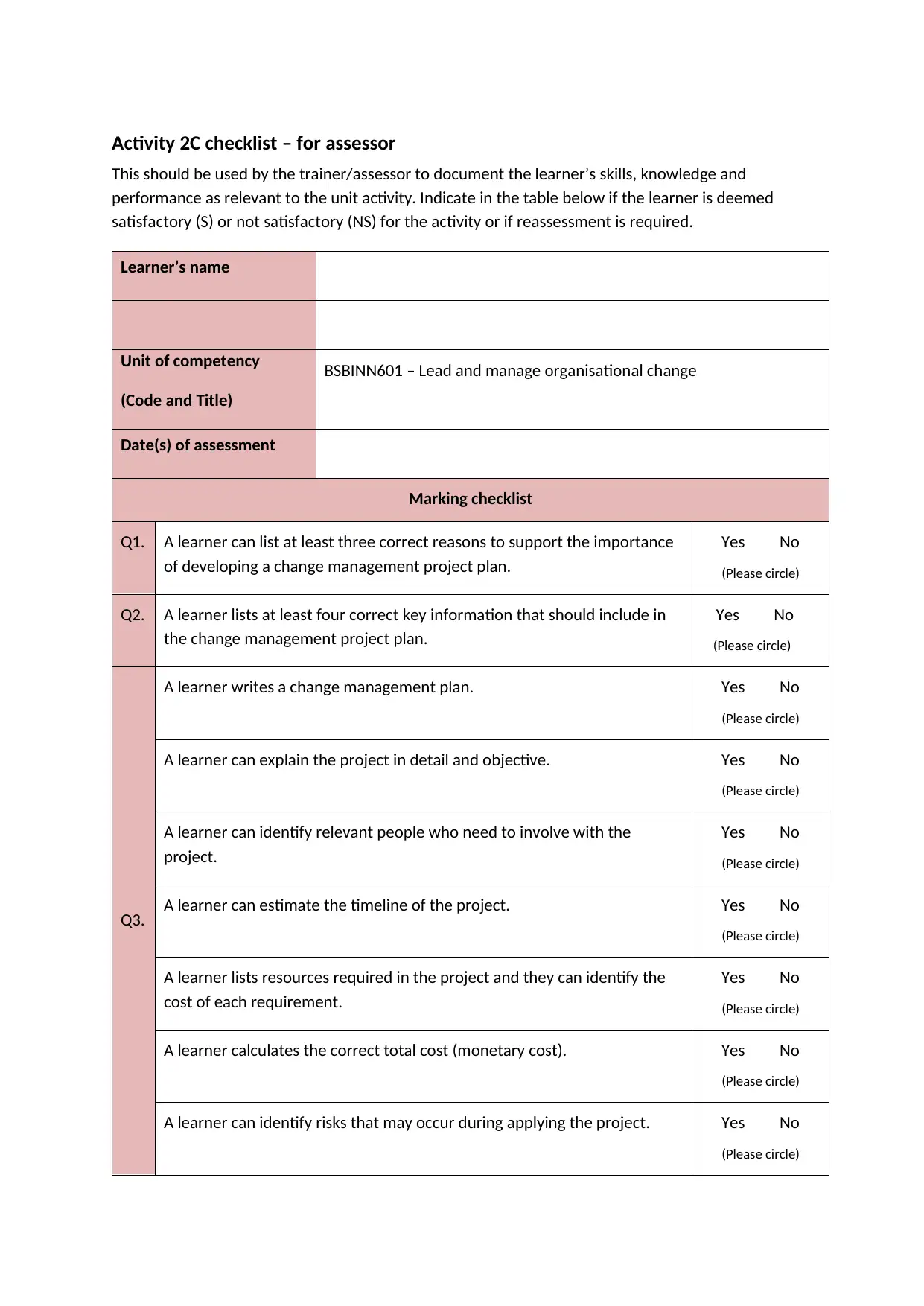
Activity 2C checklist – for assessor
This should be used by the trainer/assessor to document the learner’s skills, knowledge and
performance as relevant to the unit activity. Indicate in the table below if the learner is deemed
satisfactory (S) or not satisfactory (NS) for the activity or if reassessment is required.
Learner’s name
Unit of competency
(Code and Title)
BSBINN601 – Lead and manage organisational change
Date(s) of assessment
Marking checklist
Q1. A learner can list at least three correct reasons to support the importance
of developing a change management project plan.
Yes No
(Please circle)
Q2. A learner lists at least four correct key information that should include in
the change management project plan.
Yes No
(Please circle)
Q3.
A learner writes a change management plan. Yes No
(Please circle)
A learner can explain the project in detail and objective. Yes No
(Please circle)
A learner can identify relevant people who need to involve with the
project.
Yes No
(Please circle)
A learner can estimate the timeline of the project. Yes No
(Please circle)
A learner lists resources required in the project and they can identify the
cost of each requirement.
Yes No
(Please circle)
A learner calculates the correct total cost (monetary cost). Yes No
(Please circle)
A learner can identify risks that may occur during applying the project. Yes No
(Please circle)
This should be used by the trainer/assessor to document the learner’s skills, knowledge and
performance as relevant to the unit activity. Indicate in the table below if the learner is deemed
satisfactory (S) or not satisfactory (NS) for the activity or if reassessment is required.
Learner’s name
Unit of competency
(Code and Title)
BSBINN601 – Lead and manage organisational change
Date(s) of assessment
Marking checklist
Q1. A learner can list at least three correct reasons to support the importance
of developing a change management project plan.
Yes No
(Please circle)
Q2. A learner lists at least four correct key information that should include in
the change management project plan.
Yes No
(Please circle)
Q3.
A learner writes a change management plan. Yes No
(Please circle)
A learner can explain the project in detail and objective. Yes No
(Please circle)
A learner can identify relevant people who need to involve with the
project.
Yes No
(Please circle)
A learner can estimate the timeline of the project. Yes No
(Please circle)
A learner lists resources required in the project and they can identify the
cost of each requirement.
Yes No
(Please circle)
A learner calculates the correct total cost (monetary cost). Yes No
(Please circle)
A learner can identify risks that may occur during applying the project. Yes No
(Please circle)
Secure Best Marks with AI Grader
Need help grading? Try our AI Grader for instant feedback on your assignments.
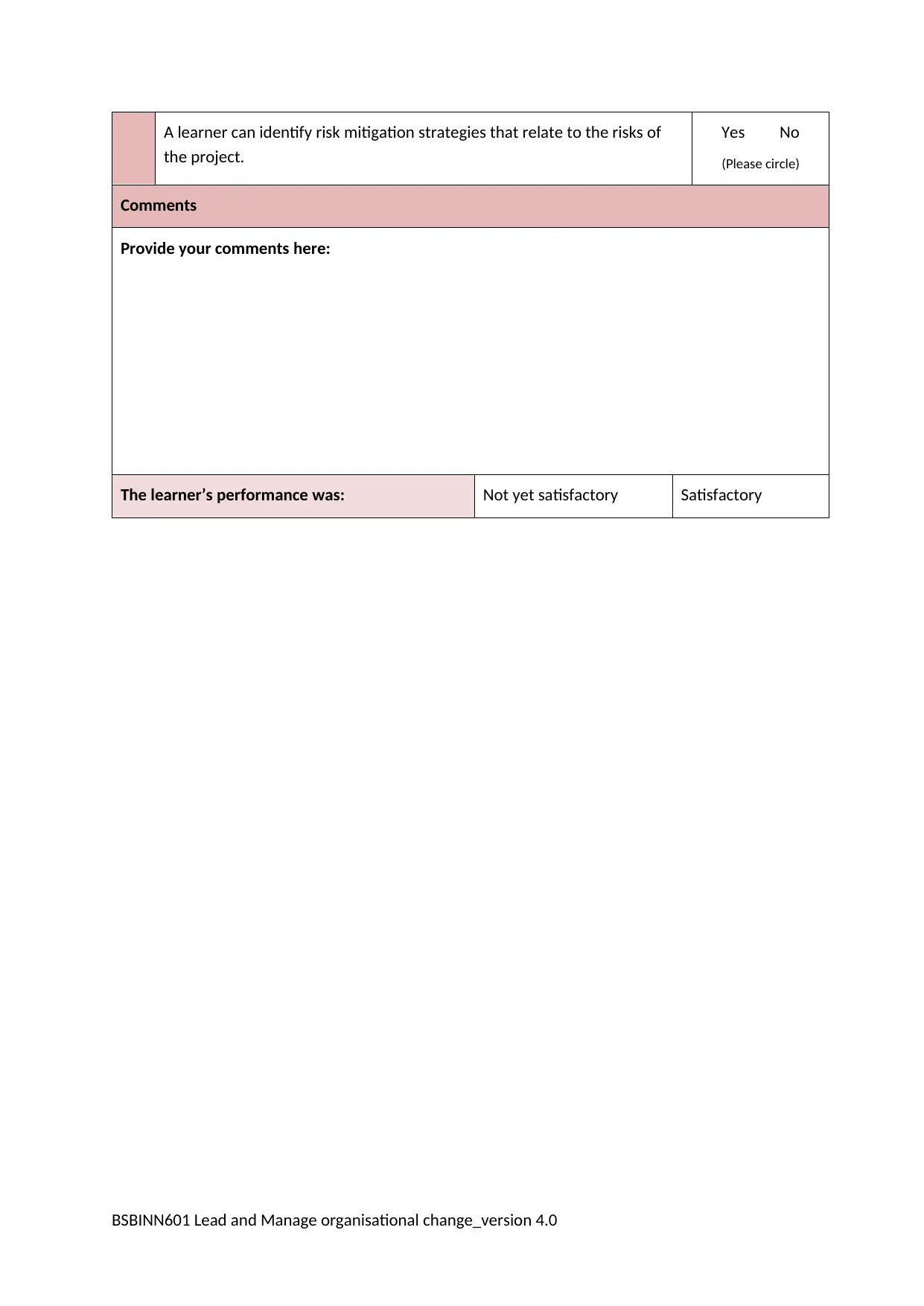
A learner can identify risk mitigation strategies that relate to the risks of
the project.
Yes No
(Please circle)
Comments
Provide your comments here:
The learner’s performance was: Not yet satisfactory Satisfactory
BSBINN601 Lead and Manage organisational change_version 4.0
the project.
Yes No
(Please circle)
Comments
Provide your comments here:
The learner’s performance was: Not yet satisfactory Satisfactory
BSBINN601 Lead and Manage organisational change_version 4.0
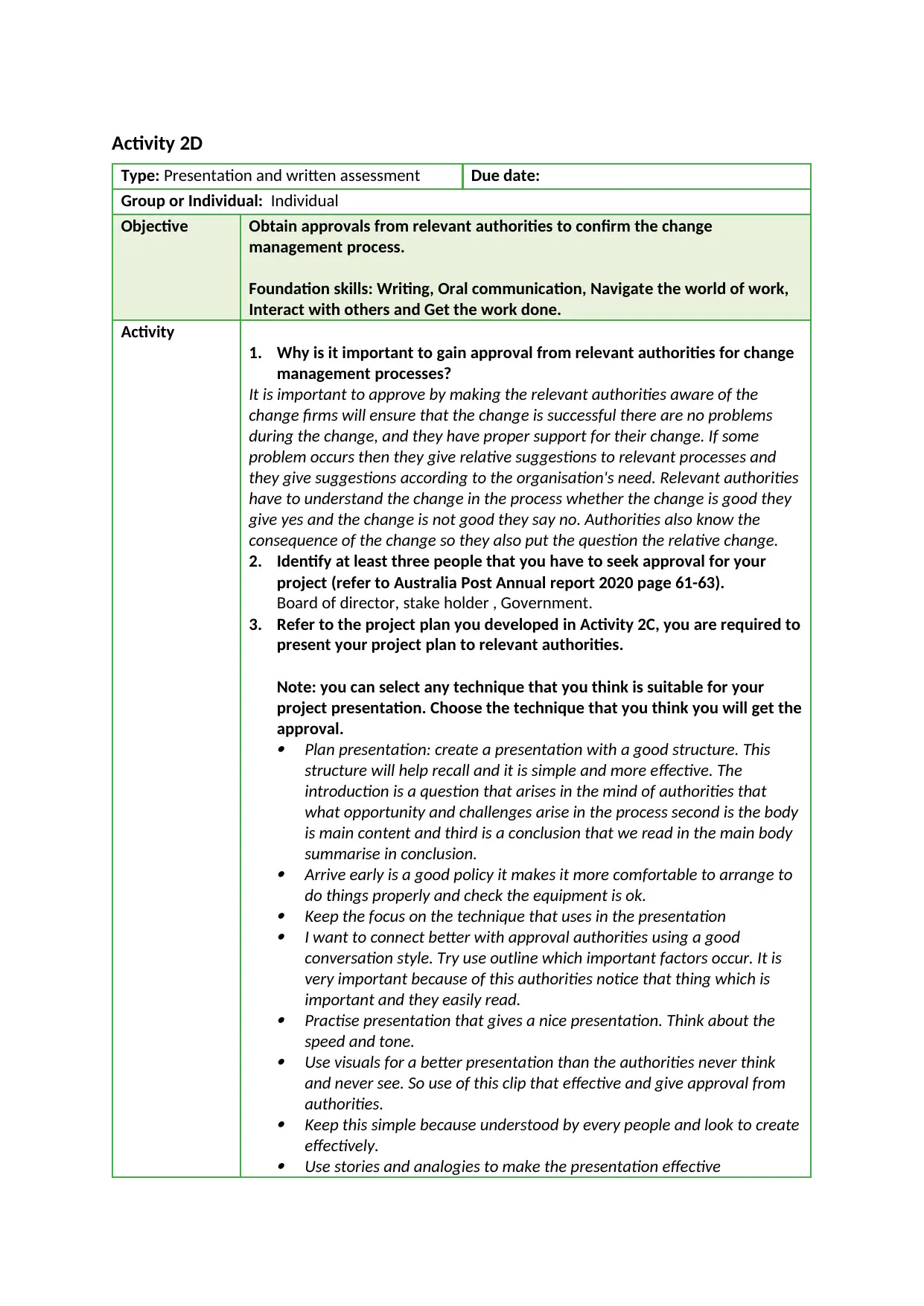
Activity 2D
Type: Presentation and written assessment Due date:
Group or Individual: Individual
Objective Obtain approvals from relevant authorities to confirm the change
management process.
Foundation skills: Writing, Oral communication, Navigate the world of work,
Interact with others and Get the work done.
Activity
1. Why is it important to gain approval from relevant authorities for change
management processes?
It is important to approve by making the relevant authorities aware of the
change firms will ensure that the change is successful there are no problems
during the change, and they have proper support for their change. If some
problem occurs then they give relative suggestions to relevant processes and
they give suggestions according to the organisation's need. Relevant authorities
have to understand the change in the process whether the change is good they
give yes and the change is not good they say no. Authorities also know the
consequence of the change so they also put the question the relative change.
2. Identify at least three people that you have to seek approval for your
project (refer to Australia Post Annual report 2020 page 61-63).
Board of director, stake holder , Government.
3. Refer to the project plan you developed in Activity 2C, you are required to
present your project plan to relevant authorities.
Note: you can select any technique that you think is suitable for your
project presentation. Choose the technique that you think you will get the
approval.
Plan presentation: create a presentation with a good structure. This
structure will help recall and it is simple and more effective. The
introduction is a question that arises in the mind of authorities that
what opportunity and challenges arise in the process second is the body
is main content and third is a conclusion that we read in the main body
summarise in conclusion.
Arrive early is a good policy it makes it more comfortable to arrange to
do things properly and check the equipment is ok.
Keep the focus on the technique that uses in the presentation
I want to connect better with approval authorities using a good
conversation style. Try use outline which important factors occur. It is
very important because of this authorities notice that thing which is
important and they easily read.
Practise presentation that gives a nice presentation. Think about the
speed and tone.
Use visuals for a better presentation than the authorities never think
and never see. So use of this clip that effective and give approval from
authorities.
Keep this simple because understood by every people and look to create
effectively.
Use stories and analogies to make the presentation effective
Type: Presentation and written assessment Due date:
Group or Individual: Individual
Objective Obtain approvals from relevant authorities to confirm the change
management process.
Foundation skills: Writing, Oral communication, Navigate the world of work,
Interact with others and Get the work done.
Activity
1. Why is it important to gain approval from relevant authorities for change
management processes?
It is important to approve by making the relevant authorities aware of the
change firms will ensure that the change is successful there are no problems
during the change, and they have proper support for their change. If some
problem occurs then they give relative suggestions to relevant processes and
they give suggestions according to the organisation's need. Relevant authorities
have to understand the change in the process whether the change is good they
give yes and the change is not good they say no. Authorities also know the
consequence of the change so they also put the question the relative change.
2. Identify at least three people that you have to seek approval for your
project (refer to Australia Post Annual report 2020 page 61-63).
Board of director, stake holder , Government.
3. Refer to the project plan you developed in Activity 2C, you are required to
present your project plan to relevant authorities.
Note: you can select any technique that you think is suitable for your
project presentation. Choose the technique that you think you will get the
approval.
Plan presentation: create a presentation with a good structure. This
structure will help recall and it is simple and more effective. The
introduction is a question that arises in the mind of authorities that
what opportunity and challenges arise in the process second is the body
is main content and third is a conclusion that we read in the main body
summarise in conclusion.
Arrive early is a good policy it makes it more comfortable to arrange to
do things properly and check the equipment is ok.
Keep the focus on the technique that uses in the presentation
I want to connect better with approval authorities using a good
conversation style. Try use outline which important factors occur. It is
very important because of this authorities notice that thing which is
important and they easily read.
Practise presentation that gives a nice presentation. Think about the
speed and tone.
Use visuals for a better presentation than the authorities never think
and never see. So use of this clip that effective and give approval from
authorities.
Keep this simple because understood by every people and look to create
effectively.
Use stories and analogies to make the presentation effective

Make sure to provide a copy of the presentation because it creates a
separate handout with detail.
BSBINN601 Lead and Manage organisational change_version 4.0
separate handout with detail.
BSBINN601 Lead and Manage organisational change_version 4.0
Paraphrase This Document
Need a fresh take? Get an instant paraphrase of this document with our AI Paraphraser
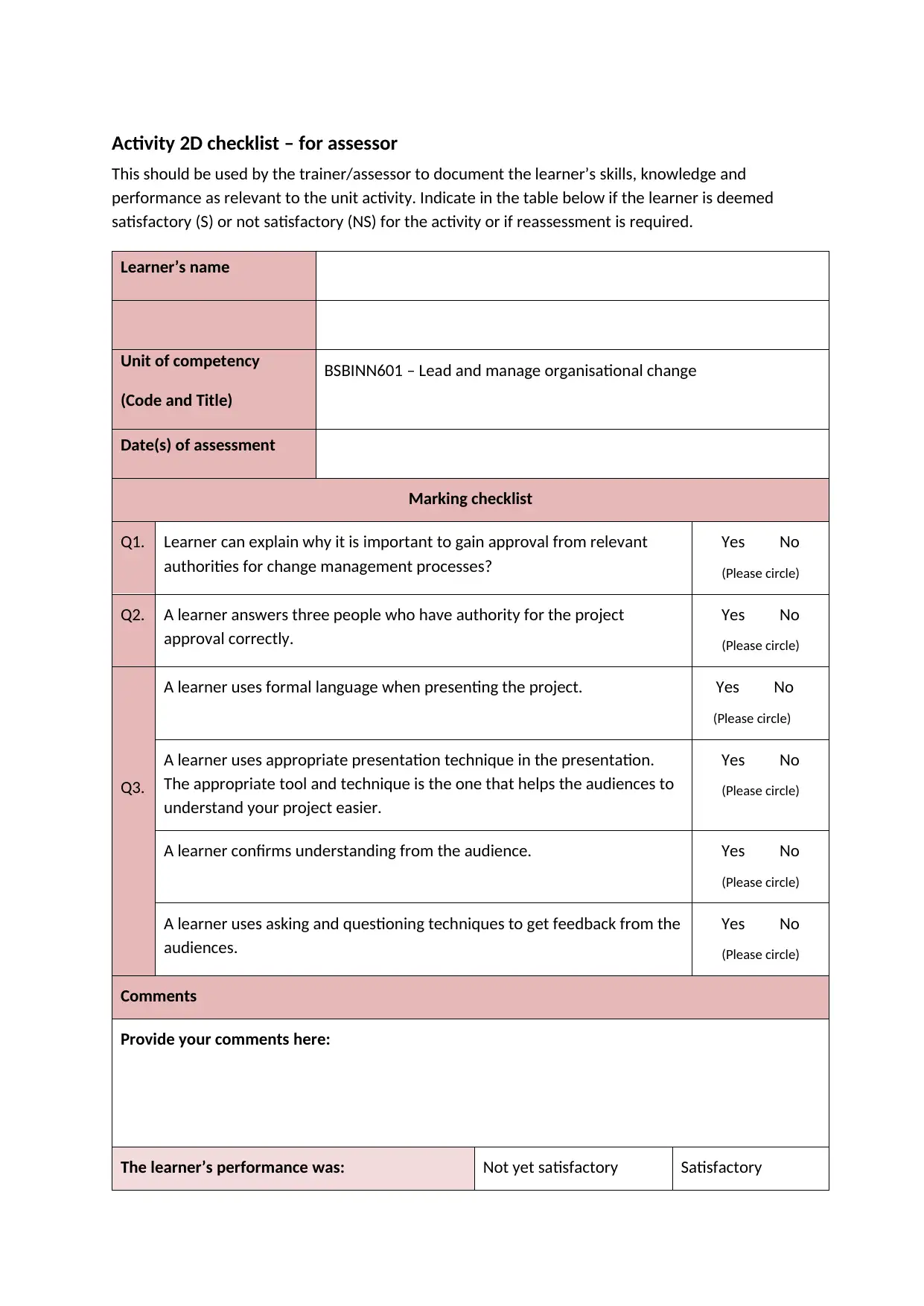
Activity 2D checklist – for assessor
This should be used by the trainer/assessor to document the learner’s skills, knowledge and
performance as relevant to the unit activity. Indicate in the table below if the learner is deemed
satisfactory (S) or not satisfactory (NS) for the activity or if reassessment is required.
Learner’s name
Unit of competency
(Code and Title)
BSBINN601 – Lead and manage organisational change
Date(s) of assessment
Marking checklist
Q1. Learner can explain why it is important to gain approval from relevant
authorities for change management processes?
Yes No
(Please circle)
Q2. A learner answers three people who have authority for the project
approval correctly.
Yes No
(Please circle)
Q3.
A learner uses formal language when presenting the project. Yes No
(Please circle)
A learner uses appropriate presentation technique in the presentation.
The appropriate tool and technique is the one that helps the audiences to
understand your project easier.
Yes No
(Please circle)
A learner confirms understanding from the audience. Yes No
(Please circle)
A learner uses asking and questioning techniques to get feedback from the
audiences.
Yes No
(Please circle)
Comments
Provide your comments here:
The learner’s performance was: Not yet satisfactory Satisfactory
This should be used by the trainer/assessor to document the learner’s skills, knowledge and
performance as relevant to the unit activity. Indicate in the table below if the learner is deemed
satisfactory (S) or not satisfactory (NS) for the activity or if reassessment is required.
Learner’s name
Unit of competency
(Code and Title)
BSBINN601 – Lead and manage organisational change
Date(s) of assessment
Marking checklist
Q1. Learner can explain why it is important to gain approval from relevant
authorities for change management processes?
Yes No
(Please circle)
Q2. A learner answers three people who have authority for the project
approval correctly.
Yes No
(Please circle)
Q3.
A learner uses formal language when presenting the project. Yes No
(Please circle)
A learner uses appropriate presentation technique in the presentation.
The appropriate tool and technique is the one that helps the audiences to
understand your project easier.
Yes No
(Please circle)
A learner confirms understanding from the audience. Yes No
(Please circle)
A learner uses asking and questioning techniques to get feedback from the
audiences.
Yes No
(Please circle)
Comments
Provide your comments here:
The learner’s performance was: Not yet satisfactory Satisfactory
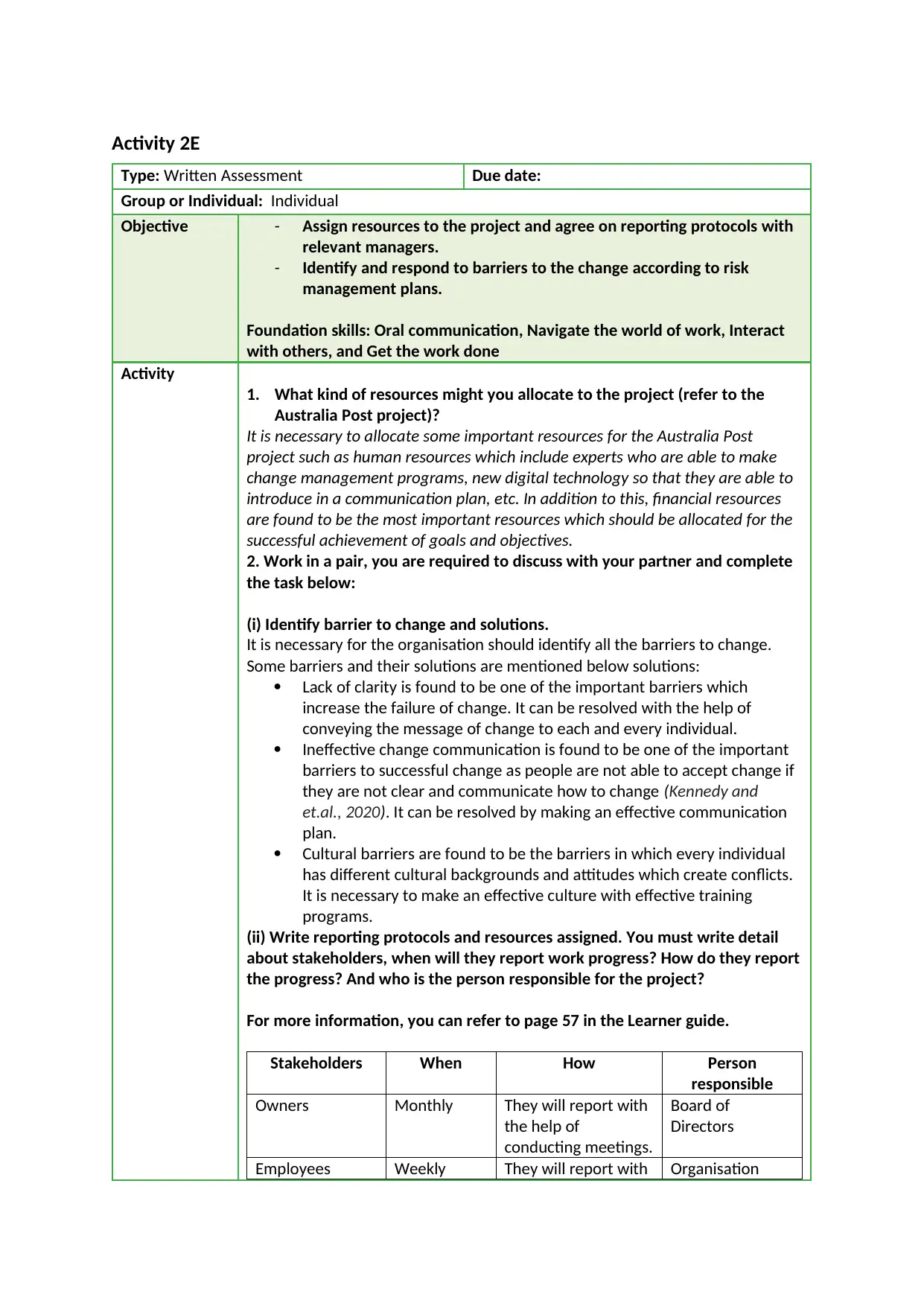
Activity 2E
Type: Written Assessment Due date:
Group or Individual: Individual
Objective - Assign resources to the project and agree on reporting protocols with
relevant managers.
- Identify and respond to barriers to the change according to risk
management plans.
Foundation skills: Oral communication, Navigate the world of work, Interact
with others, and Get the work done
Activity
1. What kind of resources might you allocate to the project (refer to the
Australia Post project)?
It is necessary to allocate some important resources for the Australia Post
project such as human resources which include experts who are able to make
change management programs, new digital technology so that they are able to
introduce in a communication plan, etc. In addition to this, financial resources
are found to be the most important resources which should be allocated for the
successful achievement of goals and objectives.
2. Work in a pair, you are required to discuss with your partner and complete
the task below:
(i) Identify barrier to change and solutions.
It is necessary for the organisation should identify all the barriers to change.
Some barriers and their solutions are mentioned below solutions:
Lack of clarity is found to be one of the important barriers which
increase the failure of change. It can be resolved with the help of
conveying the message of change to each and every individual.
Ineffective change communication is found to be one of the important
barriers to successful change as people are not able to accept change if
they are not clear and communicate how to change (Kennedy and
et.al., 2020). It can be resolved by making an effective communication
plan.
Cultural barriers are found to be the barriers in which every individual
has different cultural backgrounds and attitudes which create conflicts.
It is necessary to make an effective culture with effective training
programs.
(ii) Write reporting protocols and resources assigned. You must write detail
about stakeholders, when will they report work progress? How do they report
the progress? And who is the person responsible for the project?
For more information, you can refer to page 57 in the Learner guide.
Stakeholders When How Person
responsible
Owners Monthly They will report with
the help of
conducting meetings.
Board of
Directors
Employees Weekly They will report with Organisation
Type: Written Assessment Due date:
Group or Individual: Individual
Objective - Assign resources to the project and agree on reporting protocols with
relevant managers.
- Identify and respond to barriers to the change according to risk
management plans.
Foundation skills: Oral communication, Navigate the world of work, Interact
with others, and Get the work done
Activity
1. What kind of resources might you allocate to the project (refer to the
Australia Post project)?
It is necessary to allocate some important resources for the Australia Post
project such as human resources which include experts who are able to make
change management programs, new digital technology so that they are able to
introduce in a communication plan, etc. In addition to this, financial resources
are found to be the most important resources which should be allocated for the
successful achievement of goals and objectives.
2. Work in a pair, you are required to discuss with your partner and complete
the task below:
(i) Identify barrier to change and solutions.
It is necessary for the organisation should identify all the barriers to change.
Some barriers and their solutions are mentioned below solutions:
Lack of clarity is found to be one of the important barriers which
increase the failure of change. It can be resolved with the help of
conveying the message of change to each and every individual.
Ineffective change communication is found to be one of the important
barriers to successful change as people are not able to accept change if
they are not clear and communicate how to change (Kennedy and
et.al., 2020). It can be resolved by making an effective communication
plan.
Cultural barriers are found to be the barriers in which every individual
has different cultural backgrounds and attitudes which create conflicts.
It is necessary to make an effective culture with effective training
programs.
(ii) Write reporting protocols and resources assigned. You must write detail
about stakeholders, when will they report work progress? How do they report
the progress? And who is the person responsible for the project?
For more information, you can refer to page 57 in the Learner guide.
Stakeholders When How Person
responsible
Owners Monthly They will report with
the help of
conducting meetings.
Board of
Directors
Employees Weekly They will report with Organisation

the help of audit. owners
Government Half yearly They will report with
the help of
announcement in
notices.
State
government and
assembly
Consumers Annually They will report with
the help of providing
feedback.
Organisational
feedback
portfolio
Note:
- Stakeholder is the person who you need to communicate/report to.
- When is how frequently do you need to report such as monthly, weekly,
annually, etc.
- How is the method, technique that you select to report the stakeholders?
- Person responsible is the person who is responsible for developing the
report.
BSBINN601 Lead and Manage organisational change_version 4.0
Government Half yearly They will report with
the help of
announcement in
notices.
State
government and
assembly
Consumers Annually They will report with
the help of providing
feedback.
Organisational
feedback
portfolio
Note:
- Stakeholder is the person who you need to communicate/report to.
- When is how frequently do you need to report such as monthly, weekly,
annually, etc.
- How is the method, technique that you select to report the stakeholders?
- Person responsible is the person who is responsible for developing the
report.
BSBINN601 Lead and Manage organisational change_version 4.0
Secure Best Marks with AI Grader
Need help grading? Try our AI Grader for instant feedback on your assignments.
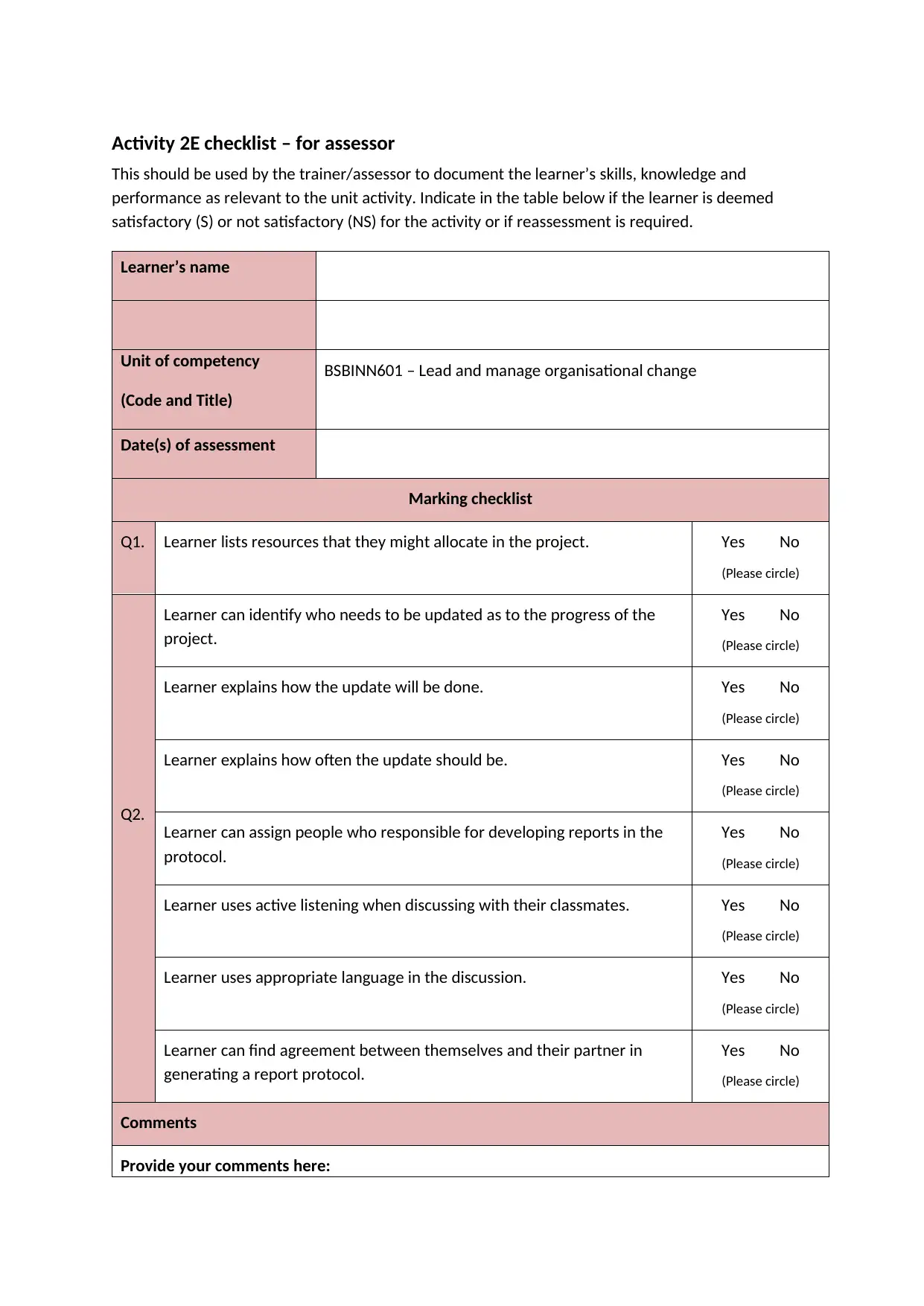
Activity 2E checklist – for assessor
This should be used by the trainer/assessor to document the learner’s skills, knowledge and
performance as relevant to the unit activity. Indicate in the table below if the learner is deemed
satisfactory (S) or not satisfactory (NS) for the activity or if reassessment is required.
Learner’s name
Unit of competency
(Code and Title)
BSBINN601 – Lead and manage organisational change
Date(s) of assessment
Marking checklist
Q1. Learner lists resources that they might allocate in the project. Yes No
(Please circle)
Q2.
Learner can identify who needs to be updated as to the progress of the
project.
Yes No
(Please circle)
Learner explains how the update will be done. Yes No
(Please circle)
Learner explains how often the update should be. Yes No
(Please circle)
Learner can assign people who responsible for developing reports in the
protocol.
Yes No
(Please circle)
Learner uses active listening when discussing with their classmates. Yes No
(Please circle)
Learner uses appropriate language in the discussion. Yes No
(Please circle)
Learner can find agreement between themselves and their partner in
generating a report protocol.
Yes No
(Please circle)
Comments
Provide your comments here:
This should be used by the trainer/assessor to document the learner’s skills, knowledge and
performance as relevant to the unit activity. Indicate in the table below if the learner is deemed
satisfactory (S) or not satisfactory (NS) for the activity or if reassessment is required.
Learner’s name
Unit of competency
(Code and Title)
BSBINN601 – Lead and manage organisational change
Date(s) of assessment
Marking checklist
Q1. Learner lists resources that they might allocate in the project. Yes No
(Please circle)
Q2.
Learner can identify who needs to be updated as to the progress of the
project.
Yes No
(Please circle)
Learner explains how the update will be done. Yes No
(Please circle)
Learner explains how often the update should be. Yes No
(Please circle)
Learner can assign people who responsible for developing reports in the
protocol.
Yes No
(Please circle)
Learner uses active listening when discussing with their classmates. Yes No
(Please circle)
Learner uses appropriate language in the discussion. Yes No
(Please circle)
Learner can find agreement between themselves and their partner in
generating a report protocol.
Yes No
(Please circle)
Comments
Provide your comments here:

The learner’s performance was: Not yet satisfactory Satisfactory
BSBINN601 Lead and Manage organisational change_version 4.0
BSBINN601 Lead and Manage organisational change_version 4.0

BSBINN601 Lead and Manage organisational change_version 4.0
Paraphrase This Document
Need a fresh take? Get an instant paraphrase of this document with our AI Paraphraser
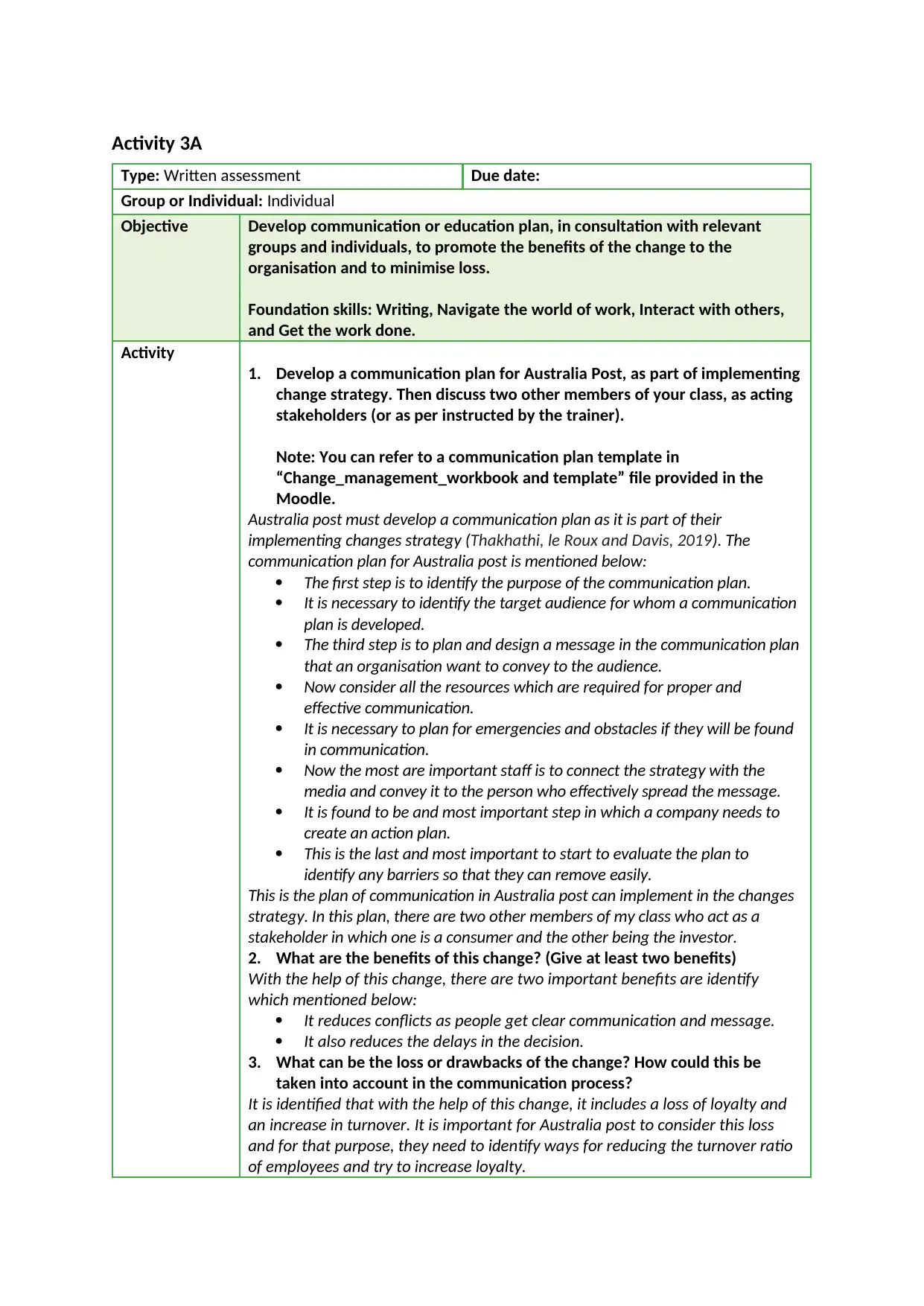
Activity 3A
Type: Written assessment Due date:
Group or Individual: Individual
Objective Develop communication or education plan, in consultation with relevant
groups and individuals, to promote the benefits of the change to the
organisation and to minimise loss.
Foundation skills: Writing, Navigate the world of work, Interact with others,
and Get the work done.
Activity
1. Develop a communication plan for Australia Post, as part of implementing
change strategy. Then discuss two other members of your class, as acting
stakeholders (or as per instructed by the trainer).
Note: You can refer to a communication plan template in
“Change_management_workbook and template” file provided in the
Moodle.
Australia post must develop a communication plan as it is part of their
implementing changes strategy (Thakhathi, le Roux and Davis, 2019). The
communication plan for Australia post is mentioned below:
The first step is to identify the purpose of the communication plan.
It is necessary to identify the target audience for whom a communication
plan is developed.
The third step is to plan and design a message in the communication plan
that an organisation want to convey to the audience.
Now consider all the resources which are required for proper and
effective communication.
It is necessary to plan for emergencies and obstacles if they will be found
in communication.
Now the most are important staff is to connect the strategy with the
media and convey it to the person who effectively spread the message.
It is found to be and most important step in which a company needs to
create an action plan.
This is the last and most important to start to evaluate the plan to
identify any barriers so that they can remove easily.
This is the plan of communication in Australia post can implement in the changes
strategy. In this plan, there are two other members of my class who act as a
stakeholder in which one is a consumer and the other being the investor.
2. What are the benefits of this change? (Give at least two benefits)
With the help of this change, there are two important benefits are identify
which mentioned below:
It reduces conflicts as people get clear communication and message.
It also reduces the delays in the decision.
3. What can be the loss or drawbacks of the change? How could this be
taken into account in the communication process?
It is identified that with the help of this change, it includes a loss of loyalty and
an increase in turnover. It is important for Australia post to consider this loss
and for that purpose, they need to identify ways for reducing the turnover ratio
of employees and try to increase loyalty.
Type: Written assessment Due date:
Group or Individual: Individual
Objective Develop communication or education plan, in consultation with relevant
groups and individuals, to promote the benefits of the change to the
organisation and to minimise loss.
Foundation skills: Writing, Navigate the world of work, Interact with others,
and Get the work done.
Activity
1. Develop a communication plan for Australia Post, as part of implementing
change strategy. Then discuss two other members of your class, as acting
stakeholders (or as per instructed by the trainer).
Note: You can refer to a communication plan template in
“Change_management_workbook and template” file provided in the
Moodle.
Australia post must develop a communication plan as it is part of their
implementing changes strategy (Thakhathi, le Roux and Davis, 2019). The
communication plan for Australia post is mentioned below:
The first step is to identify the purpose of the communication plan.
It is necessary to identify the target audience for whom a communication
plan is developed.
The third step is to plan and design a message in the communication plan
that an organisation want to convey to the audience.
Now consider all the resources which are required for proper and
effective communication.
It is necessary to plan for emergencies and obstacles if they will be found
in communication.
Now the most are important staff is to connect the strategy with the
media and convey it to the person who effectively spread the message.
It is found to be and most important step in which a company needs to
create an action plan.
This is the last and most important to start to evaluate the plan to
identify any barriers so that they can remove easily.
This is the plan of communication in Australia post can implement in the changes
strategy. In this plan, there are two other members of my class who act as a
stakeholder in which one is a consumer and the other being the investor.
2. What are the benefits of this change? (Give at least two benefits)
With the help of this change, there are two important benefits are identify
which mentioned below:
It reduces conflicts as people get clear communication and message.
It also reduces the delays in the decision.
3. What can be the loss or drawbacks of the change? How could this be
taken into account in the communication process?
It is identified that with the help of this change, it includes a loss of loyalty and
an increase in turnover. It is important for Australia post to consider this loss
and for that purpose, they need to identify ways for reducing the turnover ratio
of employees and try to increase loyalty.
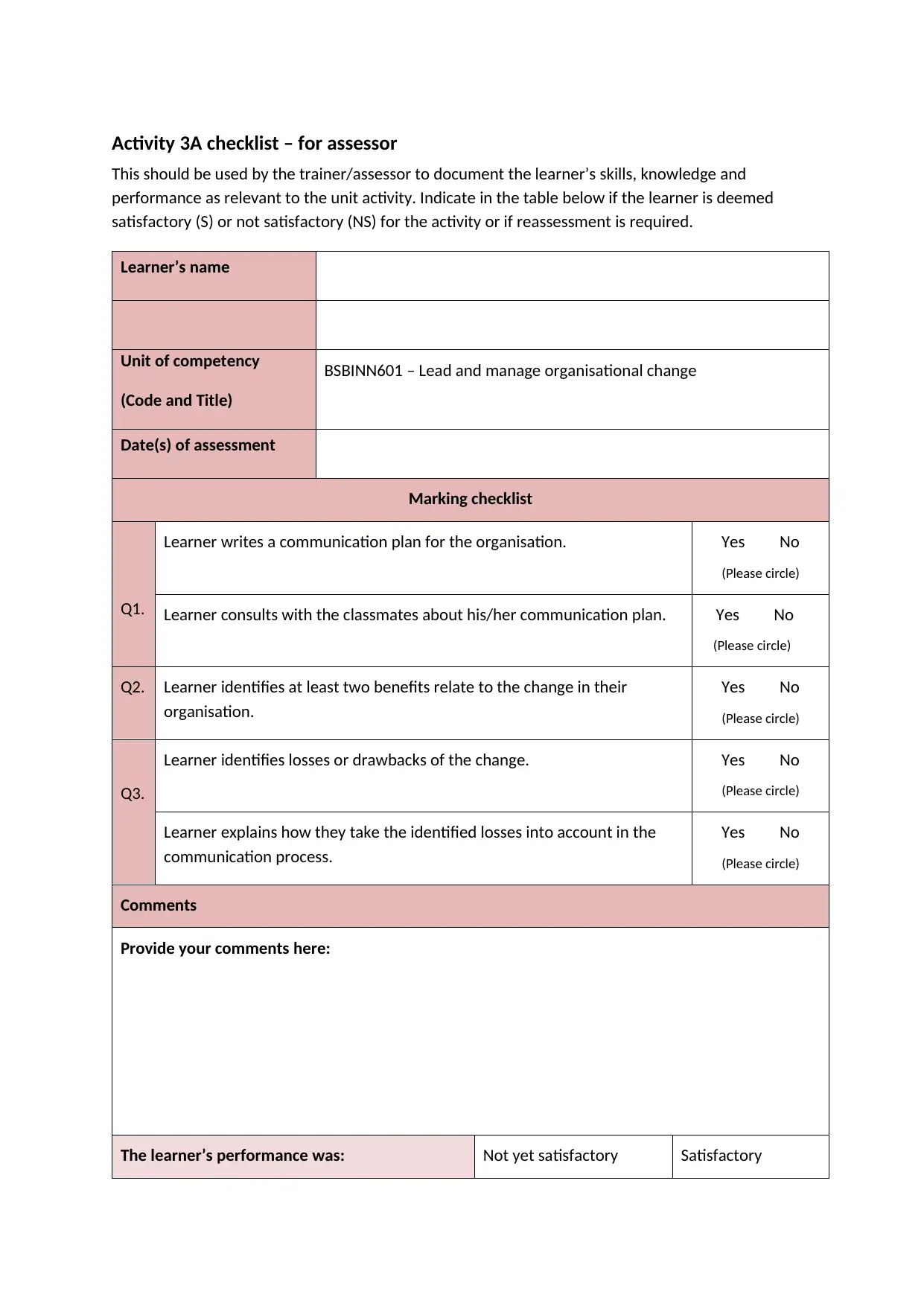
Activity 3A checklist – for assessor
This should be used by the trainer/assessor to document the learner’s skills, knowledge and
performance as relevant to the unit activity. Indicate in the table below if the learner is deemed
satisfactory (S) or not satisfactory (NS) for the activity or if reassessment is required.
Learner’s name
Unit of competency
(Code and Title)
BSBINN601 – Lead and manage organisational change
Date(s) of assessment
Marking checklist
Q1.
Learner writes a communication plan for the organisation. Yes No
(Please circle)
Learner consults with the classmates about his/her communication plan. Yes No
(Please circle)
Q2. Learner identifies at least two benefits relate to the change in their
organisation.
Yes No
(Please circle)
Q3.
Learner identifies losses or drawbacks of the change. Yes No
(Please circle)
Learner explains how they take the identified losses into account in the
communication process.
Yes No
(Please circle)
Comments
Provide your comments here:
The learner’s performance was: Not yet satisfactory Satisfactory
This should be used by the trainer/assessor to document the learner’s skills, knowledge and
performance as relevant to the unit activity. Indicate in the table below if the learner is deemed
satisfactory (S) or not satisfactory (NS) for the activity or if reassessment is required.
Learner’s name
Unit of competency
(Code and Title)
BSBINN601 – Lead and manage organisational change
Date(s) of assessment
Marking checklist
Q1.
Learner writes a communication plan for the organisation. Yes No
(Please circle)
Learner consults with the classmates about his/her communication plan. Yes No
(Please circle)
Q2. Learner identifies at least two benefits relate to the change in their
organisation.
Yes No
(Please circle)
Q3.
Learner identifies losses or drawbacks of the change. Yes No
(Please circle)
Learner explains how they take the identified losses into account in the
communication process.
Yes No
(Please circle)
Comments
Provide your comments here:
The learner’s performance was: Not yet satisfactory Satisfactory
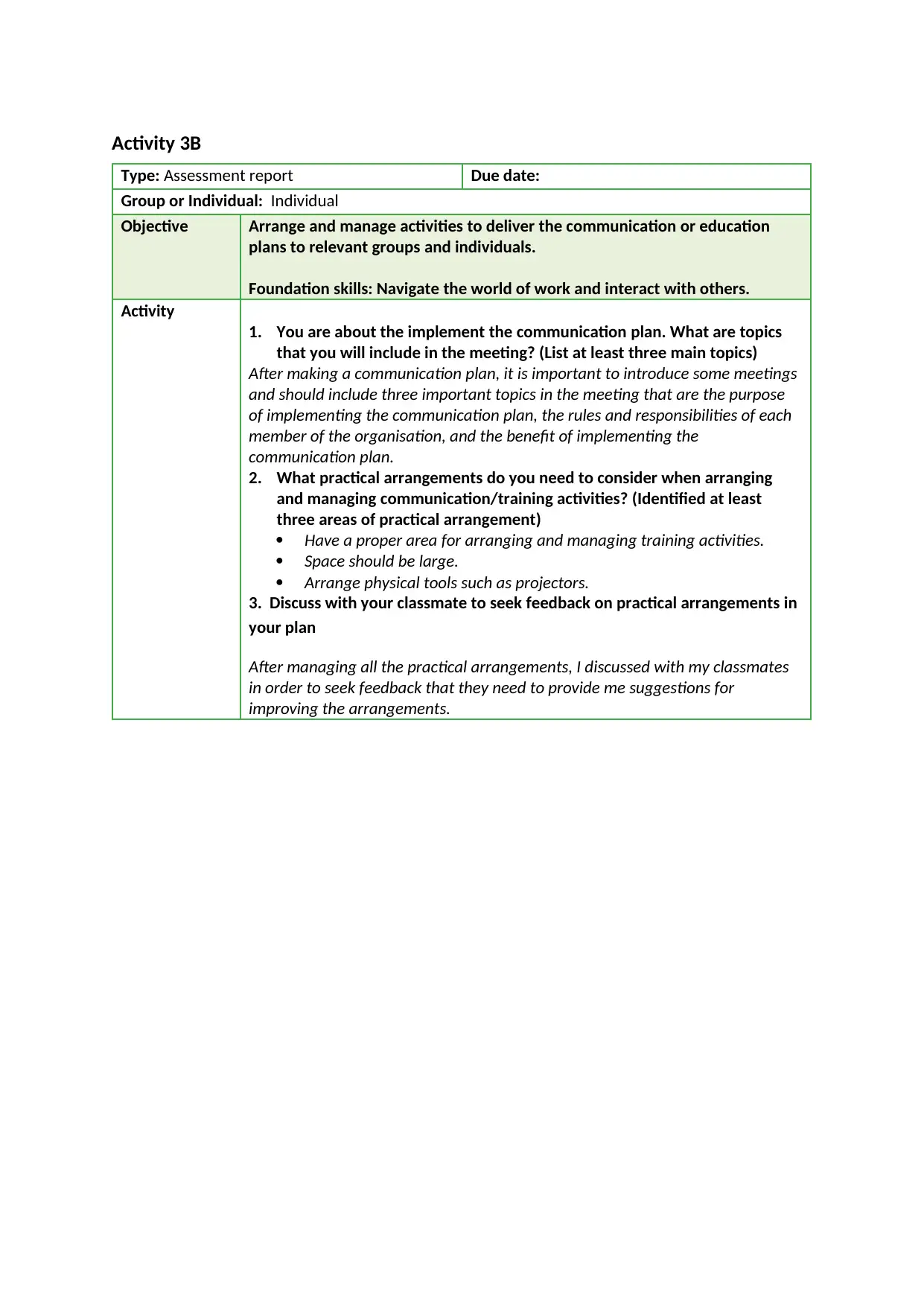
Activity 3B
Type: Assessment report Due date:
Group or Individual: Individual
Objective Arrange and manage activities to deliver the communication or education
plans to relevant groups and individuals.
Foundation skills: Navigate the world of work and interact with others.
Activity
1. You are about the implement the communication plan. What are topics
that you will include in the meeting? (List at least three main topics)
After making a communication plan, it is important to introduce some meetings
and should include three important topics in the meeting that are the purpose
of implementing the communication plan, the rules and responsibilities of each
member of the organisation, and the benefit of implementing the
communication plan.
2. What practical arrangements do you need to consider when arranging
and managing communication/training activities? (Identified at least
three areas of practical arrangement)
Have a proper area for arranging and managing training activities.
Space should be large.
Arrange physical tools such as projectors.
3. Discuss with your classmate to seek feedback on practical arrangements in
your plan
After managing all the practical arrangements, I discussed with my classmates
in order to seek feedback that they need to provide me suggestions for
improving the arrangements.
Type: Assessment report Due date:
Group or Individual: Individual
Objective Arrange and manage activities to deliver the communication or education
plans to relevant groups and individuals.
Foundation skills: Navigate the world of work and interact with others.
Activity
1. You are about the implement the communication plan. What are topics
that you will include in the meeting? (List at least three main topics)
After making a communication plan, it is important to introduce some meetings
and should include three important topics in the meeting that are the purpose
of implementing the communication plan, the rules and responsibilities of each
member of the organisation, and the benefit of implementing the
communication plan.
2. What practical arrangements do you need to consider when arranging
and managing communication/training activities? (Identified at least
three areas of practical arrangement)
Have a proper area for arranging and managing training activities.
Space should be large.
Arrange physical tools such as projectors.
3. Discuss with your classmate to seek feedback on practical arrangements in
your plan
After managing all the practical arrangements, I discussed with my classmates
in order to seek feedback that they need to provide me suggestions for
improving the arrangements.
Secure Best Marks with AI Grader
Need help grading? Try our AI Grader for instant feedback on your assignments.
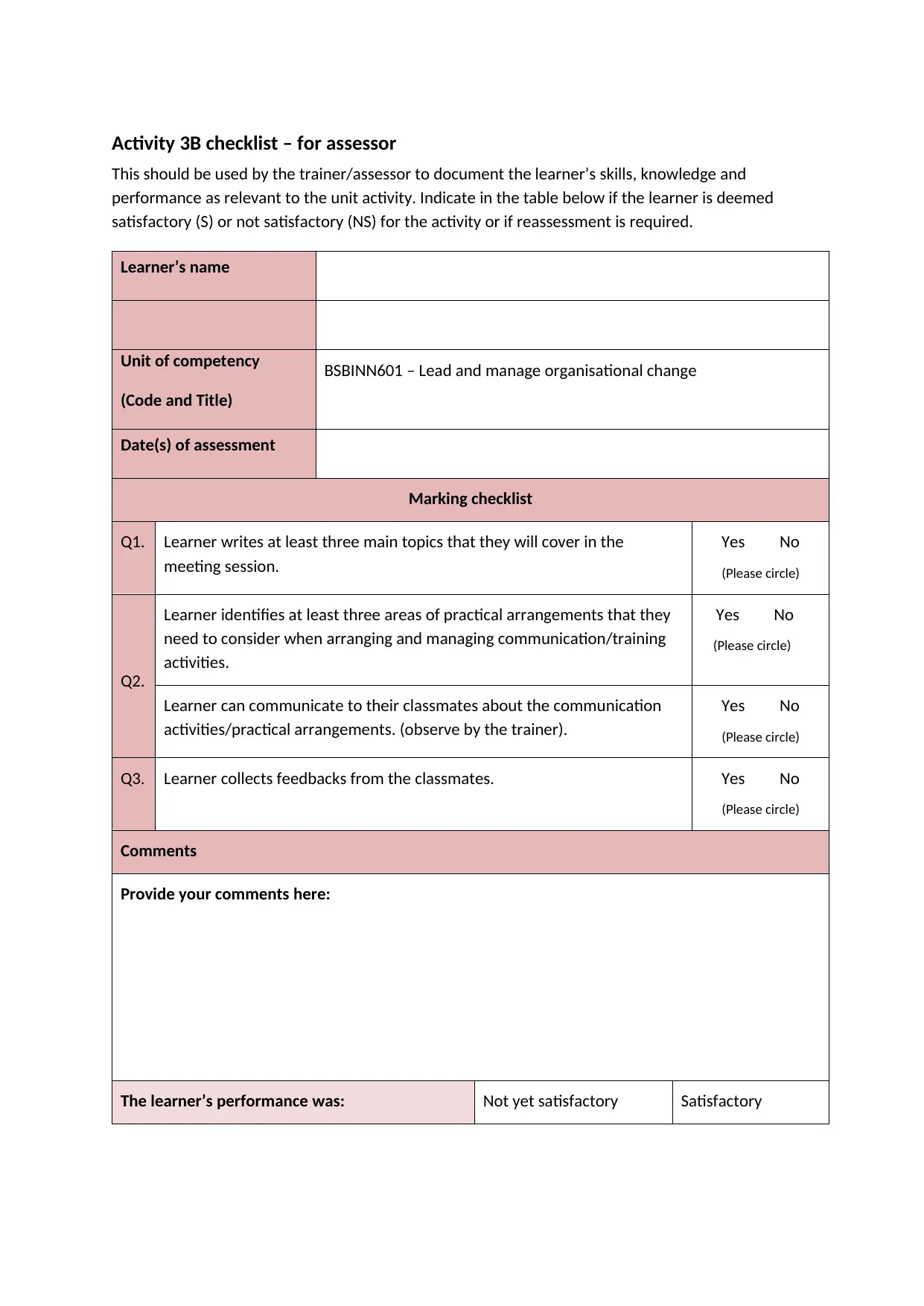
Activity 3B checklist – for assessor
This should be used by the trainer/assessor to document the learner’s skills, knowledge and
performance as relevant to the unit activity. Indicate in the table below if the learner is deemed
satisfactory (S) or not satisfactory (NS) for the activity or if reassessment is required.
Learner’s name
Unit of competency
(Code and Title)
BSBINN601 – Lead and manage organisational change
Date(s) of assessment
Marking checklist
Q1. Learner writes at least three main topics that they will cover in the
meeting session.
Yes No
(Please circle)
Q2.
Learner identifies at least three areas of practical arrangements that they
need to consider when arranging and managing communication/training
activities.
Yes No
(Please circle)
Learner can communicate to their classmates about the communication
activities/practical arrangements. (observe by the trainer).
Yes No
(Please circle)
Q3. Learner collects feedbacks from the classmates. Yes No
(Please circle)
Comments
Provide your comments here:
The learner’s performance was: Not yet satisfactory Satisfactory
This should be used by the trainer/assessor to document the learner’s skills, knowledge and
performance as relevant to the unit activity. Indicate in the table below if the learner is deemed
satisfactory (S) or not satisfactory (NS) for the activity or if reassessment is required.
Learner’s name
Unit of competency
(Code and Title)
BSBINN601 – Lead and manage organisational change
Date(s) of assessment
Marking checklist
Q1. Learner writes at least three main topics that they will cover in the
meeting session.
Yes No
(Please circle)
Q2.
Learner identifies at least three areas of practical arrangements that they
need to consider when arranging and managing communication/training
activities.
Yes No
(Please circle)
Learner can communicate to their classmates about the communication
activities/practical arrangements. (observe by the trainer).
Yes No
(Please circle)
Q3. Learner collects feedbacks from the classmates. Yes No
(Please circle)
Comments
Provide your comments here:
The learner’s performance was: Not yet satisfactory Satisfactory
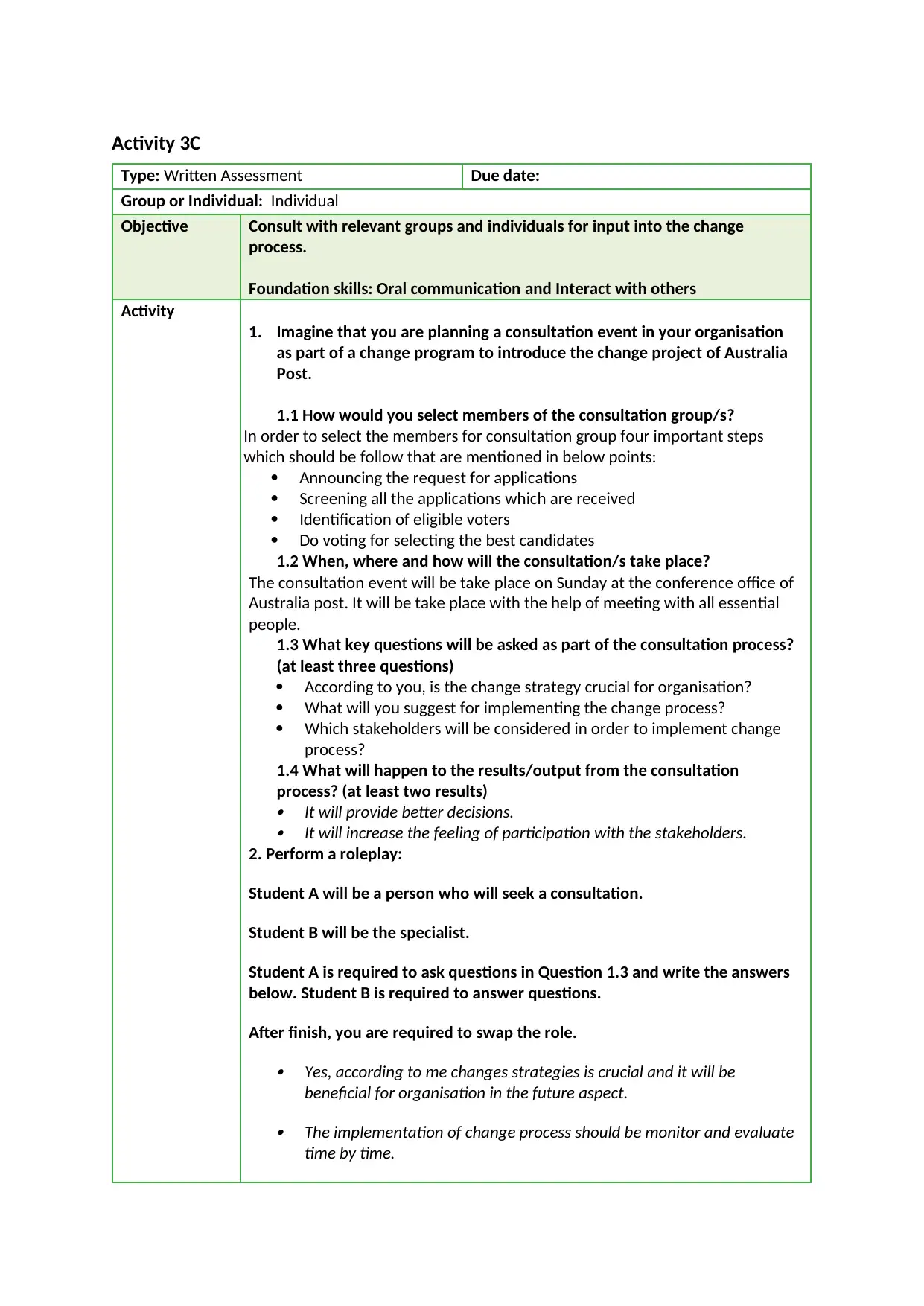
Activity 3C
Type: Written Assessment Due date:
Group or Individual: Individual
Objective Consult with relevant groups and individuals for input into the change
process.
Foundation skills: Oral communication and Interact with others
Activity
1. Imagine that you are planning a consultation event in your organisation
as part of a change program to introduce the change project of Australia
Post.
1.1 How would you select members of the consultation group/s?
In order to select the members for consultation group four important steps
which should be follow that are mentioned in below points:
Announcing the request for applications
Screening all the applications which are received
Identification of eligible voters
Do voting for selecting the best candidates
1.2 When, where and how will the consultation/s take place?
The consultation event will be take place on Sunday at the conference office of
Australia post. It will be take place with the help of meeting with all essential
people.
1.3 What key questions will be asked as part of the consultation process?
(at least three questions)
According to you, is the change strategy crucial for organisation?
What will you suggest for implementing the change process?
Which stakeholders will be considered in order to implement change
process?
1.4 What will happen to the results/output from the consultation
process? (at least two results)
It will provide better decisions.
It will increase the feeling of participation with the stakeholders.
2. Perform a roleplay:
Student A will be a person who will seek a consultation.
Student B will be the specialist.
Student A is required to ask questions in Question 1.3 and write the answers
below. Student B is required to answer questions.
After finish, you are required to swap the role.
Yes, according to me changes strategies is crucial and it will be
beneficial for organisation in the future aspect.
The implementation of change process should be monitor and evaluate
time by time.
Type: Written Assessment Due date:
Group or Individual: Individual
Objective Consult with relevant groups and individuals for input into the change
process.
Foundation skills: Oral communication and Interact with others
Activity
1. Imagine that you are planning a consultation event in your organisation
as part of a change program to introduce the change project of Australia
Post.
1.1 How would you select members of the consultation group/s?
In order to select the members for consultation group four important steps
which should be follow that are mentioned in below points:
Announcing the request for applications
Screening all the applications which are received
Identification of eligible voters
Do voting for selecting the best candidates
1.2 When, where and how will the consultation/s take place?
The consultation event will be take place on Sunday at the conference office of
Australia post. It will be take place with the help of meeting with all essential
people.
1.3 What key questions will be asked as part of the consultation process?
(at least three questions)
According to you, is the change strategy crucial for organisation?
What will you suggest for implementing the change process?
Which stakeholders will be considered in order to implement change
process?
1.4 What will happen to the results/output from the consultation
process? (at least two results)
It will provide better decisions.
It will increase the feeling of participation with the stakeholders.
2. Perform a roleplay:
Student A will be a person who will seek a consultation.
Student B will be the specialist.
Student A is required to ask questions in Question 1.3 and write the answers
below. Student B is required to answer questions.
After finish, you are required to swap the role.
Yes, according to me changes strategies is crucial and it will be
beneficial for organisation in the future aspect.
The implementation of change process should be monitor and evaluate
time by time.
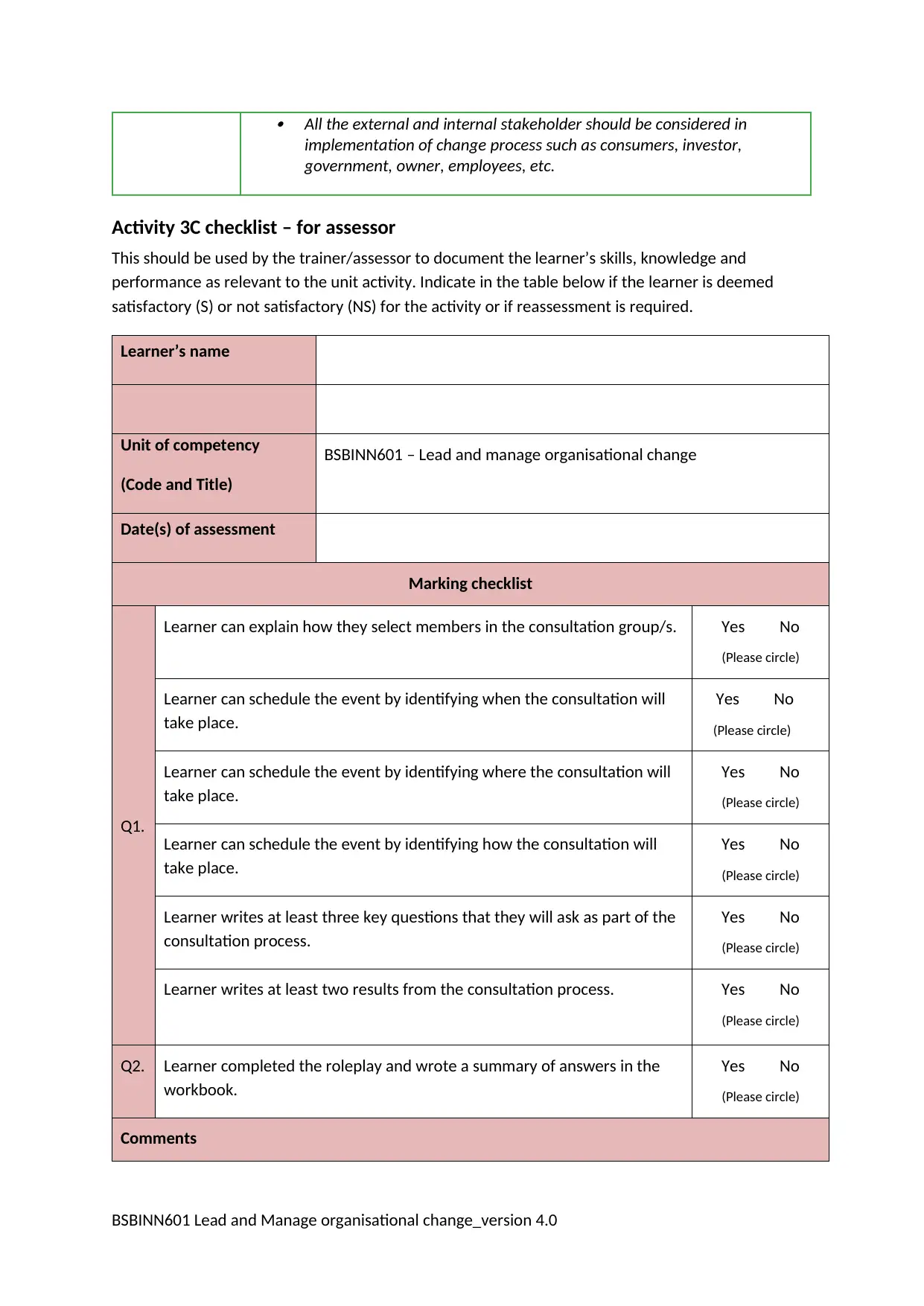
All the external and internal stakeholder should be considered in
implementation of change process such as consumers, investor,
government, owner, employees, etc.
Activity 3C checklist – for assessor
This should be used by the trainer/assessor to document the learner’s skills, knowledge and
performance as relevant to the unit activity. Indicate in the table below if the learner is deemed
satisfactory (S) or not satisfactory (NS) for the activity or if reassessment is required.
Learner’s name
Unit of competency
(Code and Title)
BSBINN601 – Lead and manage organisational change
Date(s) of assessment
Marking checklist
Q1.
Learner can explain how they select members in the consultation group/s. Yes No
(Please circle)
Learner can schedule the event by identifying when the consultation will
take place.
Yes No
(Please circle)
Learner can schedule the event by identifying where the consultation will
take place.
Yes No
(Please circle)
Learner can schedule the event by identifying how the consultation will
take place.
Yes No
(Please circle)
Learner writes at least three key questions that they will ask as part of the
consultation process.
Yes No
(Please circle)
Learner writes at least two results from the consultation process. Yes No
(Please circle)
Q2. Learner completed the roleplay and wrote a summary of answers in the
workbook.
Yes No
(Please circle)
Comments
BSBINN601 Lead and Manage organisational change_version 4.0
implementation of change process such as consumers, investor,
government, owner, employees, etc.
Activity 3C checklist – for assessor
This should be used by the trainer/assessor to document the learner’s skills, knowledge and
performance as relevant to the unit activity. Indicate in the table below if the learner is deemed
satisfactory (S) or not satisfactory (NS) for the activity or if reassessment is required.
Learner’s name
Unit of competency
(Code and Title)
BSBINN601 – Lead and manage organisational change
Date(s) of assessment
Marking checklist
Q1.
Learner can explain how they select members in the consultation group/s. Yes No
(Please circle)
Learner can schedule the event by identifying when the consultation will
take place.
Yes No
(Please circle)
Learner can schedule the event by identifying where the consultation will
take place.
Yes No
(Please circle)
Learner can schedule the event by identifying how the consultation will
take place.
Yes No
(Please circle)
Learner writes at least three key questions that they will ask as part of the
consultation process.
Yes No
(Please circle)
Learner writes at least two results from the consultation process. Yes No
(Please circle)
Q2. Learner completed the roleplay and wrote a summary of answers in the
workbook.
Yes No
(Please circle)
Comments
BSBINN601 Lead and Manage organisational change_version 4.0
Paraphrase This Document
Need a fresh take? Get an instant paraphrase of this document with our AI Paraphraser

Provide your comments here:
The learner’s performance was: Not yet satisfactory Satisfactory
BSBINN601 Lead and Manage organisational change_version 4.0
The learner’s performance was: Not yet satisfactory Satisfactory
BSBINN601 Lead and Manage organisational change_version 4.0

Activity 3D
Type: Written Assessment Due date:
Group or Individual: Individual
Objective Action interventions and activities set out in project plan according to project
timetable.
Foundation skill: Get the work done
Activity
1. Choose three of the following possible interventions and actions which
may occur on a project plan. Thinking of the context of Australia Post,
describe how you would ensure the correct/appropriate implementation
of these actions:
Action research
Career planning
Job redesign
Sensitivity training
Succession planning
Surveys (with feedback)
Team building
Termination or redeployment
Training
Transition analysis.
Career planning can be implement with the help of completing a self-
evaluation by each and every individual, conducting of career research,
performing market research, assessing options, etc.
Team building can be possible when peoples are feel motivated of
organisation and it should be implement by making a plan in an
effective way (Zamboni and et.al., 2020).
Training is found be very important and it should be implement with the
strategic plan so that each member will enjoy the benefits of training.
2. Please schedule your selected intervention and activities in the change
process timeline.
Example of template:
Stage of
changes
5 stages 5 stages 6 Stages
Date/Month 9/5 7/7 9/8
Activities Career
planning
Team
building
Training
Type: Written Assessment Due date:
Group or Individual: Individual
Objective Action interventions and activities set out in project plan according to project
timetable.
Foundation skill: Get the work done
Activity
1. Choose three of the following possible interventions and actions which
may occur on a project plan. Thinking of the context of Australia Post,
describe how you would ensure the correct/appropriate implementation
of these actions:
Action research
Career planning
Job redesign
Sensitivity training
Succession planning
Surveys (with feedback)
Team building
Termination or redeployment
Training
Transition analysis.
Career planning can be implement with the help of completing a self-
evaluation by each and every individual, conducting of career research,
performing market research, assessing options, etc.
Team building can be possible when peoples are feel motivated of
organisation and it should be implement by making a plan in an
effective way (Zamboni and et.al., 2020).
Training is found be very important and it should be implement with the
strategic plan so that each member will enjoy the benefits of training.
2. Please schedule your selected intervention and activities in the change
process timeline.
Example of template:
Stage of
changes
5 stages 5 stages 6 Stages
Date/Month 9/5 7/7 9/8
Activities Career
planning
Team
building
Training

Activity 3D checklist – for assessor
This should be used by the trainer/assessor to document the learner’s skills, knowledge and
performance as relevant to the unit activity. Indicate in the table below if the learner is deemed
satisfactory (S) or not satisfactory (NS) for the activity or if reassessment is required.
Learner’s name
Unit of competency
(Code and Title)
BSBINN601 – Lead and manage organisational change
Date(s) of assessment
Marking checklist
Q1.
Learner chooses three of the possible interventions provided in activity 3D. Yes No
(Please circle)
Learner explains how they ensure whether the implementation of each
action you selected is correct and appropriate.
Yes No
(Please circle)
Q2. Learner can schedule their selected intervention activities in the timeline
template provided.
Yes No
(Please circle)
Comments
Provide your comments here:
The learner’s performance was: Not yet satisfactory Satisfactory
This should be used by the trainer/assessor to document the learner’s skills, knowledge and
performance as relevant to the unit activity. Indicate in the table below if the learner is deemed
satisfactory (S) or not satisfactory (NS) for the activity or if reassessment is required.
Learner’s name
Unit of competency
(Code and Title)
BSBINN601 – Lead and manage organisational change
Date(s) of assessment
Marking checklist
Q1.
Learner chooses three of the possible interventions provided in activity 3D. Yes No
(Please circle)
Learner explains how they ensure whether the implementation of each
action you selected is correct and appropriate.
Yes No
(Please circle)
Q2. Learner can schedule their selected intervention activities in the timeline
template provided.
Yes No
(Please circle)
Comments
Provide your comments here:
The learner’s performance was: Not yet satisfactory Satisfactory
Secure Best Marks with AI Grader
Need help grading? Try our AI Grader for instant feedback on your assignments.
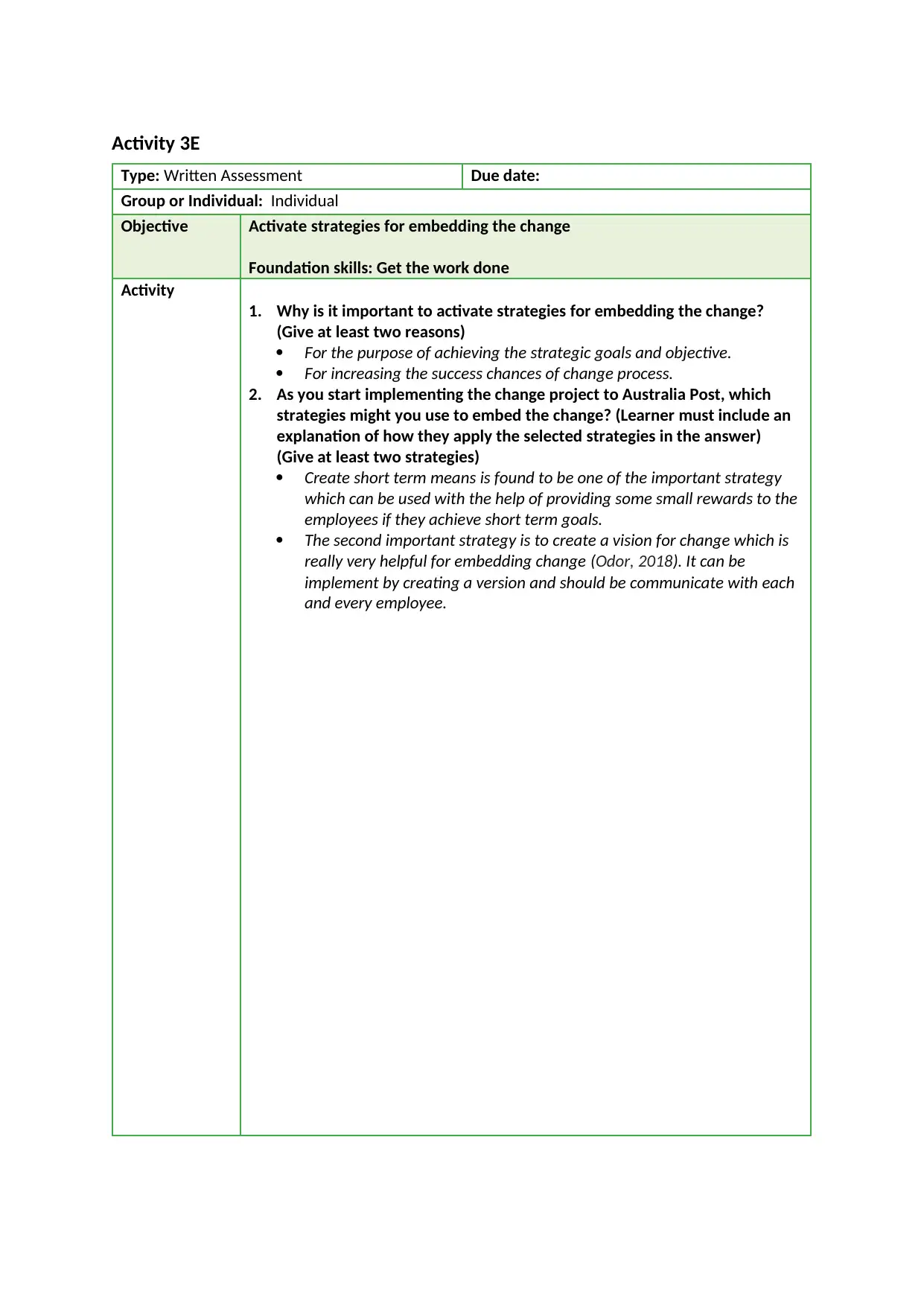
Activity 3E
Type: Written Assessment Due date:
Group or Individual: Individual
Objective Activate strategies for embedding the change
Foundation skills: Get the work done
Activity
1. Why is it important to activate strategies for embedding the change?
(Give at least two reasons)
For the purpose of achieving the strategic goals and objective.
For increasing the success chances of change process.
2. As you start implementing the change project to Australia Post, which
strategies might you use to embed the change? (Learner must include an
explanation of how they apply the selected strategies in the answer)
(Give at least two strategies)
Create short term means is found to be one of the important strategy
which can be used with the help of providing some small rewards to the
employees if they achieve short term goals.
The second important strategy is to create a vision for change which is
really very helpful for embedding change (Odor, 2018). It can be
implement by creating a version and should be communicate with each
and every employee.
Type: Written Assessment Due date:
Group or Individual: Individual
Objective Activate strategies for embedding the change
Foundation skills: Get the work done
Activity
1. Why is it important to activate strategies for embedding the change?
(Give at least two reasons)
For the purpose of achieving the strategic goals and objective.
For increasing the success chances of change process.
2. As you start implementing the change project to Australia Post, which
strategies might you use to embed the change? (Learner must include an
explanation of how they apply the selected strategies in the answer)
(Give at least two strategies)
Create short term means is found to be one of the important strategy
which can be used with the help of providing some small rewards to the
employees if they achieve short term goals.
The second important strategy is to create a vision for change which is
really very helpful for embedding change (Odor, 2018). It can be
implement by creating a version and should be communicate with each
and every employee.

Activity 3E checklist – for assessor
This should be used by the trainer/assessor to document the learner’s skills, knowledge and
performance as relevant to the unit activity. Indicate in the table below if the learner is deemed
satisfactory (S) or not satisfactory (NS) for the activity or if reassessment is required.
Learner’s name
Unit of competency
(Code and Title)
BSBINN601 – Lead and manage organisational change
Date(s) of assessment
Marking checklist
Q1. Learner identifies at least one of the reasons why activating strategies for
embedding the change are important.
Yes No
(Please circle)
Q2.
Learner identifies at least two strategies that they will use to embed the
change.
Yes No
(Please circle)
Learner explains how they apply the selected strategies to their change
program.
Yes No
(Please circle)
Comments
Provide your comments here:
The learner’s performance was: Not yet satisfactory Satisfactory
This should be used by the trainer/assessor to document the learner’s skills, knowledge and
performance as relevant to the unit activity. Indicate in the table below if the learner is deemed
satisfactory (S) or not satisfactory (NS) for the activity or if reassessment is required.
Learner’s name
Unit of competency
(Code and Title)
BSBINN601 – Lead and manage organisational change
Date(s) of assessment
Marking checklist
Q1. Learner identifies at least one of the reasons why activating strategies for
embedding the change are important.
Yes No
(Please circle)
Q2.
Learner identifies at least two strategies that they will use to embed the
change.
Yes No
(Please circle)
Learner explains how they apply the selected strategies to their change
program.
Yes No
(Please circle)
Comments
Provide your comments here:
The learner’s performance was: Not yet satisfactory Satisfactory

Activity 3F
Type: Written Assessment Due date:
Group or Individual: Individual
Objective Conduct regular evaluation and review and modify project plan where
appropriate to achieve change program objectives.
Foundation skill: Get the work done
Activity
1. Why is it important to evaluate and review progress during a change
management programme?
It is necessary for an organisation to evaluate and review progress during
a change management program as it helps in providing information and
framework to the employees that support strategic planning efforts.
It will confirm the chances of success of change management process.
2. What methods can be used to evaluate and review the progress of the
project? (Give at least two methods)
Two important methods of evaluation are:
Goal based methods
Process based method
3. You are required to write an evaluation plan for the project. In the plan, you
must include the topics as follows:
- Evaluation method
- How often is the evaluation or performance review
- What do you want to observe/ evaluate?
- How would you know if you need to modify the project plan?
- Give an example of the modification.
The first and foremost step is to identify the outcome and impact of the
project.
The second step is to find out and choose the evaluation method which can
be surveys, questionnaire, focus group, etc.
The evaluation or performance review should be performed on a weekly
basis.
I want to observe and evaluate all the regular activities in the change
program so that we will able to achieve objective.
With the help of regular feedback, organisation is able to identify the need
to modify the project plan (Peng and et.al., 2021). For example, with the
help of feedback, we analysed that company needs some changes in
communication plan.
Type: Written Assessment Due date:
Group or Individual: Individual
Objective Conduct regular evaluation and review and modify project plan where
appropriate to achieve change program objectives.
Foundation skill: Get the work done
Activity
1. Why is it important to evaluate and review progress during a change
management programme?
It is necessary for an organisation to evaluate and review progress during
a change management program as it helps in providing information and
framework to the employees that support strategic planning efforts.
It will confirm the chances of success of change management process.
2. What methods can be used to evaluate and review the progress of the
project? (Give at least two methods)
Two important methods of evaluation are:
Goal based methods
Process based method
3. You are required to write an evaluation plan for the project. In the plan, you
must include the topics as follows:
- Evaluation method
- How often is the evaluation or performance review
- What do you want to observe/ evaluate?
- How would you know if you need to modify the project plan?
- Give an example of the modification.
The first and foremost step is to identify the outcome and impact of the
project.
The second step is to find out and choose the evaluation method which can
be surveys, questionnaire, focus group, etc.
The evaluation or performance review should be performed on a weekly
basis.
I want to observe and evaluate all the regular activities in the change
program so that we will able to achieve objective.
With the help of regular feedback, organisation is able to identify the need
to modify the project plan (Peng and et.al., 2021). For example, with the
help of feedback, we analysed that company needs some changes in
communication plan.
Paraphrase This Document
Need a fresh take? Get an instant paraphrase of this document with our AI Paraphraser

Activity 3F checklist – for assessor
This should be used by the trainer/assessor to document the learner’s skills, knowledge and
performance as relevant to the unit activity. Indicate in the table below if the learner is deemed
satisfactory (S) or not satisfactory (NS) for the activity or if reassessment is required.
Learner’s name
Unit of competency
(Code and Title)
BSBINN601 – Lead and manage organisational change
Date(s) of assessment
Marking checklist
Q1. Learner can explain the reason why it is important to evaluate and review
progress during a change management programme. Yes No
(Please circle)
Q2. Learner can identify at least two correct methods that can be used to
evaluate and review progress of a change programme. Yes No
(Please circle)
Q3.
Learner mentions about how often they will do an evaluation. Yes No
(Please circle)
Learner can identify correct methods that they would use to review
progress of the change project toward achieving their objectives.
Yes No
(Please circle)
Learner can identify what to observe or evaluate correctly. Yes No
(Please circle)
Learner can explain when they will need to modify the plan. Yes No
(Please circle)
Comments
Provide your comments here:
The learner’s performance was: Not yet satisfactory Satisfactory
This should be used by the trainer/assessor to document the learner’s skills, knowledge and
performance as relevant to the unit activity. Indicate in the table below if the learner is deemed
satisfactory (S) or not satisfactory (NS) for the activity or if reassessment is required.
Learner’s name
Unit of competency
(Code and Title)
BSBINN601 – Lead and manage organisational change
Date(s) of assessment
Marking checklist
Q1. Learner can explain the reason why it is important to evaluate and review
progress during a change management programme. Yes No
(Please circle)
Q2. Learner can identify at least two correct methods that can be used to
evaluate and review progress of a change programme. Yes No
(Please circle)
Q3.
Learner mentions about how often they will do an evaluation. Yes No
(Please circle)
Learner can identify correct methods that they would use to review
progress of the change project toward achieving their objectives.
Yes No
(Please circle)
Learner can identify what to observe or evaluate correctly. Yes No
(Please circle)
Learner can explain when they will need to modify the plan. Yes No
(Please circle)
Comments
Provide your comments here:
The learner’s performance was: Not yet satisfactory Satisfactory
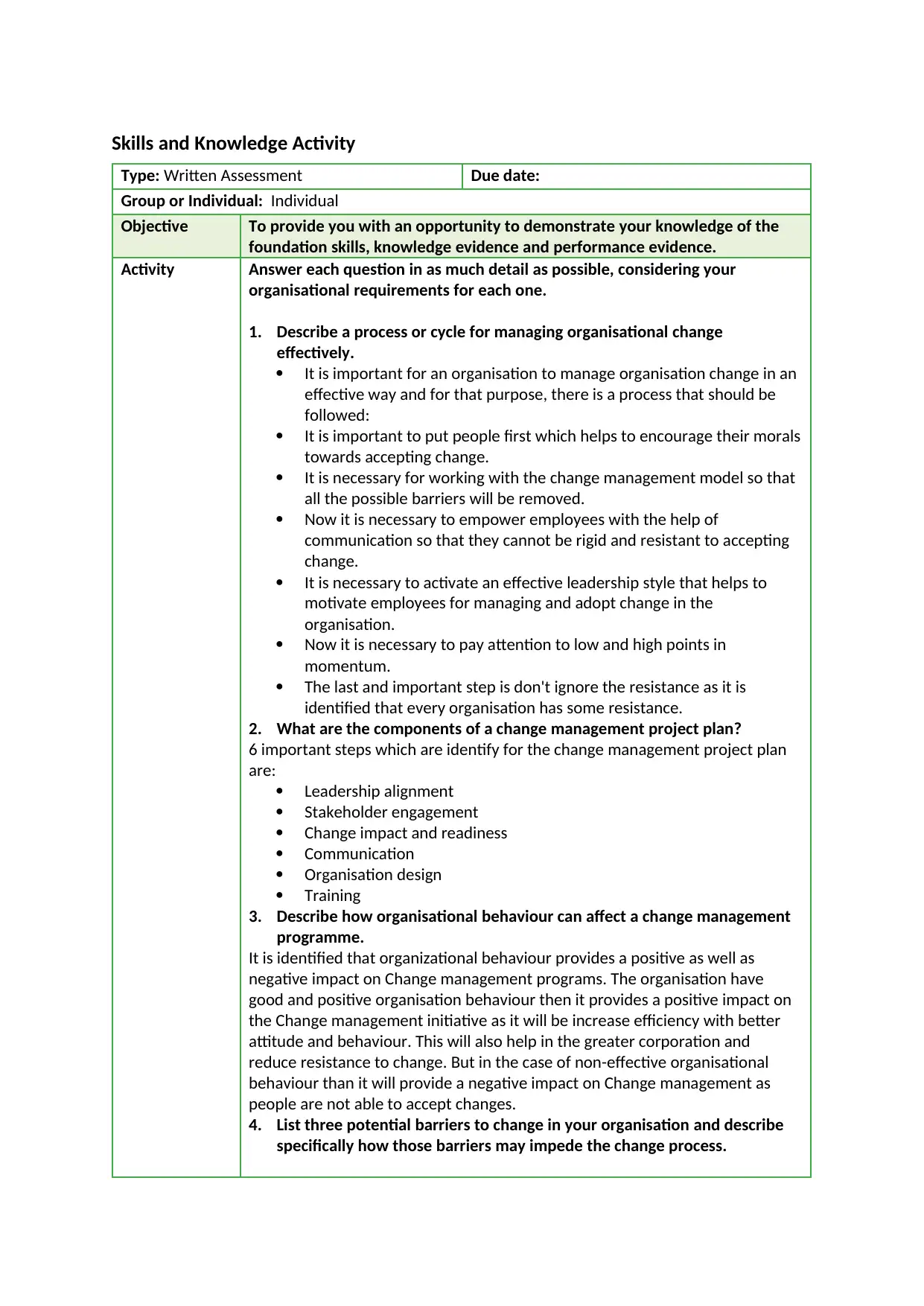
Skills and Knowledge Activity
Type: Written Assessment Due date:
Group or Individual: Individual
Objective To provide you with an opportunity to demonstrate your knowledge of the
foundation skills, knowledge evidence and performance evidence.
Activity Answer each question in as much detail as possible, considering your
organisational requirements for each one.
1. Describe a process or cycle for managing organisational change
effectively.
It is important for an organisation to manage organisation change in an
effective way and for that purpose, there is a process that should be
followed:
It is important to put people first which helps to encourage their morals
towards accepting change.
It is necessary for working with the change management model so that
all the possible barriers will be removed.
Now it is necessary to empower employees with the help of
communication so that they cannot be rigid and resistant to accepting
change.
It is necessary to activate an effective leadership style that helps to
motivate employees for managing and adopt change in the
organisation.
Now it is necessary to pay attention to low and high points in
momentum.
The last and important step is don't ignore the resistance as it is
identified that every organisation has some resistance.
2. What are the components of a change management project plan?
6 important steps which are identify for the change management project plan
are:
Leadership alignment
Stakeholder engagement
Change impact and readiness
Communication
Organisation design
Training
3. Describe how organisational behaviour can affect a change management
programme.
It is identified that organizational behaviour provides a positive as well as
negative impact on Change management programs. The organisation have
good and positive organisation behaviour then it provides a positive impact on
the Change management initiative as it will be increase efficiency with better
attitude and behaviour. This will also help in the greater corporation and
reduce resistance to change. But in the case of non-effective organisational
behaviour than it will provide a negative impact on Change management as
people are not able to accept changes.
4. List three potential barriers to change in your organisation and describe
specifically how those barriers may impede the change process.
Type: Written Assessment Due date:
Group or Individual: Individual
Objective To provide you with an opportunity to demonstrate your knowledge of the
foundation skills, knowledge evidence and performance evidence.
Activity Answer each question in as much detail as possible, considering your
organisational requirements for each one.
1. Describe a process or cycle for managing organisational change
effectively.
It is important for an organisation to manage organisation change in an
effective way and for that purpose, there is a process that should be
followed:
It is important to put people first which helps to encourage their morals
towards accepting change.
It is necessary for working with the change management model so that
all the possible barriers will be removed.
Now it is necessary to empower employees with the help of
communication so that they cannot be rigid and resistant to accepting
change.
It is necessary to activate an effective leadership style that helps to
motivate employees for managing and adopt change in the
organisation.
Now it is necessary to pay attention to low and high points in
momentum.
The last and important step is don't ignore the resistance as it is
identified that every organisation has some resistance.
2. What are the components of a change management project plan?
6 important steps which are identify for the change management project plan
are:
Leadership alignment
Stakeholder engagement
Change impact and readiness
Communication
Organisation design
Training
3. Describe how organisational behaviour can affect a change management
programme.
It is identified that organizational behaviour provides a positive as well as
negative impact on Change management programs. The organisation have
good and positive organisation behaviour then it provides a positive impact on
the Change management initiative as it will be increase efficiency with better
attitude and behaviour. This will also help in the greater corporation and
reduce resistance to change. But in the case of non-effective organisational
behaviour than it will provide a negative impact on Change management as
people are not able to accept changes.
4. List three potential barriers to change in your organisation and describe
specifically how those barriers may impede the change process.

Three important potential barriers are identified in the organisation for change
such as in effective communication, inadequate resources, lack of clarity, etc.
These barriers will impede the change process as organisation will be unable to
achieve the goal of change.
BSBINN601 Lead and Manage organisational change_version 4.0
such as in effective communication, inadequate resources, lack of clarity, etc.
These barriers will impede the change process as organisation will be unable to
achieve the goal of change.
BSBINN601 Lead and Manage organisational change_version 4.0
Secure Best Marks with AI Grader
Need help grading? Try our AI Grader for instant feedback on your assignments.
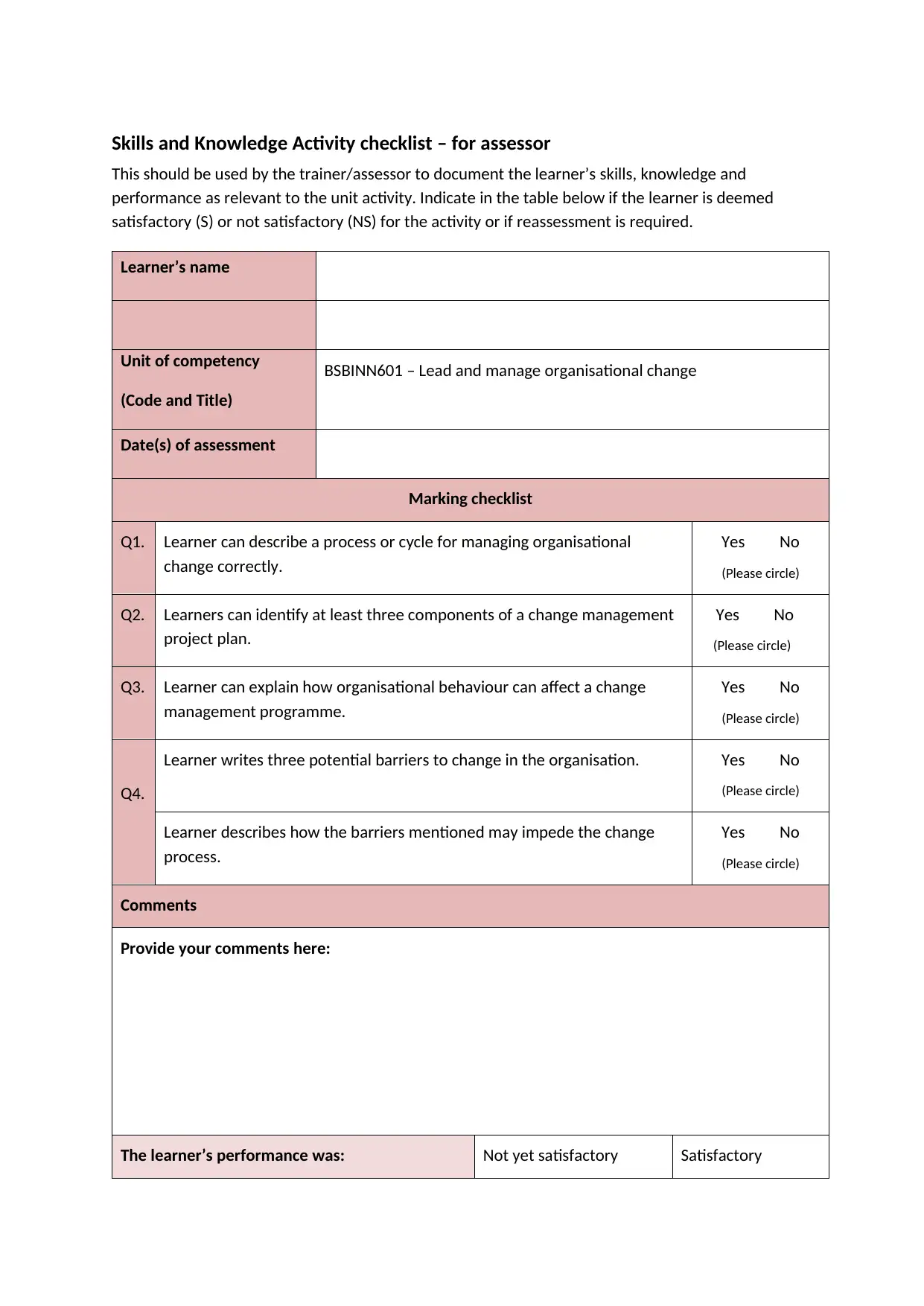
Skills and Knowledge Activity checklist – for assessor
This should be used by the trainer/assessor to document the learner’s skills, knowledge and
performance as relevant to the unit activity. Indicate in the table below if the learner is deemed
satisfactory (S) or not satisfactory (NS) for the activity or if reassessment is required.
Learner’s name
Unit of competency
(Code and Title)
BSBINN601 – Lead and manage organisational change
Date(s) of assessment
Marking checklist
Q1. Learner can describe a process or cycle for managing organisational
change correctly.
Yes No
(Please circle)
Q2. Learners can identify at least three components of a change management
project plan.
Yes No
(Please circle)
Q3. Learner can explain how organisational behaviour can affect a change
management programme.
Yes No
(Please circle)
Q4.
Learner writes three potential barriers to change in the organisation. Yes No
(Please circle)
Learner describes how the barriers mentioned may impede the change
process.
Yes No
(Please circle)
Comments
Provide your comments here:
The learner’s performance was: Not yet satisfactory Satisfactory
This should be used by the trainer/assessor to document the learner’s skills, knowledge and
performance as relevant to the unit activity. Indicate in the table below if the learner is deemed
satisfactory (S) or not satisfactory (NS) for the activity or if reassessment is required.
Learner’s name
Unit of competency
(Code and Title)
BSBINN601 – Lead and manage organisational change
Date(s) of assessment
Marking checklist
Q1. Learner can describe a process or cycle for managing organisational
change correctly.
Yes No
(Please circle)
Q2. Learners can identify at least three components of a change management
project plan.
Yes No
(Please circle)
Q3. Learner can explain how organisational behaviour can affect a change
management programme.
Yes No
(Please circle)
Q4.
Learner writes three potential barriers to change in the organisation. Yes No
(Please circle)
Learner describes how the barriers mentioned may impede the change
process.
Yes No
(Please circle)
Comments
Provide your comments here:
The learner’s performance was: Not yet satisfactory Satisfactory
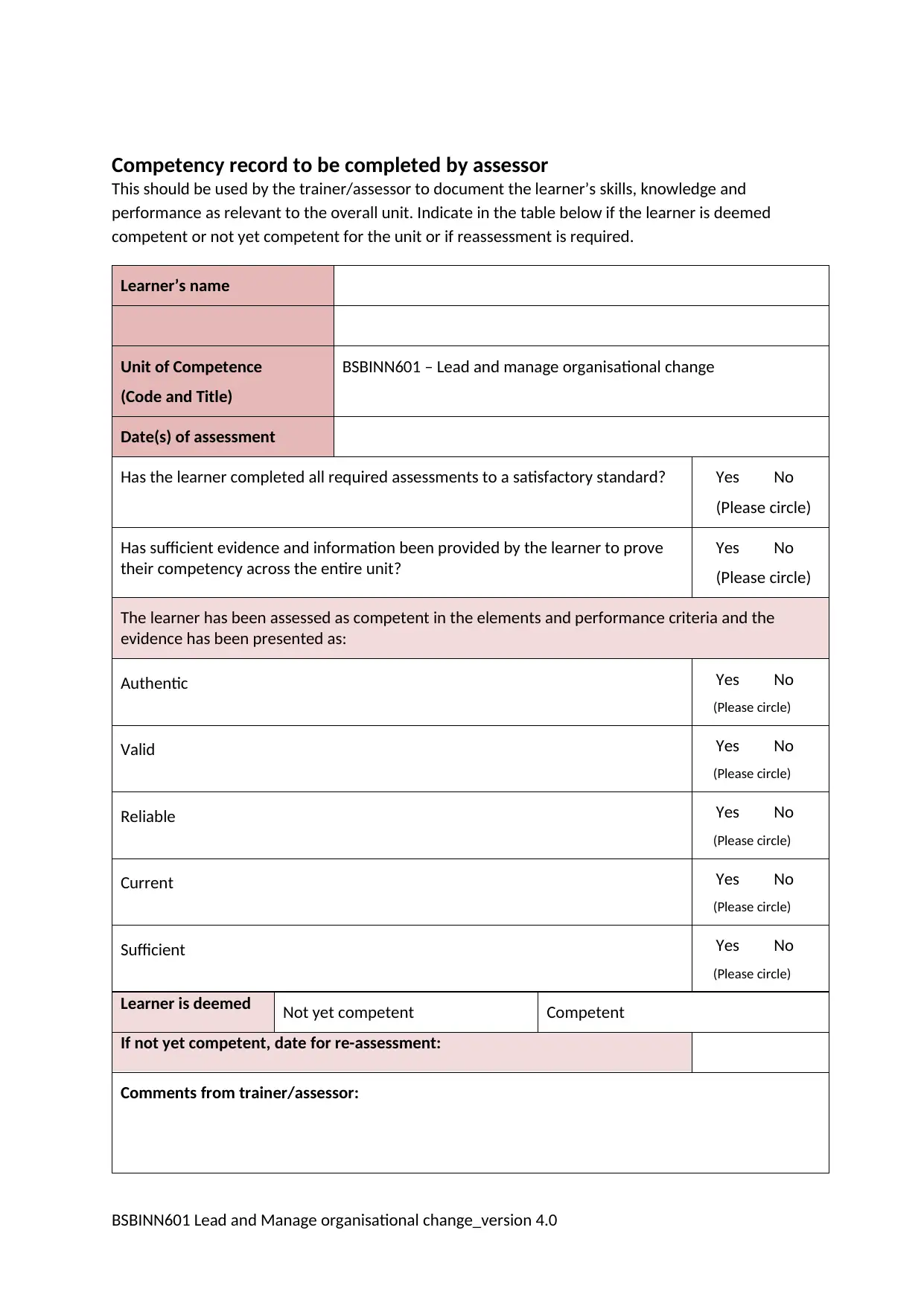
Competency record to be completed by assessor
This should be used by the trainer/assessor to document the learner’s skills, knowledge and
performance as relevant to the overall unit. Indicate in the table below if the learner is deemed
competent or not yet competent for the unit or if reassessment is required.
Learner’s name
Unit of Competence
(Code and Title)
BSBINN601 – Lead and manage organisational change
Date(s) of assessment
Has the learner completed all required assessments to a satisfactory standard? Yes No
(Please circle)
Has sufficient evidence and information been provided by the learner to prove
their competency across the entire unit?
Yes No
(Please circle)
The learner has been assessed as competent in the elements and performance criteria and the
evidence has been presented as:
Authentic Yes No
(Please circle)
Valid Yes No
(Please circle)
Reliable Yes No
(Please circle)
Current Yes No
(Please circle)
Sufficient Yes No
(Please circle)
Learner is deemed Not yet competent Competent
If not yet competent, date for re-assessment:
Comments from trainer/assessor:
BSBINN601 Lead and Manage organisational change_version 4.0
This should be used by the trainer/assessor to document the learner’s skills, knowledge and
performance as relevant to the overall unit. Indicate in the table below if the learner is deemed
competent or not yet competent for the unit or if reassessment is required.
Learner’s name
Unit of Competence
(Code and Title)
BSBINN601 – Lead and manage organisational change
Date(s) of assessment
Has the learner completed all required assessments to a satisfactory standard? Yes No
(Please circle)
Has sufficient evidence and information been provided by the learner to prove
their competency across the entire unit?
Yes No
(Please circle)
The learner has been assessed as competent in the elements and performance criteria and the
evidence has been presented as:
Authentic Yes No
(Please circle)
Valid Yes No
(Please circle)
Reliable Yes No
(Please circle)
Current Yes No
(Please circle)
Sufficient Yes No
(Please circle)
Learner is deemed Not yet competent Competent
If not yet competent, date for re-assessment:
Comments from trainer/assessor:
BSBINN601 Lead and Manage organisational change_version 4.0
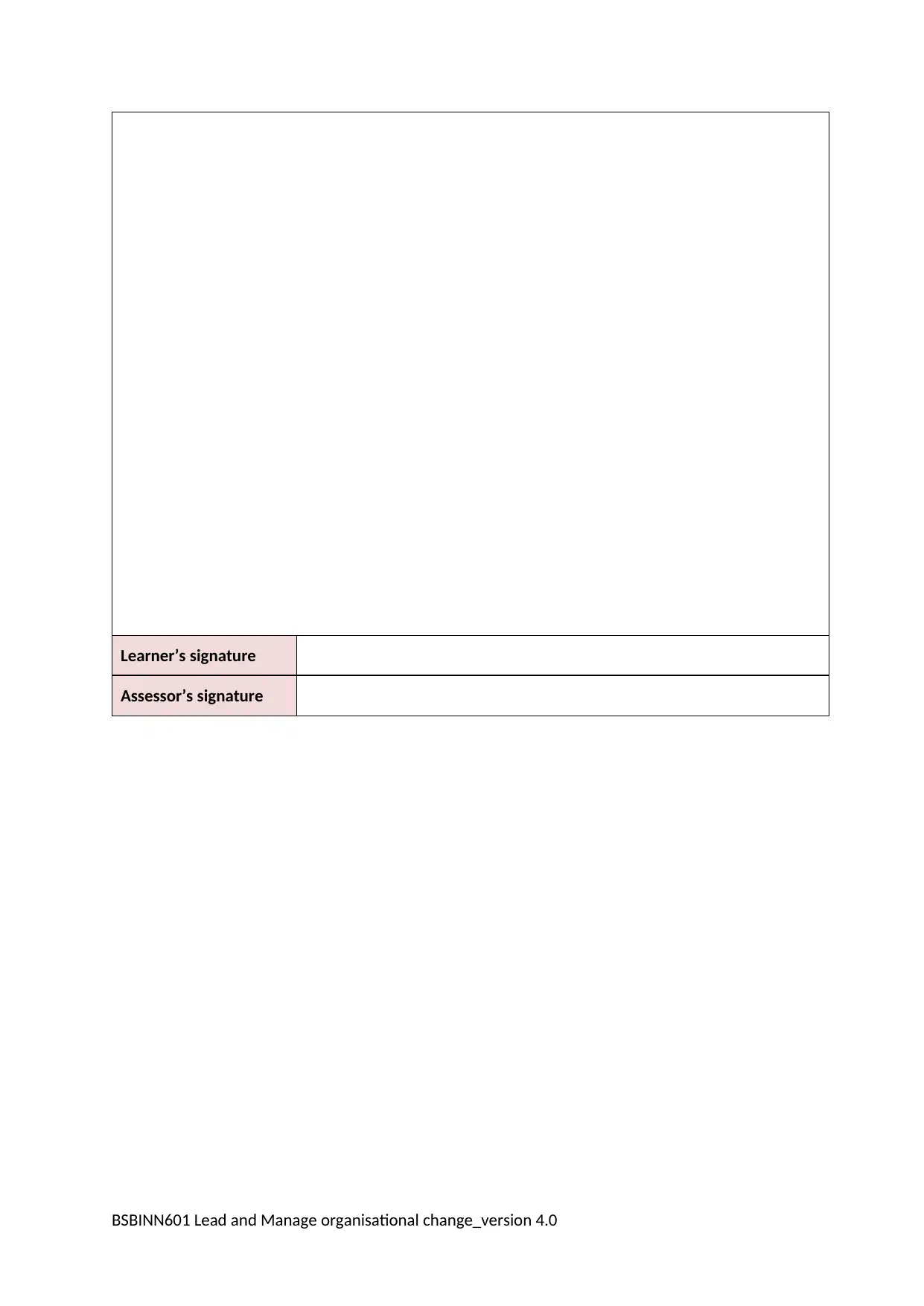
Learner’s signature
Assessor’s signature
BSBINN601 Lead and Manage organisational change_version 4.0
Assessor’s signature
BSBINN601 Lead and Manage organisational change_version 4.0
Paraphrase This Document
Need a fresh take? Get an instant paraphrase of this document with our AI Paraphraser
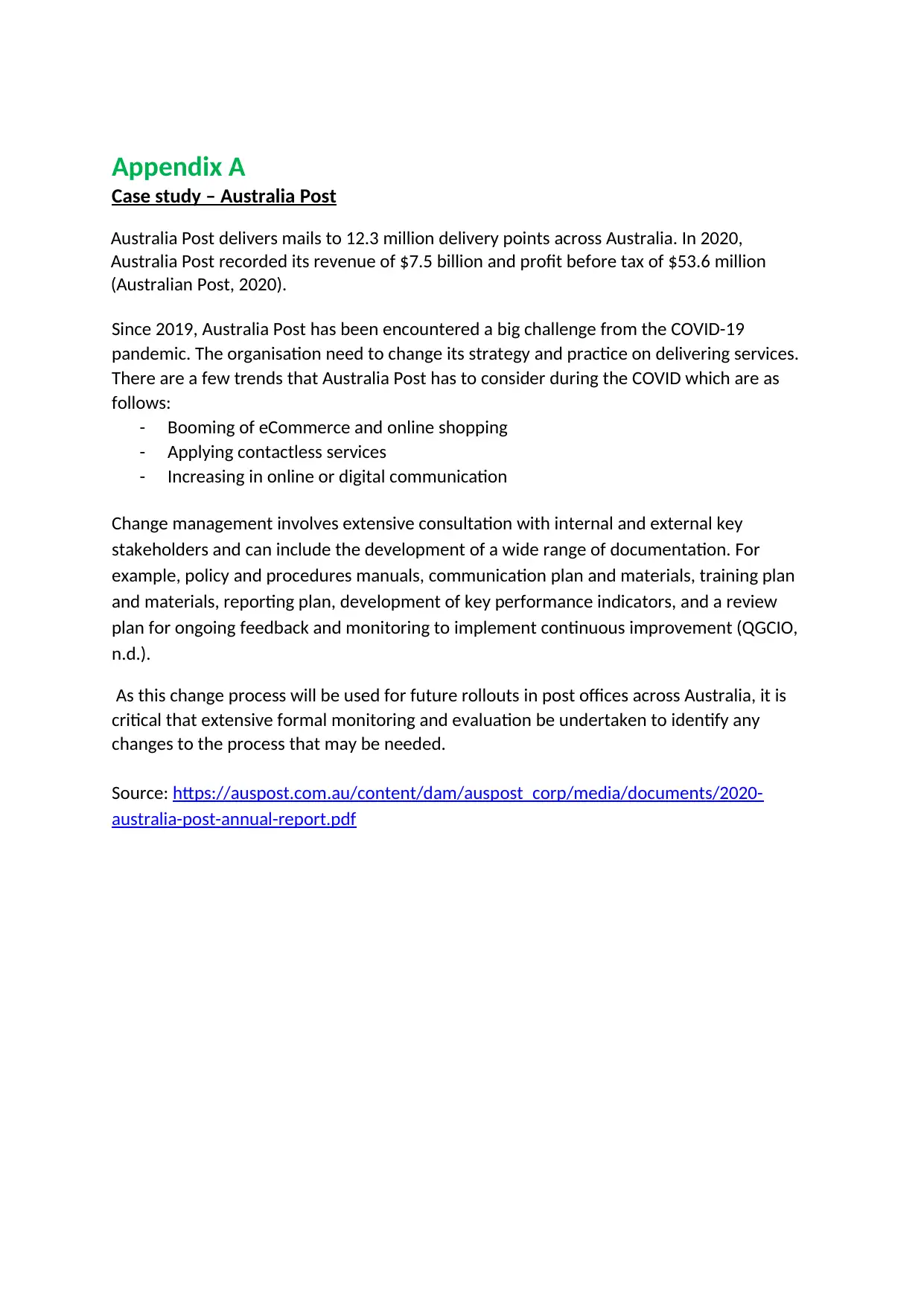
Appendix A
Case study – Australia Post
Australia Post delivers mails to 12.3 million delivery points across Australia. In 2020,
Australia Post recorded its revenue of $7.5 billion and profit before tax of $53.6 million
(Australian Post, 2020).
Since 2019, Australia Post has been encountered a big challenge from the COVID-19
pandemic. The organisation need to change its strategy and practice on delivering services.
There are a few trends that Australia Post has to consider during the COVID which are as
follows:
- Booming of eCommerce and online shopping
- Applying contactless services
- Increasing in online or digital communication
Change management involves extensive consultation with internal and external key
stakeholders and can include the development of a wide range of documentation. For
example, policy and procedures manuals, communication plan and materials, training plan
and materials, reporting plan, development of key performance indicators, and a review
plan for ongoing feedback and monitoring to implement continuous improvement (QGCIO,
n.d.).
As this change process will be used for future rollouts in post offices across Australia, it is
critical that extensive formal monitoring and evaluation be undertaken to identify any
changes to the process that may be needed.
Source: https://auspost.com.au/content/dam/auspost_corp/media/documents/2020-
australia-post-annual-report.pdf
Case study – Australia Post
Australia Post delivers mails to 12.3 million delivery points across Australia. In 2020,
Australia Post recorded its revenue of $7.5 billion and profit before tax of $53.6 million
(Australian Post, 2020).
Since 2019, Australia Post has been encountered a big challenge from the COVID-19
pandemic. The organisation need to change its strategy and practice on delivering services.
There are a few trends that Australia Post has to consider during the COVID which are as
follows:
- Booming of eCommerce and online shopping
- Applying contactless services
- Increasing in online or digital communication
Change management involves extensive consultation with internal and external key
stakeholders and can include the development of a wide range of documentation. For
example, policy and procedures manuals, communication plan and materials, training plan
and materials, reporting plan, development of key performance indicators, and a review
plan for ongoing feedback and monitoring to implement continuous improvement (QGCIO,
n.d.).
As this change process will be used for future rollouts in post offices across Australia, it is
critical that extensive formal monitoring and evaluation be undertaken to identify any
changes to the process that may be needed.
Source: https://auspost.com.au/content/dam/auspost_corp/media/documents/2020-
australia-post-annual-report.pdf
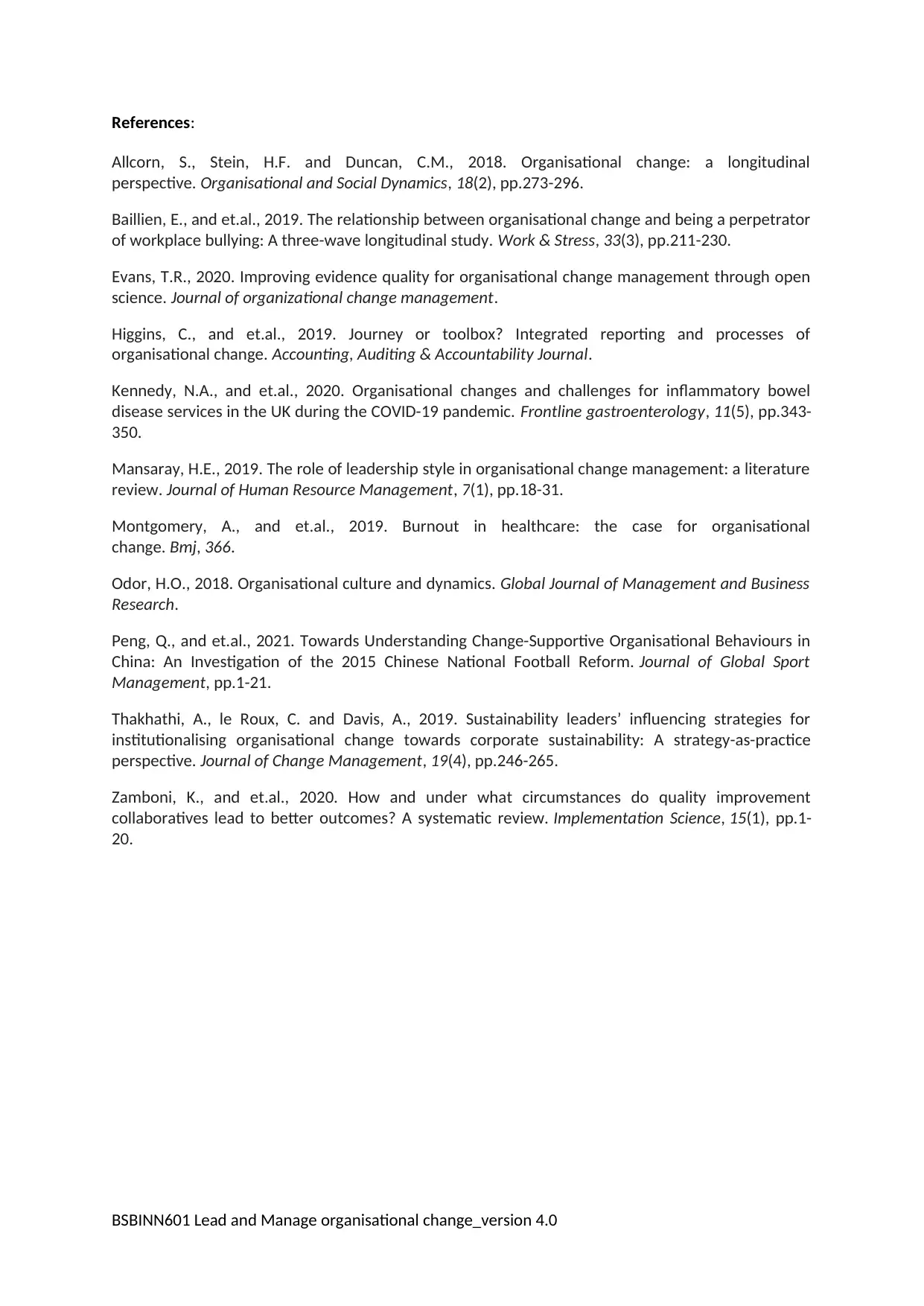
References:
Allcorn, S., Stein, H.F. and Duncan, C.M., 2018. Organisational change: a longitudinal
perspective. Organisational and Social Dynamics, 18(2), pp.273-296.
Baillien, E., and et.al., 2019. The relationship between organisational change and being a perpetrator
of workplace bullying: A three-wave longitudinal study. Work & Stress, 33(3), pp.211-230.
Evans, T.R., 2020. Improving evidence quality for organisational change management through open
science. Journal of organizational change management.
Higgins, C., and et.al., 2019. Journey or toolbox? Integrated reporting and processes of
organisational change. Accounting, Auditing & Accountability Journal.
Kennedy, N.A., and et.al., 2020. Organisational changes and challenges for inflammatory bowel
disease services in the UK during the COVID-19 pandemic. Frontline gastroenterology, 11(5), pp.343-
350.
Mansaray, H.E., 2019. The role of leadership style in organisational change management: a literature
review. Journal of Human Resource Management, 7(1), pp.18-31.
Montgomery, A., and et.al., 2019. Burnout in healthcare: the case for organisational
change. Bmj, 366.
Odor, H.O., 2018. Organisational culture and dynamics. Global Journal of Management and Business
Research.
Peng, Q., and et.al., 2021. Towards Understanding Change-Supportive Organisational Behaviours in
China: An Investigation of the 2015 Chinese National Football Reform. Journal of Global Sport
Management, pp.1-21.
Thakhathi, A., le Roux, C. and Davis, A., 2019. Sustainability leaders’ influencing strategies for
institutionalising organisational change towards corporate sustainability: A strategy-as-practice
perspective. Journal of Change Management, 19(4), pp.246-265.
Zamboni, K., and et.al., 2020. How and under what circumstances do quality improvement
collaboratives lead to better outcomes? A systematic review. Implementation Science, 15(1), pp.1-
20.
BSBINN601 Lead and Manage organisational change_version 4.0
Allcorn, S., Stein, H.F. and Duncan, C.M., 2018. Organisational change: a longitudinal
perspective. Organisational and Social Dynamics, 18(2), pp.273-296.
Baillien, E., and et.al., 2019. The relationship between organisational change and being a perpetrator
of workplace bullying: A three-wave longitudinal study. Work & Stress, 33(3), pp.211-230.
Evans, T.R., 2020. Improving evidence quality for organisational change management through open
science. Journal of organizational change management.
Higgins, C., and et.al., 2019. Journey or toolbox? Integrated reporting and processes of
organisational change. Accounting, Auditing & Accountability Journal.
Kennedy, N.A., and et.al., 2020. Organisational changes and challenges for inflammatory bowel
disease services in the UK during the COVID-19 pandemic. Frontline gastroenterology, 11(5), pp.343-
350.
Mansaray, H.E., 2019. The role of leadership style in organisational change management: a literature
review. Journal of Human Resource Management, 7(1), pp.18-31.
Montgomery, A., and et.al., 2019. Burnout in healthcare: the case for organisational
change. Bmj, 366.
Odor, H.O., 2018. Organisational culture and dynamics. Global Journal of Management and Business
Research.
Peng, Q., and et.al., 2021. Towards Understanding Change-Supportive Organisational Behaviours in
China: An Investigation of the 2015 Chinese National Football Reform. Journal of Global Sport
Management, pp.1-21.
Thakhathi, A., le Roux, C. and Davis, A., 2019. Sustainability leaders’ influencing strategies for
institutionalising organisational change towards corporate sustainability: A strategy-as-practice
perspective. Journal of Change Management, 19(4), pp.246-265.
Zamboni, K., and et.al., 2020. How and under what circumstances do quality improvement
collaboratives lead to better outcomes? A systematic review. Implementation Science, 15(1), pp.1-
20.
BSBINN601 Lead and Manage organisational change_version 4.0
1 out of 57
Related Documents
Your All-in-One AI-Powered Toolkit for Academic Success.
+13062052269
info@desklib.com
Available 24*7 on WhatsApp / Email
![[object Object]](/_next/static/media/star-bottom.7253800d.svg)
Unlock your academic potential
© 2024 | Zucol Services PVT LTD | All rights reserved.



